It's complicated: Sarajevo, Zagreb, Germany, 1 plane, 17 trains and a solar boat
#1
Original Poster
Join Date: Jul 2011
Location: LHR- ish
Programs: MUCCI, BA Blue
Posts: 4,295
It's complicated: Sarajevo, Zagreb, Germany, 1 plane, 17 trains and a solar boat
Or do as I say not as I do… If somebody else had posted this itinerary on the Europe forum I’d have told them they were crazy. But since everyone thinks I’m crazy already I’ll just get on with doing what I want to do. Which was to visit Sarajevo, Zagreb, and various parts of Germany travelling mostly by train. I did take a flight, but it was on German wings so if you’re looking for lounges and flat beds just step away now. Or come over to the dark side, we have cookies. Admittedly they’re shrink-wrapped, slightly squashed and have an expiry date of 2032 but they’re way better than your fancy first class dinner on SQ or LH.
Anyway onto the actual TR. Well more or less onto the TR because none of this was simple so I doubt the TR will be either. This trip had two starting points – F0zzyNUE announcing NUE DO 4 and my ambition to visit every country in Europe. The two were not obviously compatible since I’ve been to Germany multiple times already but where there’s a will (or, better still, a train) there’s a way. So what schemes were floating through my brain? Well as I recall…
Fly to somewhere in Italy, visit San Marino (new country), take train over the Brenner pass (new and beautiful bit of railway), hang out in Innsbruck (I’m kind of obsessed with Innsbruck) for a few days, then onto the Do.
The above plan but starting with flying to Croatia (new country) and taking a ferry to Italy.
Fly to either Ljubljana or Zagreb (new countries), take train through Austria, go to Do.
Go to Do then go home via Luxembourg.
Something involving Poland.
Fly to Sarajevo, take train to Zagreb then the overnight train to Munich and thus to the Do and home.
San Marino was rejected on the grounds that I didn’t feel like it, Luxembourg on the grounds of appearing to be both expensive and boring and Poland on the grounds that I have Big Plans for my trip there. With the dates for the Do announced it was time to go to my boss and beg for some holiday – once I knew how much holiday I’d got I could get on and do some Proper Planning. Except being a clever so and so I didn’t go to my boss. I went to my team leader, who was about to be de- team leadered owing to restructuring, and was thus happy to grant any wishes that might cause the company some inconvenience. Which meant my boss got a nice surprise when he actually got round to looking at the holiday diary some months later…
With enough holiday in hand to do what I wanted I decided on the Sarajevo/Zagreb/NUE Do combo. Around this time I fell in love with A Time of Gifts by Patrick Leigh Fermor and most especially his description of Ulm. Since Ulm was reasonably close to Nuremberg I decided I’d got there on my way home from the Do (well it is sort of on the way home, at least it lies west of Nuremberg). This would enable me to visit Friedrichshafen which I’d had my eye on since reading Corporate Wage Slave’s Trip Report http://www.flyertalk.com/forum/briti...hafen-fdh.html BA gave him a free ticket, presumably hoping that he would tell us all about it and inspire us to follow him there. Well that sort of happened, I just wasn’t going by plane. Sorry BA.
At this point my plans hit a bit of a snag. There are no direct flights from London to Sarajevo. Well I’d known about that in advance and thought I’d be able to buy a reasonably priced ticket via Zagreb. Time to get online and look for one…
YOU WANT HOW MUCH?
Ok so what other routings are there? Maybe via Istanbul, if I can squeeze a stopover that’ll be another country ticked off the list.
OH FOR GOODNESS SAKE, I COULD BUY A TICKET TO AUSTRALIA FOR THAT
There was only one reasonably priced option. LHR-CGN-SJJ on German Wings. Which sounds great apart from the 45 minute connection at CGN. And if I miss it the next flight is three days later. Hmm.
I wasted hours trying to find the minimum connection time at CGN; even Flyertalk didn’t hold the answer. I reached for a notepad and pen and did some maths – travelling out to Cologne the night before and overnight there before flying CGN-SJJ was still considerably cheaper than any other option. Oh look, there’s a cheap Eurostar ticket. Buy now and repent soonish because this trip is getting complicated…
29 May – Home (near Reading) to Cologne by train via London and Brussels, 1 night in Cologne
30 May – CGN-SJJ on German Wings, 3 nights in Sarajevo
2 June – Train from Sarajevo to Zagreb, 1 night in Zagreb
3 June – Overnight train from Zagreb to Munich
4 June - Morning train from Munich to Nuremberg. NUE Do, 3 nights in Nuremberg
7 June – Train to Ulm, 2 nights in Ulm
8 June – daytrip to Friedrichshafen
9 June – train from Ulm to home.
With the Euro plunging into the financial depths (and taking the Bosnian Mark and Croatian Kuna with it – they’re both pegged to it at fixed rates) I set about booking trains, hotels and that one flight. Which was a pain in the arse to book, thanks to the inadequacies of German Wing’s website.
You may be wondering why I undertook this trip alone – well apart from the NUE Do of course. Strangely enough nobody wanted to come. Goodness knows why not. Oh well, I like travelling on my own. I can do what I want when I want and eat whatever crap I like. But I wish I had a wingman to look after my luggage while I go to the loo. Oh yeah luggage.
#what happens when I take my family anywhere
At this point I would really like to insert that bit of Bon Voyage Charlie Brown where Charlie invites Snoopy to join him on the trip to France and Snoopy packs everything he owns. But I can’t find it. I also can’t find that song that’s played when they’re on the train from London to Dover which is # how I feel about travelling. So maybe you can all just go and watch the film? After you finish reading this TR obviously.
At this point I realise that I’ve written over 1000 words and I haven’t got as far as leaving home yet. So yeah, that...
My bags were packed, I’d emailed my itinerary to my parents (I live with them and me going away for this long is a novelty – I don’t travel for work) and my colleagues had despaired at my insanity (they’re a parochial lot - France, Spain, Italy and the USA aside, Abroad is very much a foreign place as far as they’re concerned). The cats were delighted by my 5am alarm. But it’s better than oversleeping. I got up, fed the cats, got dressed, fed the cats again, ate breakfast, went to the loo and gave the cats a third breakfast to get them out of the way whilst I locked them on one side of the front door and myself and my luggage on the other. The cats are fairly slim by the way; they stuff themselves in the morning but don’t eat much later in the day.
I walked down to the station, bought a ticket to London and jumped onto the train. The 0606 is the first train of the day and can occasionally be late/cancelled if the railway is having a bad day but today it was bang on time. I remembered not to get off at West Drayton (normally if I’m on the train with luggage I’m on my way to Heathrow and I get off at West Drayton to take the bus from there). I caught the tube from Paddington to St Pancras, in the past couple of years London Underground has acquired some shiny new trains which you can walk all the way through rather than being stuck in one carriage.
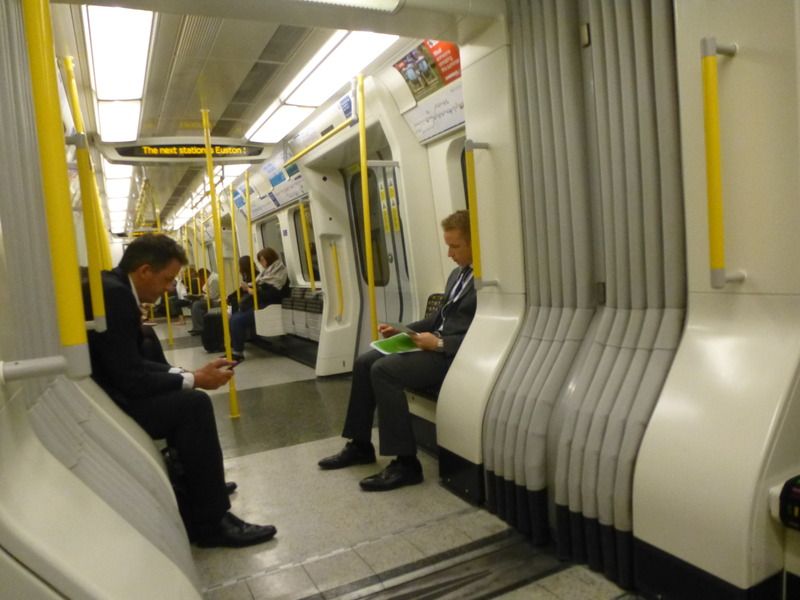
At St Pancras there was a long queue to get into the terminal – you scan your boarding pass at an automatic barrier which lets you into the security area, after which you clear Schengen immigration. There were too few scanners for the rush hour traffic and the backlog was considerable. The staff attempted to solve this problem by shouting at the passengers to hurry up. Yes it’s totally our fault that your facilities are inadequate. Though I’ve caught Eurostar to St Pancras several times, this was the first time I’ve departed from there. I took some photos of the departures area, part of the old St Pancras undercroft which was disused for years before the station was rebuilt in anticipation of Eurostar’s arrival.
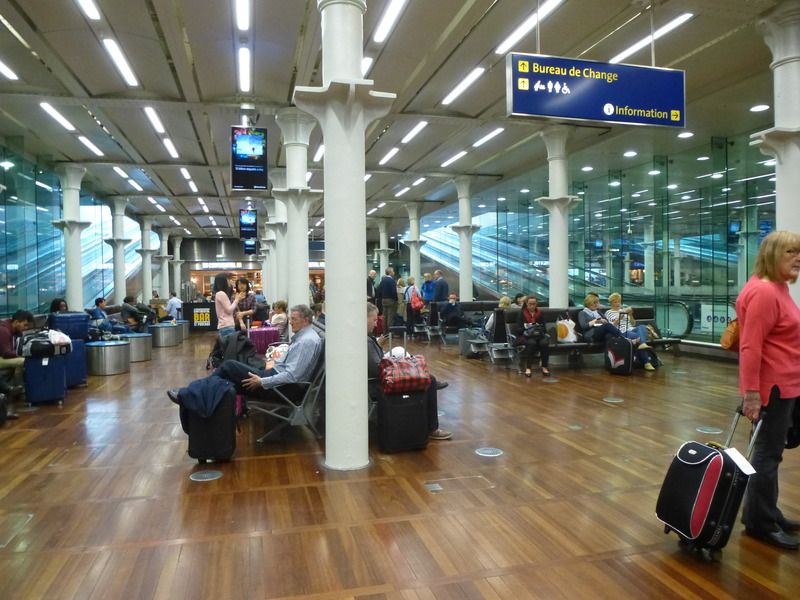
I was travelling to Brussels in Standard class. Eurostar also has Standard Premier and Business Premier – both of which use the old first class services but the later has priority check in/security, a lounge and better on-board catering. Standard has no catering included though there are two buffet cars where you can buy food and drinking. The train was quite busy but I had a pair of seats to myself which gave me plenty of room. Really though, the space is fine for the journey length unless you’re very large. Leg room is fairly generous.
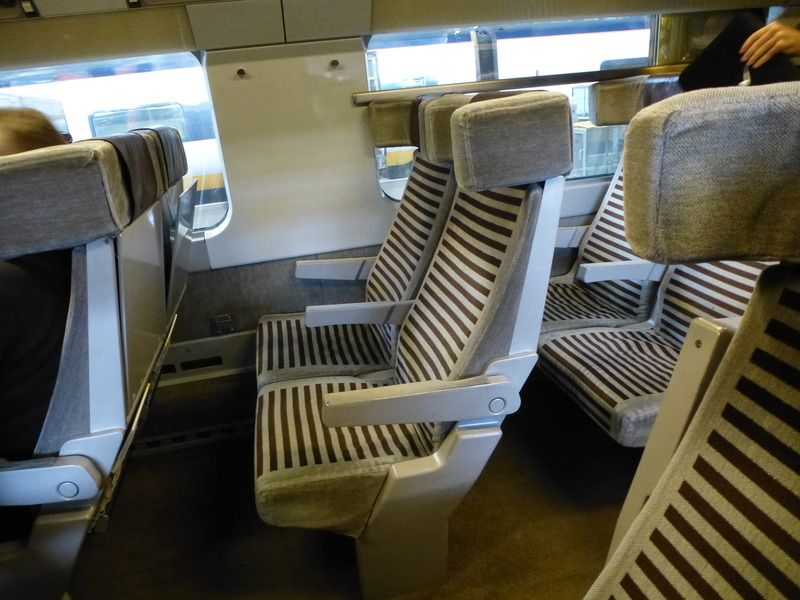
Eurostar should be getting new trains within the next few years. Some of these new trains are on trial and one of them was in the yard at Brussels. I missed photographing it but I had two hours at Brussels to take some photos of other stuff.
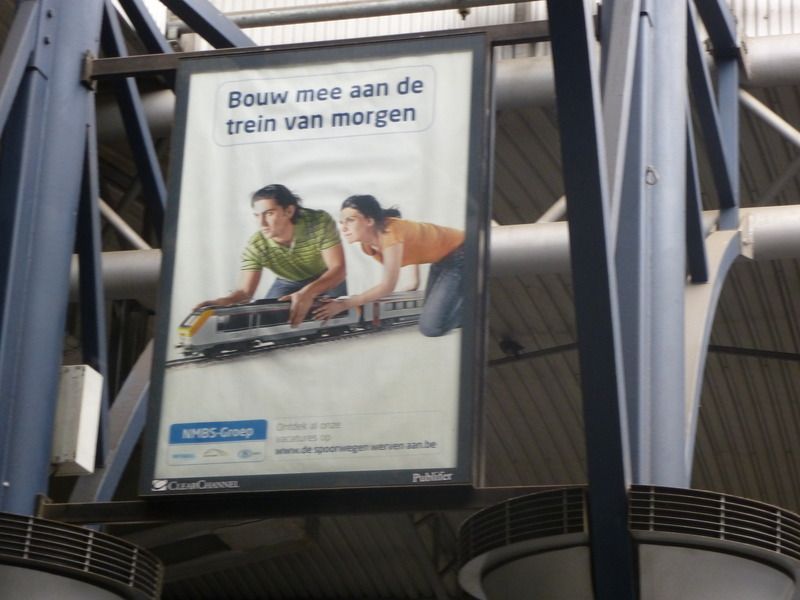
I also ate frites for lunch (mmm Belgian food) and got chatted up by a train cleaner. Having run out of diversions I went up onto the platform my train to Cologne was going to leave from. The train (a German ICE) arrived, the passengers got off and the cleaners got on. Two of them saw me waiting on the platform and waved. I waved back and there followed a bit of silly waving and play acting. When they finished cleaning one of them got off the train and came over for a chat. He was gorgeous but unfortunately we were lacking a common language so clearly a relationship with no future in it. We hugged and bid each other au-revoir. A pity really, my parent’s reaction would have been most entertaining.
The train departed exactly on time and whooshed us off to Cologne, arriving on time. This route is one of the few where the ICEs really feel like they’re going fast. I’d been to Cologne before but only as a 2 hour lunch stop between trains. So it was nice to have the whole evening to explore. It was also nice to have a comfort zone city to ease me into the trip.
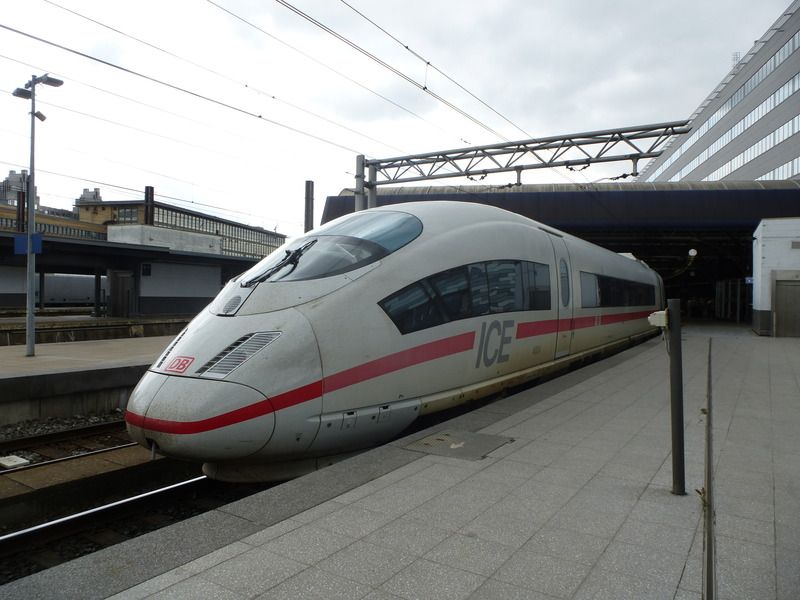
ICE second class seating

There was a lot of religious guidance on offer in Cologne, must be that cathedral

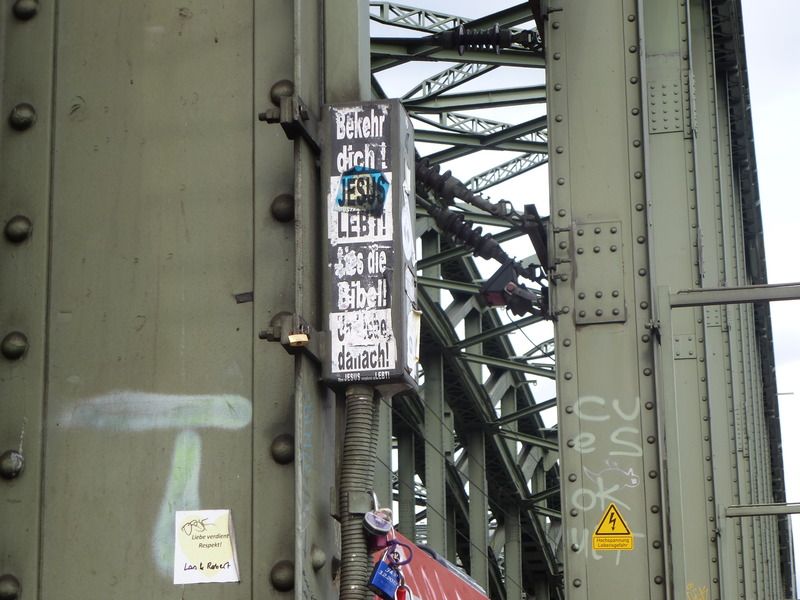
I was quite excited to find that I’d arrived during the spargelzeit – asparagus season. Seasonal food is a big thing in Germany and asparagus season is a major thing. I like the green asparagus we get in Britain and was looking forwards to trying the white stuff they serve in Germany. I compared the menus at various restaurants and eventually plumped for asparagus served with schnitzel, boiled potatoes and Hollandaise sauce.
Well sorry Germany but your asparagus is a pale imitation of the British stuff. It didn’t even make my pee smell funny.
CGN- SJJ on German Wings (4U)
The following morning I had time for another stroll around the cathedral and the Hohenzollern Brucke before catching the train to the airport. The airport service is operated by a typical S-Bahn train as can be found all over Germany.
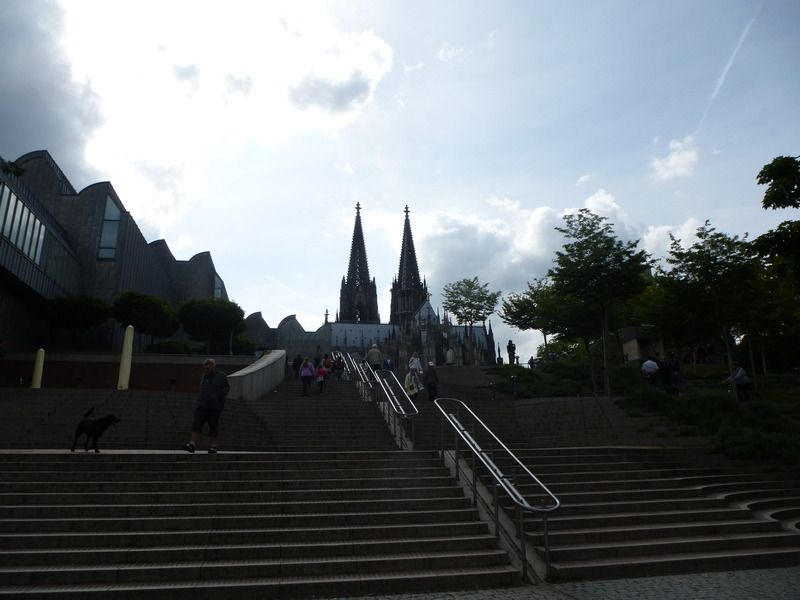

Considering that CGN is not a very large airport it seems to cover a huge amount of ground. I seemed to have walked for miles before I found the bag drop and then a fair way more to find the entrance to the secure area. Security was a pain in the arse. Not many passengers but a fair few staff standing idle. Trays not being recycled effectively. Laptops, I-pads and kindles out of bags. And body scanners (but take off your belt and empty your pockets before getting in). I would have preferred to avoid the body scanners but they were present in all lanes. Since I didn’t know the opt out procedures I decided to comply. Must research that for next time. Airside CGN turned out to be quite a nice airport with a reasonable variety of shops and some good tarmac views.
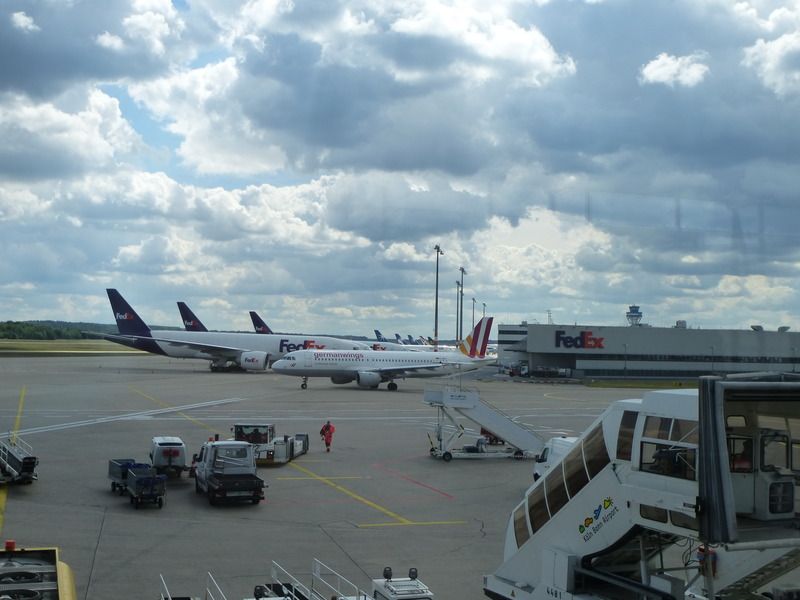
The chap manning Schengen exit controls was intrigued by my British passport? Do I live in Bosnia? In Germany? No, this was just convenient. He shrugs and sends me on my way. Here’s my plane waiting at the gate.
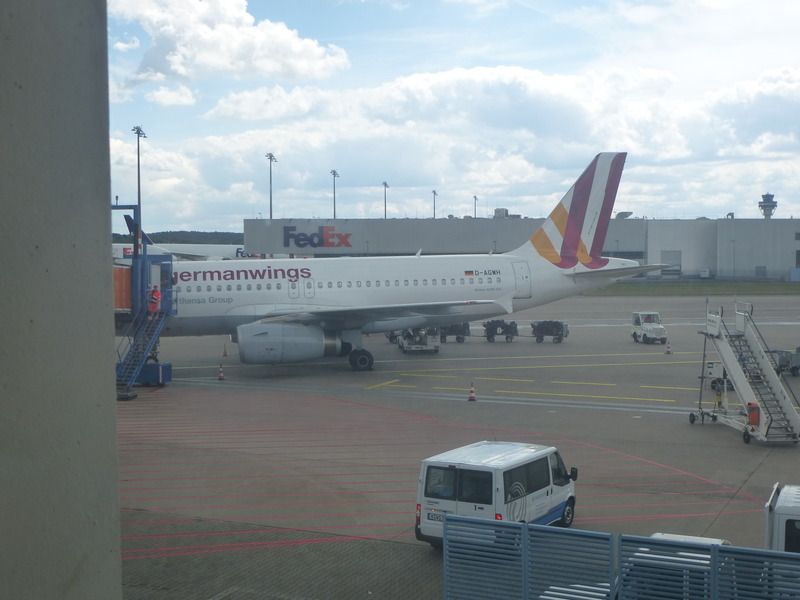
Boarding was quite swift and efficient though with no prioritisation except for disabled/elderly/young children. 4U offers three fare types: Basic – lo-co type ticket which buys you a seat on the plane and hand luggage, Smart which also includes a checked bag and an on-board snack and Best which promises fast track security and a ‘gourmet’ meal. As the holder of a smart ticket I got a seat in row 2, the first three rows have extra leg room and are not available to the holders of basic tickets.


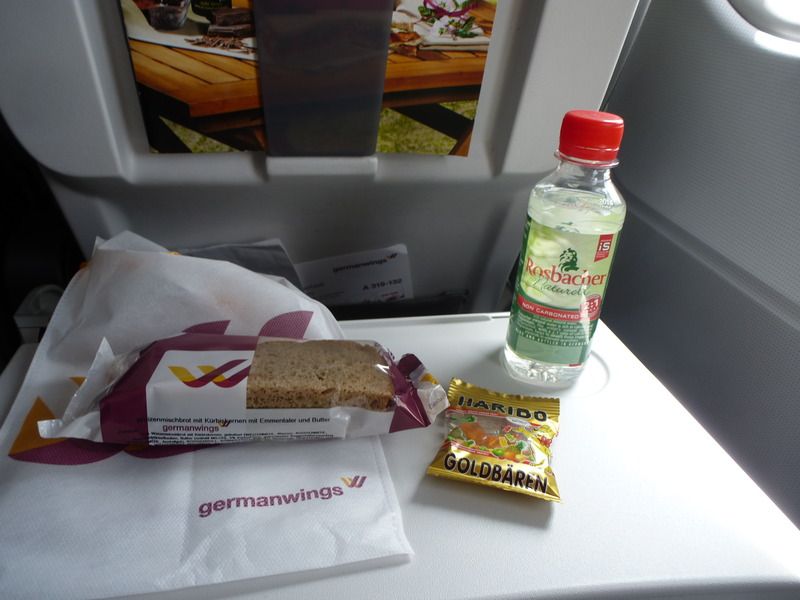
The snack was fairly pathetic but it tasted decent. Service was efficient and professional though not very warm. Communications from the cockpit were frequent and reassuring – and the pilots certainly had a job on their hands flying through the beautiful Bosnian mountains to Sarajevo.
Immigration at Sarajevo airport was fast and friendly. I was delighted to have a proper stamp in my passport at last, I’ve had it a few years but only used it to go in and out of Schengen which isn’t deemed stamp worthy. I do have a stamp from Brussels though, circumstances forgotten. I hauled my bag off the carousel, got some cash from the only ATM belonging to a bank I’d heard of, and headed out to the taxi rank. I was slightly nervous about this bit, I’d hoped the hotel would be able to pick me up but they couldn’t. They suggested a taxi and attached a warning note about the risks of being ripped off. So I agreed the price before leaving – 30 BAM the standard fare into the old town.
What I forgot to do was to check the condition of the car. Perhaps a vehicle with taped together wires hanging down should have been avoided?
The taxi driver swerved round the line of vehicles waiting to leave the airport and then swore at the woman who refused to let him cut in. He then accelerated towards the city. I feared for my underwear. Until I realised that most of the other drivers on the road were as bad or worse and that my guy, whilst insane, knew what he was doing. Which was mostly racing other motorists; including one intrepid learner. We reached my hotel and for the first time I was able to breathe in Sarajevo’s aroma of tobacco and barbecue and to hear its soundtrack of muezzins and Turkish pop music. Comfort zone exited.
Anyway onto the actual TR. Well more or less onto the TR because none of this was simple so I doubt the TR will be either. This trip had two starting points – F0zzyNUE announcing NUE DO 4 and my ambition to visit every country in Europe. The two were not obviously compatible since I’ve been to Germany multiple times already but where there’s a will (or, better still, a train) there’s a way. So what schemes were floating through my brain? Well as I recall…
Fly to somewhere in Italy, visit San Marino (new country), take train over the Brenner pass (new and beautiful bit of railway), hang out in Innsbruck (I’m kind of obsessed with Innsbruck) for a few days, then onto the Do.
The above plan but starting with flying to Croatia (new country) and taking a ferry to Italy.
Fly to either Ljubljana or Zagreb (new countries), take train through Austria, go to Do.
Go to Do then go home via Luxembourg.
Something involving Poland.
Fly to Sarajevo, take train to Zagreb then the overnight train to Munich and thus to the Do and home.
San Marino was rejected on the grounds that I didn’t feel like it, Luxembourg on the grounds of appearing to be both expensive and boring and Poland on the grounds that I have Big Plans for my trip there. With the dates for the Do announced it was time to go to my boss and beg for some holiday – once I knew how much holiday I’d got I could get on and do some Proper Planning. Except being a clever so and so I didn’t go to my boss. I went to my team leader, who was about to be de- team leadered owing to restructuring, and was thus happy to grant any wishes that might cause the company some inconvenience. Which meant my boss got a nice surprise when he actually got round to looking at the holiday diary some months later…
With enough holiday in hand to do what I wanted I decided on the Sarajevo/Zagreb/NUE Do combo. Around this time I fell in love with A Time of Gifts by Patrick Leigh Fermor and most especially his description of Ulm. Since Ulm was reasonably close to Nuremberg I decided I’d got there on my way home from the Do (well it is sort of on the way home, at least it lies west of Nuremberg). This would enable me to visit Friedrichshafen which I’d had my eye on since reading Corporate Wage Slave’s Trip Report http://www.flyertalk.com/forum/briti...hafen-fdh.html BA gave him a free ticket, presumably hoping that he would tell us all about it and inspire us to follow him there. Well that sort of happened, I just wasn’t going by plane. Sorry BA.
At this point my plans hit a bit of a snag. There are no direct flights from London to Sarajevo. Well I’d known about that in advance and thought I’d be able to buy a reasonably priced ticket via Zagreb. Time to get online and look for one…
YOU WANT HOW MUCH?
Ok so what other routings are there? Maybe via Istanbul, if I can squeeze a stopover that’ll be another country ticked off the list.
OH FOR GOODNESS SAKE, I COULD BUY A TICKET TO AUSTRALIA FOR THAT
There was only one reasonably priced option. LHR-CGN-SJJ on German Wings. Which sounds great apart from the 45 minute connection at CGN. And if I miss it the next flight is three days later. Hmm.
I wasted hours trying to find the minimum connection time at CGN; even Flyertalk didn’t hold the answer. I reached for a notepad and pen and did some maths – travelling out to Cologne the night before and overnight there before flying CGN-SJJ was still considerably cheaper than any other option. Oh look, there’s a cheap Eurostar ticket. Buy now and repent soonish because this trip is getting complicated…
29 May – Home (near Reading) to Cologne by train via London and Brussels, 1 night in Cologne
30 May – CGN-SJJ on German Wings, 3 nights in Sarajevo
2 June – Train from Sarajevo to Zagreb, 1 night in Zagreb
3 June – Overnight train from Zagreb to Munich
4 June - Morning train from Munich to Nuremberg. NUE Do, 3 nights in Nuremberg
7 June – Train to Ulm, 2 nights in Ulm
8 June – daytrip to Friedrichshafen
9 June – train from Ulm to home.
With the Euro plunging into the financial depths (and taking the Bosnian Mark and Croatian Kuna with it – they’re both pegged to it at fixed rates) I set about booking trains, hotels and that one flight. Which was a pain in the arse to book, thanks to the inadequacies of German Wing’s website.
You may be wondering why I undertook this trip alone – well apart from the NUE Do of course. Strangely enough nobody wanted to come. Goodness knows why not. Oh well, I like travelling on my own. I can do what I want when I want and eat whatever crap I like. But I wish I had a wingman to look after my luggage while I go to the loo. Oh yeah luggage.
#what happens when I take my family anywhere
At this point I would really like to insert that bit of Bon Voyage Charlie Brown where Charlie invites Snoopy to join him on the trip to France and Snoopy packs everything he owns. But I can’t find it. I also can’t find that song that’s played when they’re on the train from London to Dover which is # how I feel about travelling. So maybe you can all just go and watch the film? After you finish reading this TR obviously.
At this point I realise that I’ve written over 1000 words and I haven’t got as far as leaving home yet. So yeah, that...
Home- Cologne by train
My bags were packed, I’d emailed my itinerary to my parents (I live with them and me going away for this long is a novelty – I don’t travel for work) and my colleagues had despaired at my insanity (they’re a parochial lot - France, Spain, Italy and the USA aside, Abroad is very much a foreign place as far as they’re concerned). The cats were delighted by my 5am alarm. But it’s better than oversleeping. I got up, fed the cats, got dressed, fed the cats again, ate breakfast, went to the loo and gave the cats a third breakfast to get them out of the way whilst I locked them on one side of the front door and myself and my luggage on the other. The cats are fairly slim by the way; they stuff themselves in the morning but don’t eat much later in the day.
I walked down to the station, bought a ticket to London and jumped onto the train. The 0606 is the first train of the day and can occasionally be late/cancelled if the railway is having a bad day but today it was bang on time. I remembered not to get off at West Drayton (normally if I’m on the train with luggage I’m on my way to Heathrow and I get off at West Drayton to take the bus from there). I caught the tube from Paddington to St Pancras, in the past couple of years London Underground has acquired some shiny new trains which you can walk all the way through rather than being stuck in one carriage.

At St Pancras there was a long queue to get into the terminal – you scan your boarding pass at an automatic barrier which lets you into the security area, after which you clear Schengen immigration. There were too few scanners for the rush hour traffic and the backlog was considerable. The staff attempted to solve this problem by shouting at the passengers to hurry up. Yes it’s totally our fault that your facilities are inadequate. Though I’ve caught Eurostar to St Pancras several times, this was the first time I’ve departed from there. I took some photos of the departures area, part of the old St Pancras undercroft which was disused for years before the station was rebuilt in anticipation of Eurostar’s arrival.

I was travelling to Brussels in Standard class. Eurostar also has Standard Premier and Business Premier – both of which use the old first class services but the later has priority check in/security, a lounge and better on-board catering. Standard has no catering included though there are two buffet cars where you can buy food and drinking. The train was quite busy but I had a pair of seats to myself which gave me plenty of room. Really though, the space is fine for the journey length unless you’re very large. Leg room is fairly generous.

Eurostar should be getting new trains within the next few years. Some of these new trains are on trial and one of them was in the yard at Brussels. I missed photographing it but I had two hours at Brussels to take some photos of other stuff.

I also ate frites for lunch (mmm Belgian food) and got chatted up by a train cleaner. Having run out of diversions I went up onto the platform my train to Cologne was going to leave from. The train (a German ICE) arrived, the passengers got off and the cleaners got on. Two of them saw me waiting on the platform and waved. I waved back and there followed a bit of silly waving and play acting. When they finished cleaning one of them got off the train and came over for a chat. He was gorgeous but unfortunately we were lacking a common language so clearly a relationship with no future in it. We hugged and bid each other au-revoir. A pity really, my parent’s reaction would have been most entertaining.
The train departed exactly on time and whooshed us off to Cologne, arriving on time. This route is one of the few where the ICEs really feel like they’re going fast. I’d been to Cologne before but only as a 2 hour lunch stop between trains. So it was nice to have the whole evening to explore. It was also nice to have a comfort zone city to ease me into the trip.

ICE second class seating

There was a lot of religious guidance on offer in Cologne, must be that cathedral


I was quite excited to find that I’d arrived during the spargelzeit – asparagus season. Seasonal food is a big thing in Germany and asparagus season is a major thing. I like the green asparagus we get in Britain and was looking forwards to trying the white stuff they serve in Germany. I compared the menus at various restaurants and eventually plumped for asparagus served with schnitzel, boiled potatoes and Hollandaise sauce.
Well sorry Germany but your asparagus is a pale imitation of the British stuff. It didn’t even make my pee smell funny.
CGN- SJJ on German Wings (4U)
The following morning I had time for another stroll around the cathedral and the Hohenzollern Brucke before catching the train to the airport. The airport service is operated by a typical S-Bahn train as can be found all over Germany.


Considering that CGN is not a very large airport it seems to cover a huge amount of ground. I seemed to have walked for miles before I found the bag drop and then a fair way more to find the entrance to the secure area. Security was a pain in the arse. Not many passengers but a fair few staff standing idle. Trays not being recycled effectively. Laptops, I-pads and kindles out of bags. And body scanners (but take off your belt and empty your pockets before getting in). I would have preferred to avoid the body scanners but they were present in all lanes. Since I didn’t know the opt out procedures I decided to comply. Must research that for next time. Airside CGN turned out to be quite a nice airport with a reasonable variety of shops and some good tarmac views.

The chap manning Schengen exit controls was intrigued by my British passport? Do I live in Bosnia? In Germany? No, this was just convenient. He shrugs and sends me on my way. Here’s my plane waiting at the gate.

Boarding was quite swift and efficient though with no prioritisation except for disabled/elderly/young children. 4U offers three fare types: Basic – lo-co type ticket which buys you a seat on the plane and hand luggage, Smart which also includes a checked bag and an on-board snack and Best which promises fast track security and a ‘gourmet’ meal. As the holder of a smart ticket I got a seat in row 2, the first three rows have extra leg room and are not available to the holders of basic tickets.



The snack was fairly pathetic but it tasted decent. Service was efficient and professional though not very warm. Communications from the cockpit were frequent and reassuring – and the pilots certainly had a job on their hands flying through the beautiful Bosnian mountains to Sarajevo.
Immigration at Sarajevo airport was fast and friendly. I was delighted to have a proper stamp in my passport at last, I’ve had it a few years but only used it to go in and out of Schengen which isn’t deemed stamp worthy. I do have a stamp from Brussels though, circumstances forgotten. I hauled my bag off the carousel, got some cash from the only ATM belonging to a bank I’d heard of, and headed out to the taxi rank. I was slightly nervous about this bit, I’d hoped the hotel would be able to pick me up but they couldn’t. They suggested a taxi and attached a warning note about the risks of being ripped off. So I agreed the price before leaving – 30 BAM the standard fare into the old town.
What I forgot to do was to check the condition of the car. Perhaps a vehicle with taped together wires hanging down should have been avoided?
The taxi driver swerved round the line of vehicles waiting to leave the airport and then swore at the woman who refused to let him cut in. He then accelerated towards the city. I feared for my underwear. Until I realised that most of the other drivers on the road were as bad or worse and that my guy, whilst insane, knew what he was doing. Which was mostly racing other motorists; including one intrepid learner. We reached my hotel and for the first time I was able to breathe in Sarajevo’s aroma of tobacco and barbecue and to hear its soundtrack of muezzins and Turkish pop music. Comfort zone exited.
#3
Original Poster
Join Date: Jul 2011
Location: LHR- ish
Programs: MUCCI, BA Blue
Posts: 4,295
Thanks. Here is the second installment.
I spent my first evening in Sarajevo wandering around the old town, most of which dates from the sixteenth century in which Ottoman Sarajevo flourished under the leadership of Gasi-Husrevbey who oversaw the construction of: the main mosque, a madrassa which taught both secular and religious subjects, bazaars, hotels for travellers, and a water and sewerage system which included some of the world’s first public toilets.
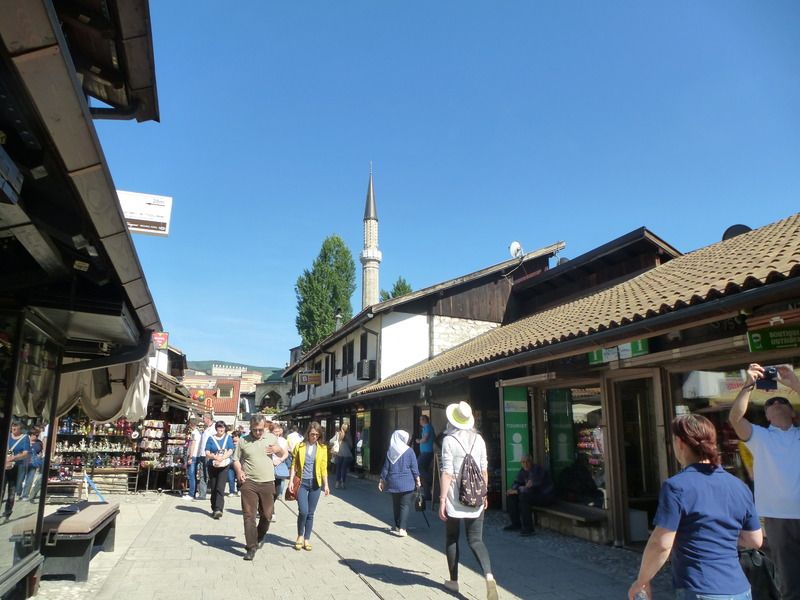
Pigeon Square
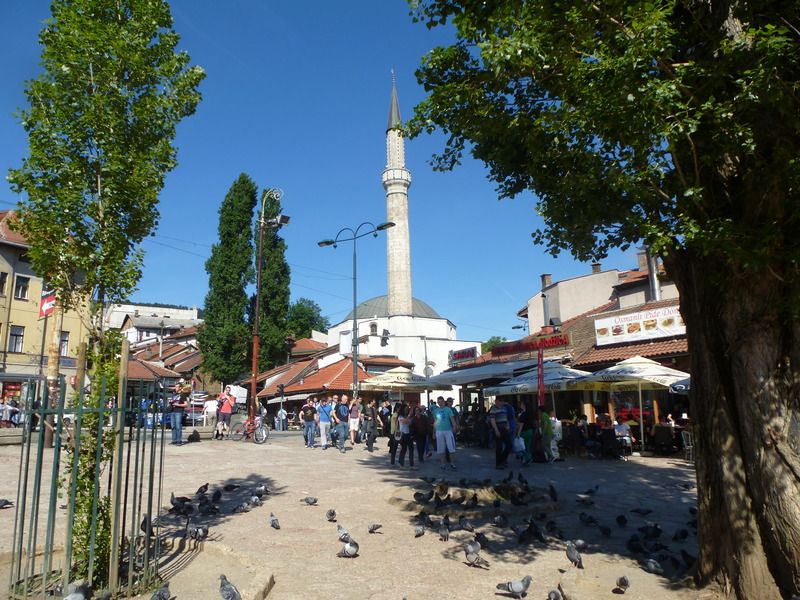

Souvenirs
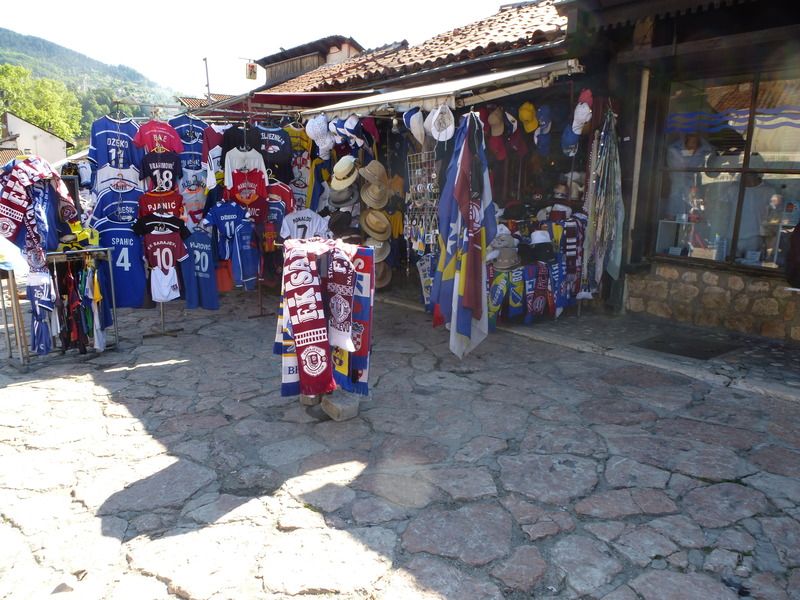
Husrevbey Mosque:
Prayer mats
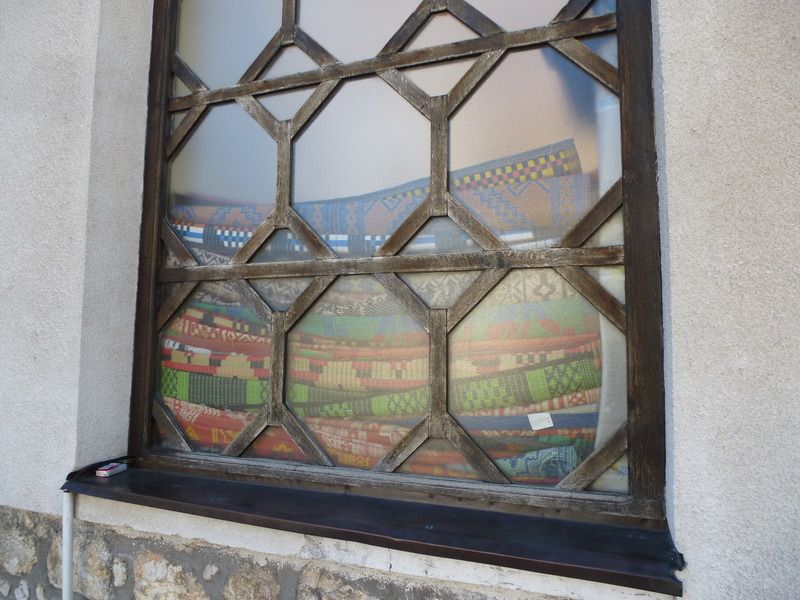
Prayer times
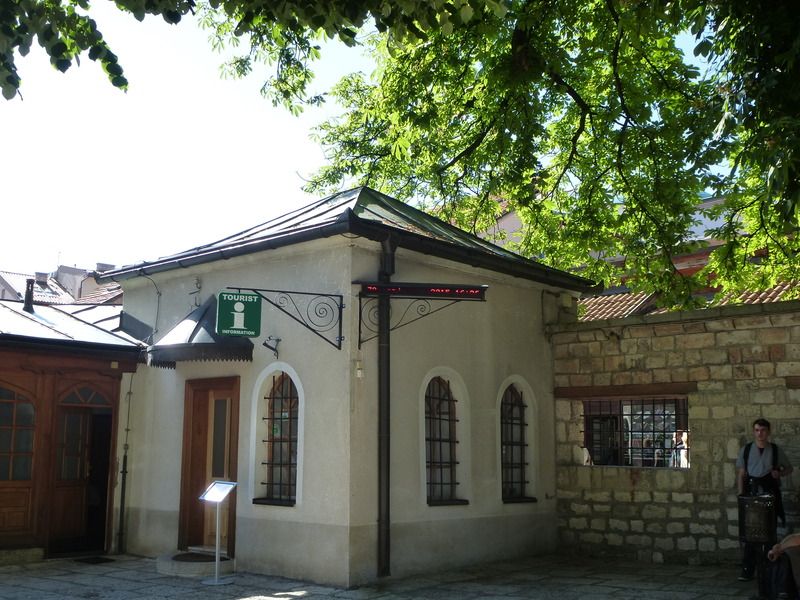
Pray-ers
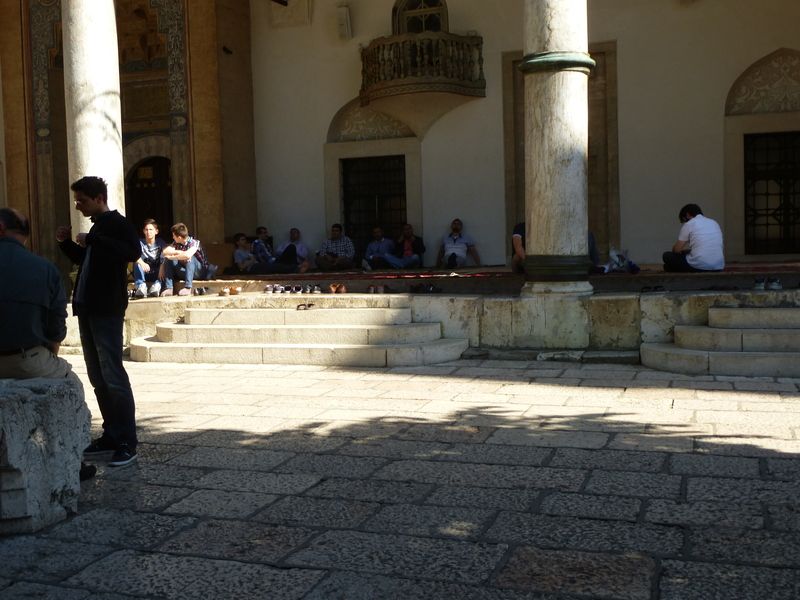
Newer bit of town
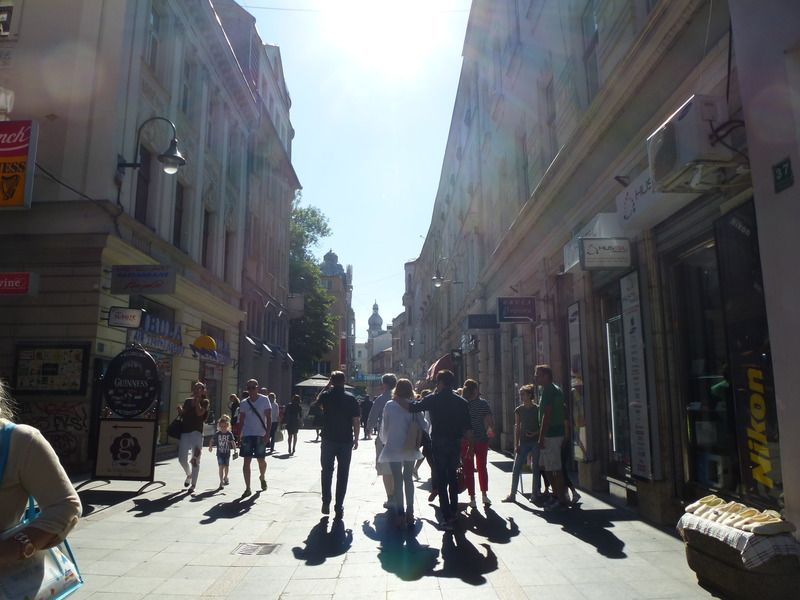
Old and new
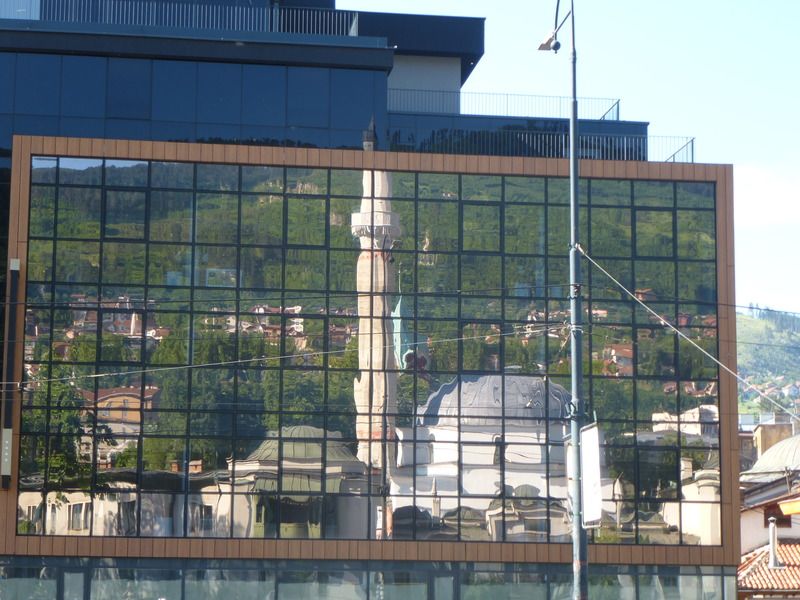
For dinner I had my first taste of Cevapi, Bosnian sausages served with flat bread, sour cream and raw onions. Yummy. I ate a lot of Cevapi whilst in Sarajevo, as well as the tasty (and cheap) ice cream on sale in the city. I also tried Burek which is a pastry roll with seasoned meat inside – sort of like a pie.
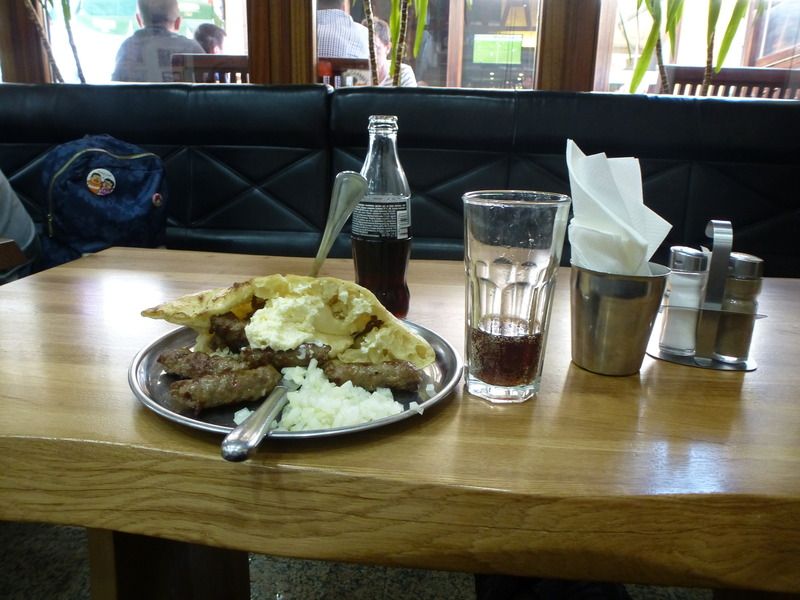
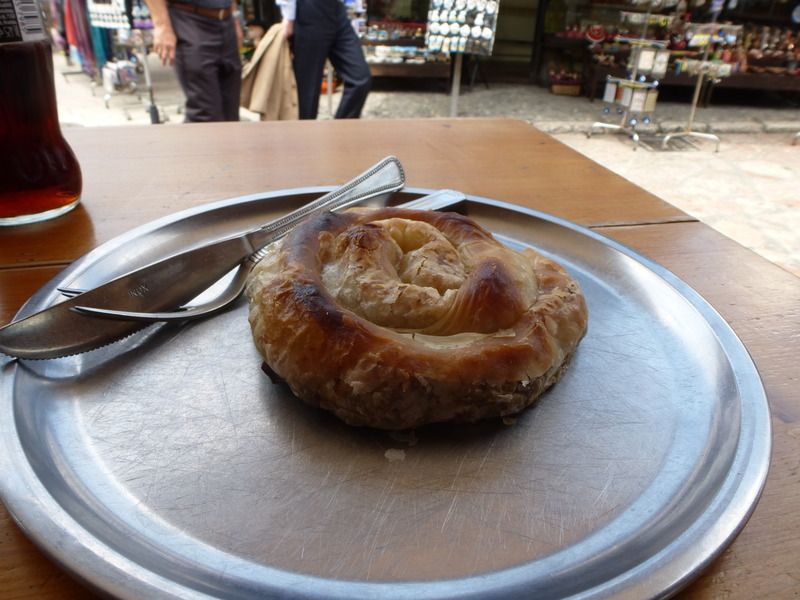
A quick word on pricing – Sarajevo is pretty cheap. The Cevapi pictured above plus 2 cokes cost 13.5 BAM, ice cream is 1 BAM per scoop, coffee about 2 BAM. When I went £1 was worth 2.75 BAM and I could buy dinner for under £5 provided I didn’t want anything too fancy. I think big steaks were around 20-25 BAM. Museum entry was generally around 3 BAM and a tram ticket is 1.80 BAM.
The following morning I went for a proper look around the Madrassa, which is a very beautiful building indeed, Gasi-Husrevbey used the finest architects available in constructing the town. He also specified how many staff each of the facilities he built should have and those statutes are still followed today. I saw one young staff member at work but he was rather shy when I wanted to photograph him.
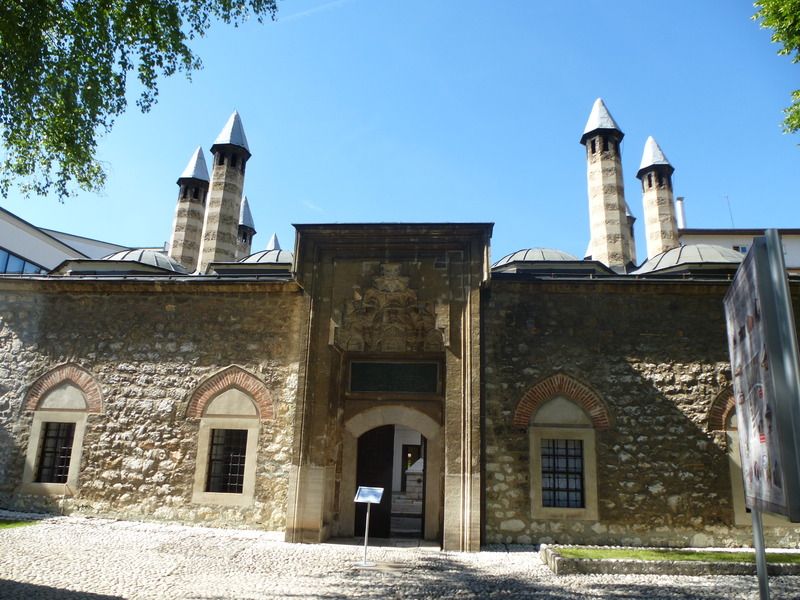
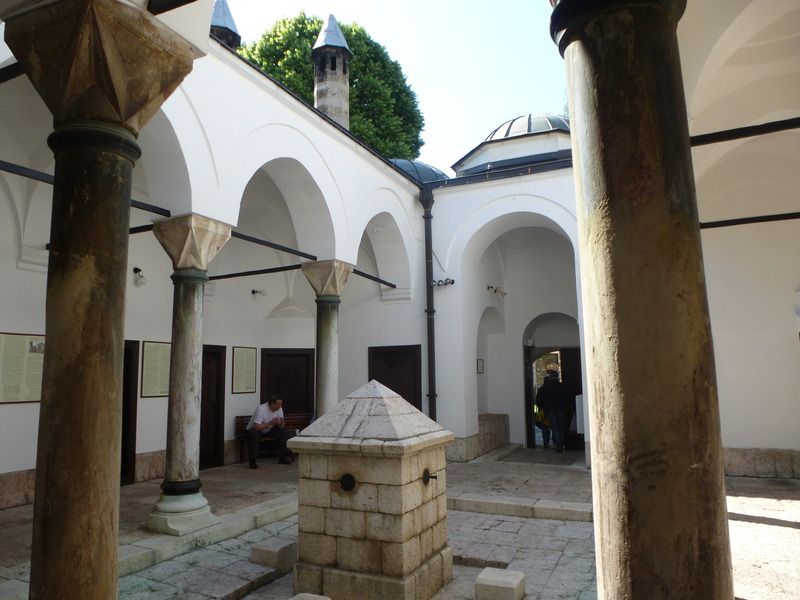
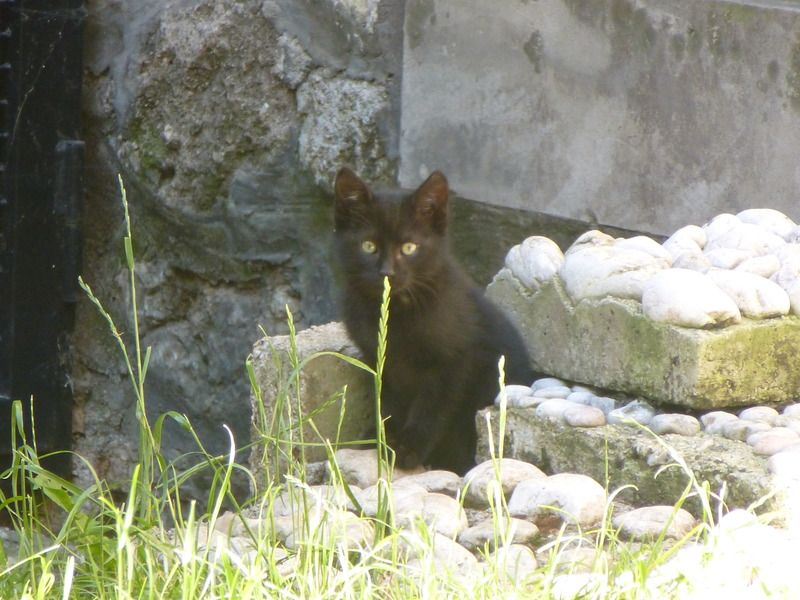
I followed this with Insider Tour’s ‘Times of Trouble’ tour which was supposed to last 3 hours but ended up lasting rather longer. Sarajevo’s public transport is a bit iffy so guided tours are the best way to explore outside the city centre. Our guide was Jiri, veteran of the siege of Sarajevo in which he served as a policeman and as a porter at the famous siege tunnel. Our first stop was the White Bastion which has commanding views over the city and was used by the Bosnian army for storage and surveillance during the siege. It is located in Vratnik, Sarajevo’s original city centre before it outgrew its hilltop location and spread down into the valley below.
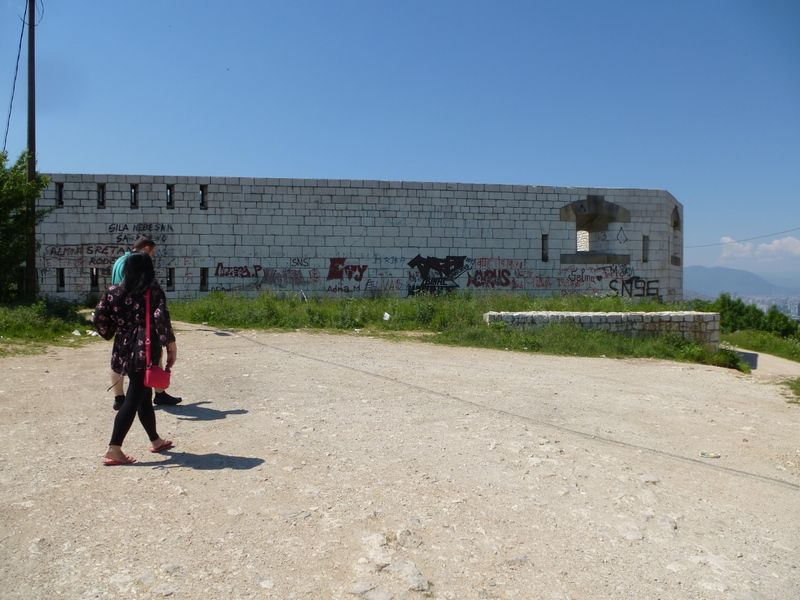


From here we moved onto Kovaci cemetery which holds the graves of many of the Bosnian soldiers killed in the siege. It also holds the grave of Bosnia’s wartime president Alija Izetbegovic who asked to be buried amongst the soldiers that had won him his country. Next to the cemetery is a half built mosque, Libya was paying for it until Gaddafi got overthrown.
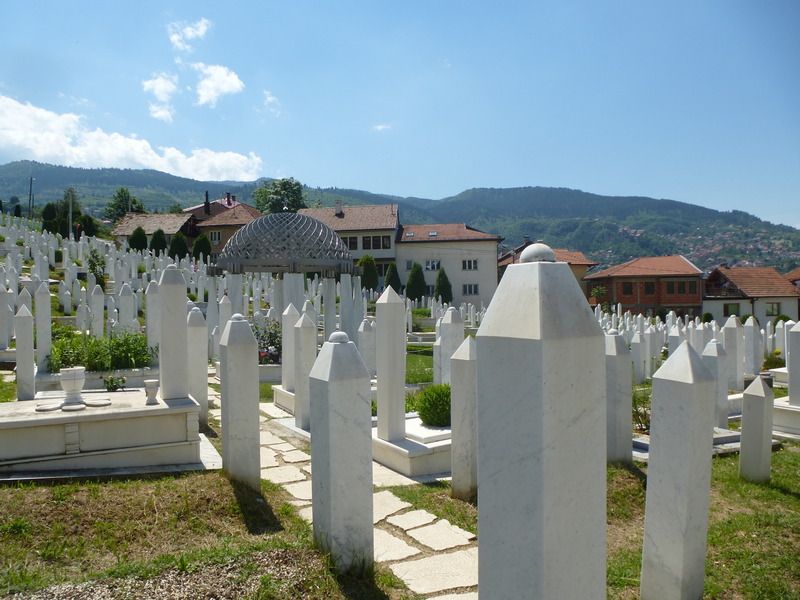
From here we moved onto the Olympic Park. Jiri was 10 when the Olympics came to town, the ideal age to enjoy them. He turned 18 a couple of weeks before the siege started – the ideal age for that too. There is a wartime graveyard in one of the stadiums, the citizens of Sarajevo were unable to reach the official cemetery during the siege and so were forced to bury the victims in parks and sports grounds.

We drove past the huge American Embassy (I think it’s the third largest in the world) and Sarajevo’s railway station which is rather forlorn but stands opposite a gleaming new skyscraper which belongs to some government high-up. Jiri suggested that neither its construction nor ownership was entirely legal. He gave us a brief explanation of Bosnia’s highly complicated politics. There are general elections every two years and each of the three provinces that make up Bosnia and Hercegovina elects its own president – there is no national president. There are hundreds of political parties and may be thousands of candidates for the presidential seats. The country is sub-divided into 14 administrative regions which also have their own elected officials and government apparatus. All this means that Bosnia employs huge numbers of civil servants, their wages are much higher than those in the private sector but you have to pay a bribe to secure a civil service job and may well be sacked when whoever employed you loses their political position. Jiri was offered a job as a postman a few years ago but was unable to pay the 1000 Euro bribe required.
Our route to the Tunnel Museum also took us past the city’s large new mosque, paid for by the government of Malaysia. Apparently this too involved a certain amount of bribery and other illegality… Outside the Tunnel Museum three flags were flying. They are the modern flag of Bosnia, the medieval flag on which the modern flag is based and the arms of the Bosnian army. These three flags are frequently seen together. The museum also had a ‘Sarajevo Rose’ which is a paint marker commemorating a place where people were killed in the siege.
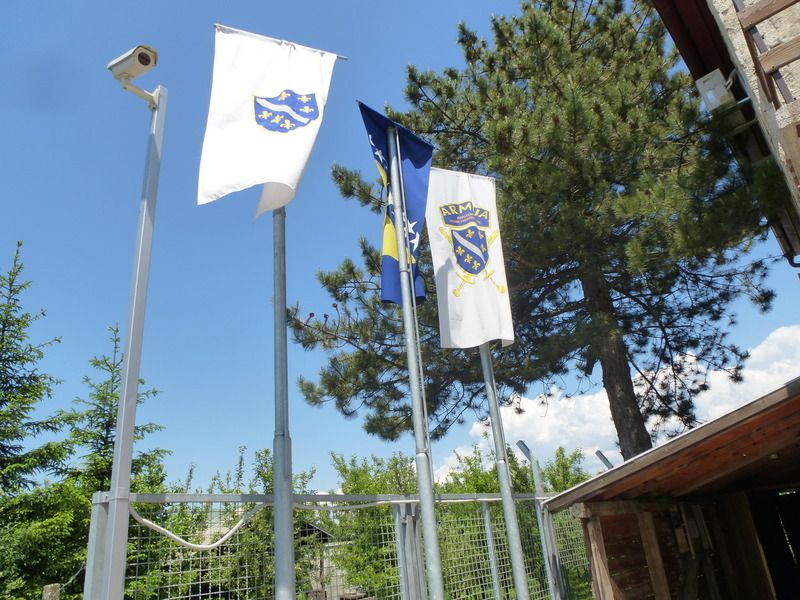
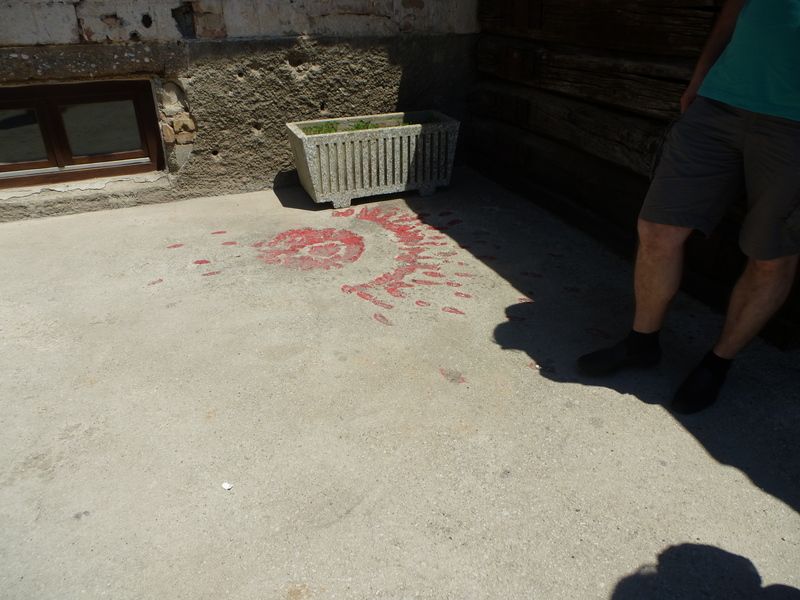
Once inside the museum we were shown a map explaining the siege of Sarajevo. It made it very clear that the only way into the city was via the airport - all other approaches were blockaded by Serbian forces.
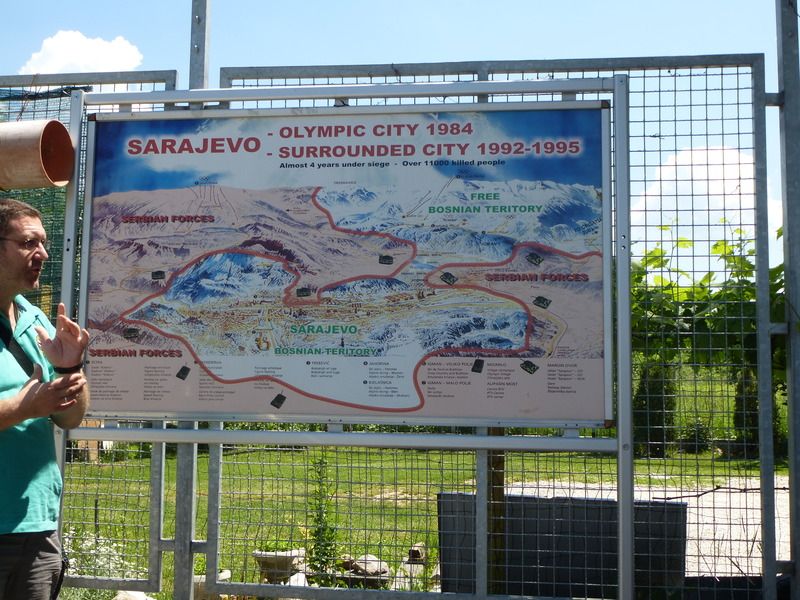
Thus the Bosnian forces inside and outside the city made a decision to dig a tunnel under the airport runway through which supplies could be passed. I took this picture which gives some idea of how long the tunnel is.
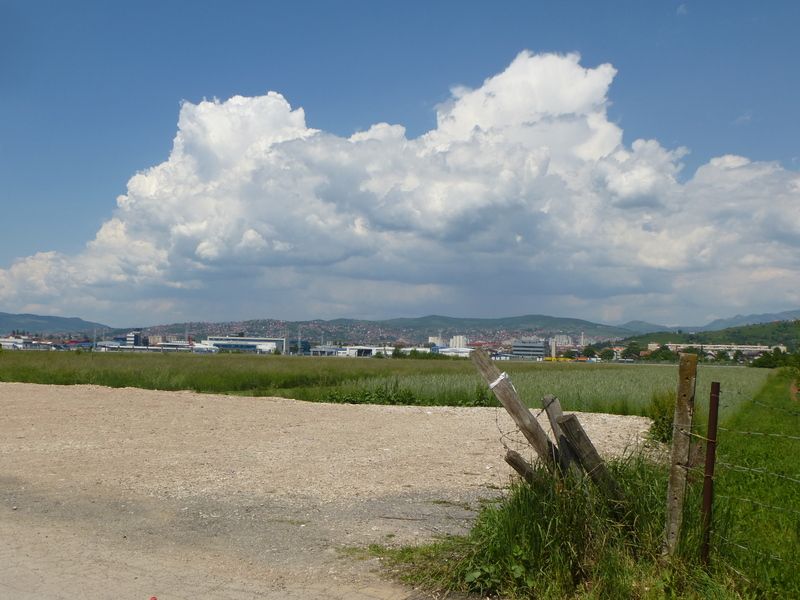
I asked how they got into the tunnel without being observed – the house the entrance stands in is on quite an exposed road. Jiri explained that officially the Serbs never knew the tunnel existed but that unofficially they were probably being bribed not to know where it was – prices were high in the city making it a lucrative market for black marketeers who paid 25000 Deutschmarks to rent the tunnel for two hours and were presumably also paying the Serbs in order to be able to bring their goods to it.
The museum is situated at the tunnel end away from the town. Jiri explained that he would often do 7 consecutive trips through the tunnel, which is about 800m long, on each occasion carrying a load of around 40kg on his back and a crate of eggs, or something similar, in his hands. He said that the siege was not won by the soldiers and police alone. He also praised the medics who stayed in the city saving lives despite the constant shelling and lack of supplies. On one occasion Jiri was hit in the leg, he discharged himself from hospital after a couple of days because he couldn’t bear to listen to the screams of those being treated without anaesthetic. The siege of Sarajevo lasted 1425 days and killed 13952 people.
From here we drove back into town along ‘Sniper alley’ and past some of the bridges over the Miljacka River. The most famous of these bridges is the one where the Archduke Franz Ferdinand and his wife Sophia were assassinated in 1914, precipitating the outbreak of the First World War, but nowadays many of them carry the names of people who were killed crossing them during the siege.
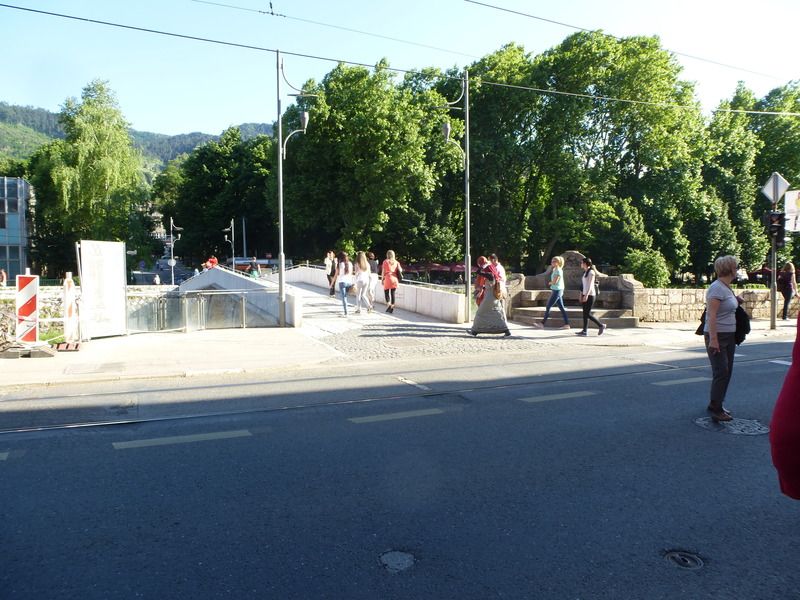
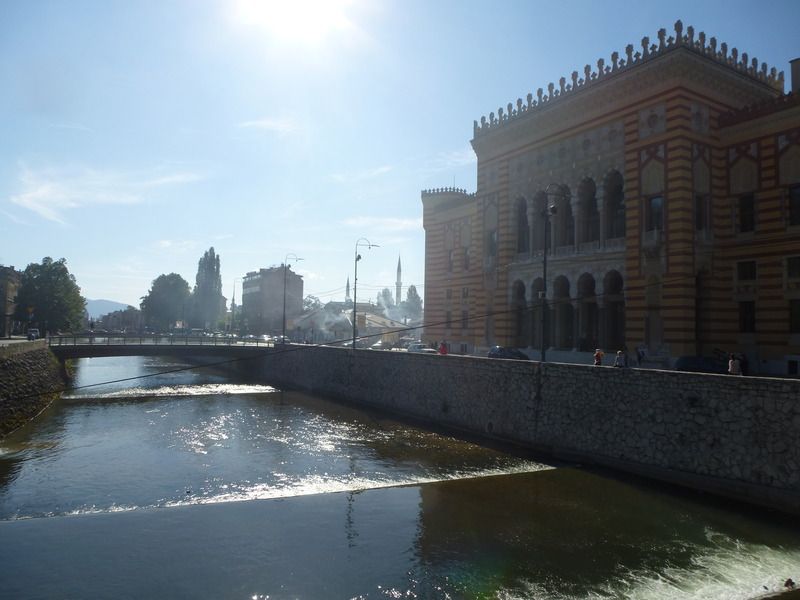
We also went to the Bobsleigh track which isn’t included in the tour – we had to pay extra. It was the most expensive facility built for the games and is now unusable. There are holes in the concrete and the insulation is falling off or has things growing in it. For me it was one of the most evocative places we visited, a true reminder of what might have been had Yugoslavia’s breakup not been so violent. It also seemed strangely alive, it was easy to imagine the sleds and the crowds.
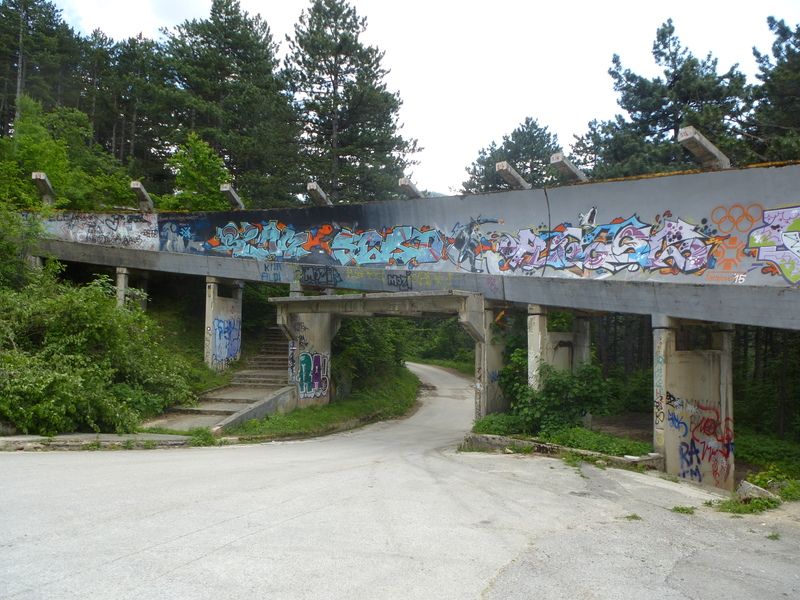
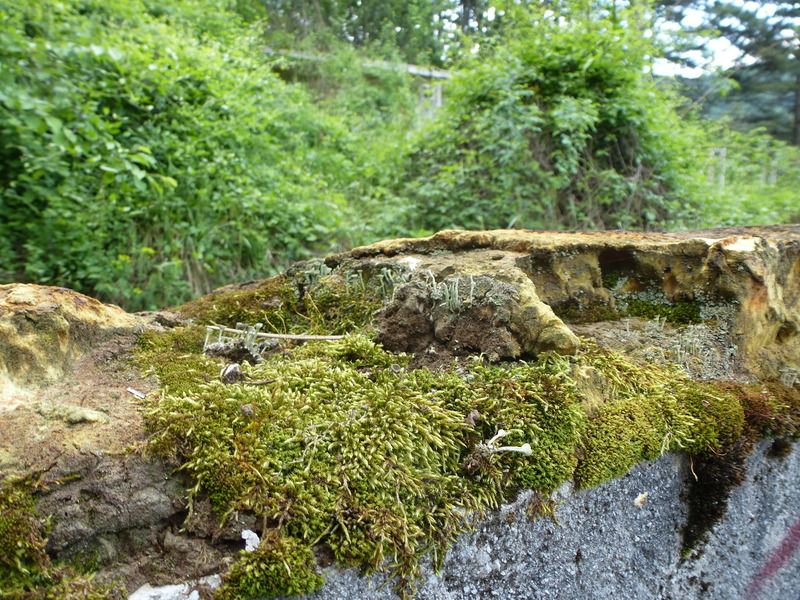
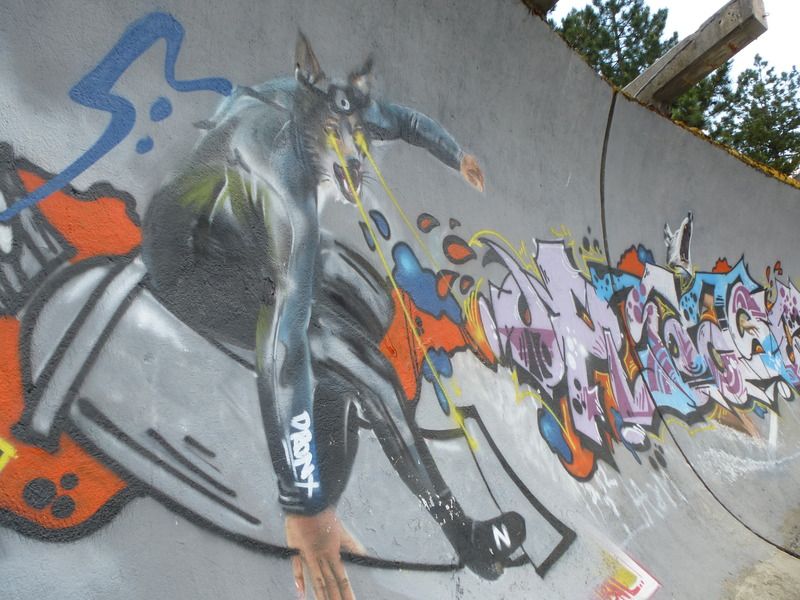
Our final stop was a panoramic restaurant which was heavily damaged during the war.
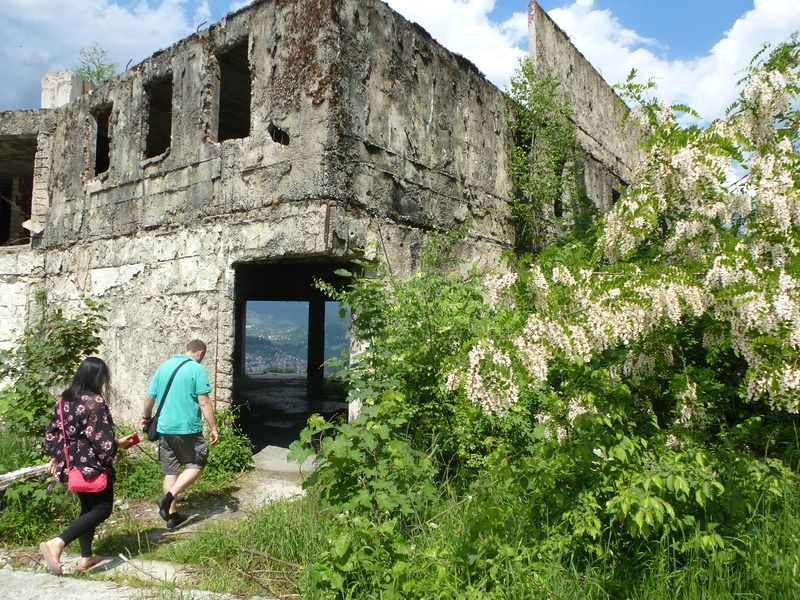
After the tour I went for a wander round the town.
Graffiti
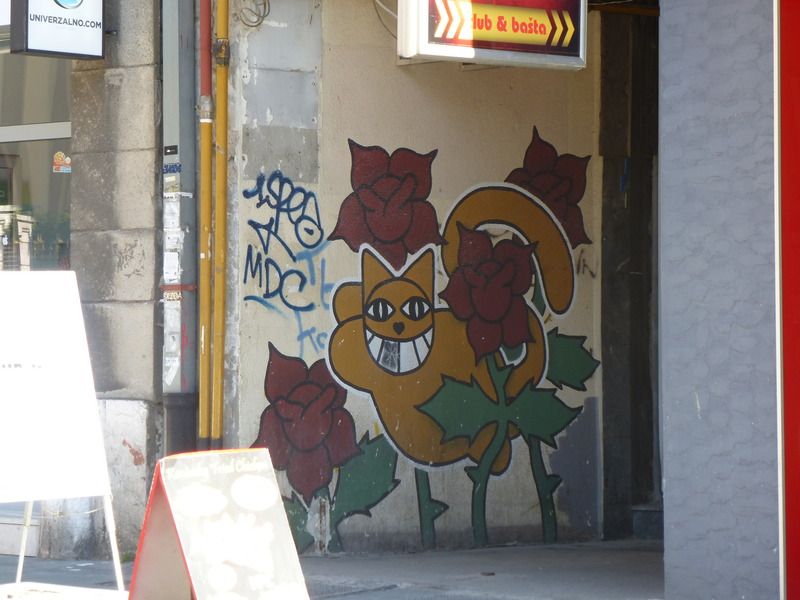
Eternal flame (people were queueing up to have their picture taken with it)
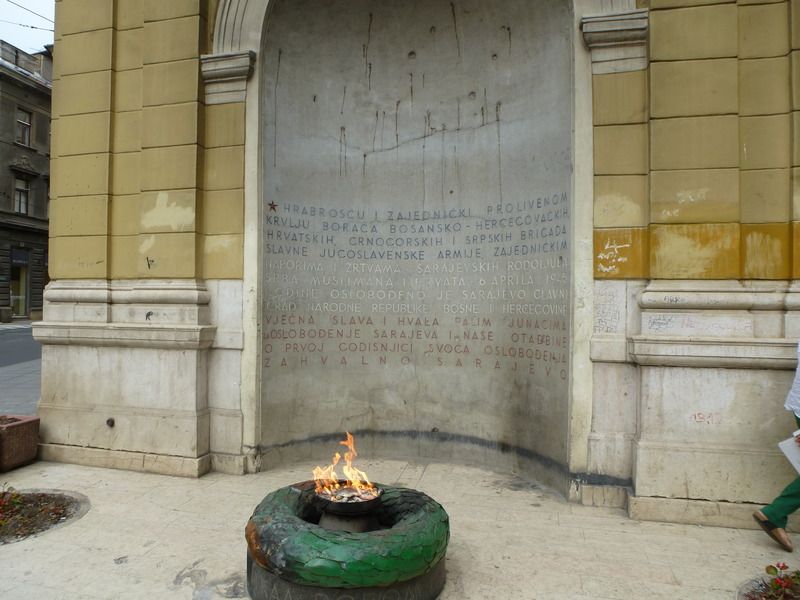
Memorial flowers, though I saw many plaques marking places where people had been killed this was the only one I saw with floral tributes on it.
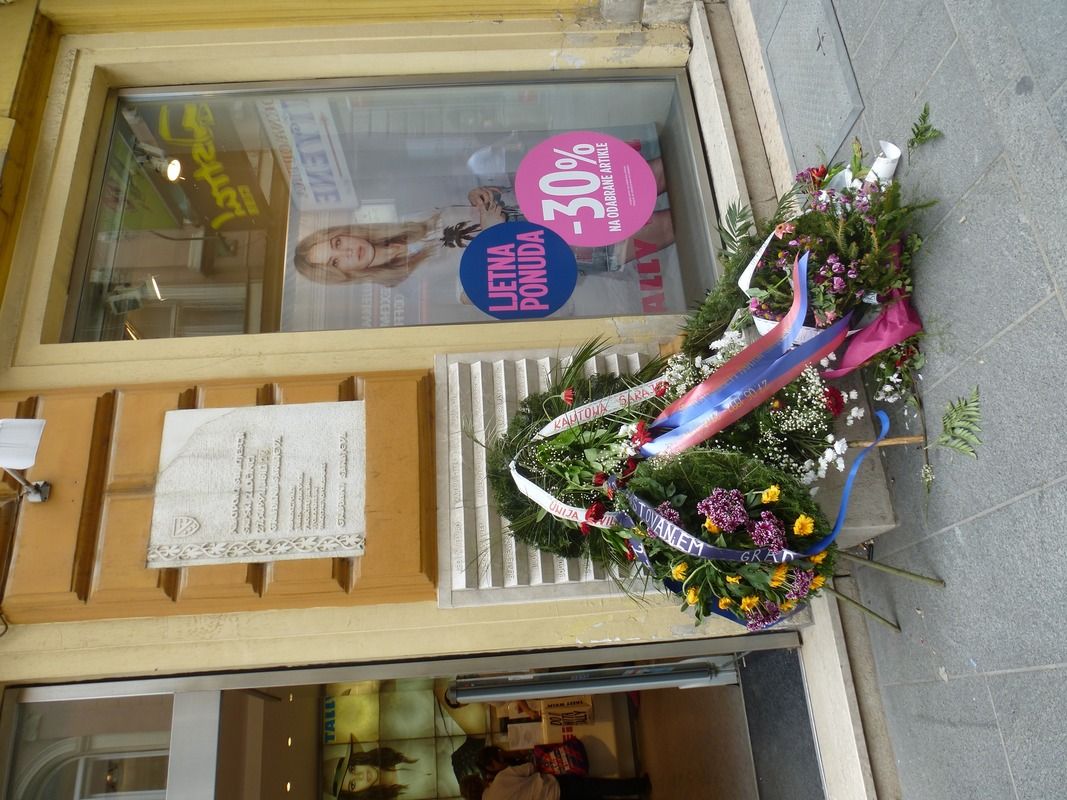
I attracted the attentions of a man in his 60s, or so, wearing an old army uniform. He tried to thrust a piece of paper into my hand and I had a great deal of trouble explaining to him that I don’t speak Bosnian. I wish I did because the piece of paper had a photo of somebody, a list of dates either side of the Second World War and a long description. I would love to know who this forgotten hero was – or maybe he is a national hero and the man in the camouflage thinks he shouldn’t be.
Unfortunately man in camouflage was rather persistent and I could only get rid of him by shouting at him in Russian. Which is quite good going for a language I only speak 4 words of.
That night I decided to take some pictures of the city in the dark (one of the things FT has inspired me to do is work harder at photography). All these images were taken without flash – ambient light only.
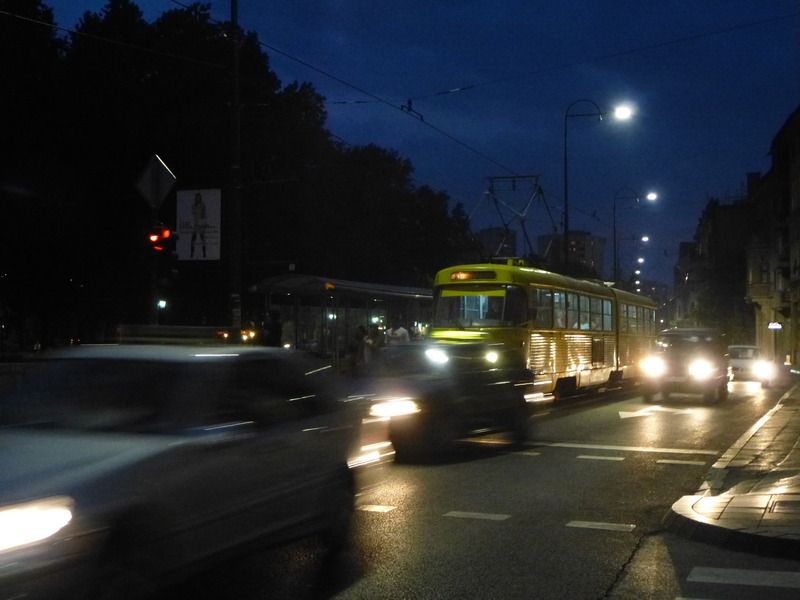
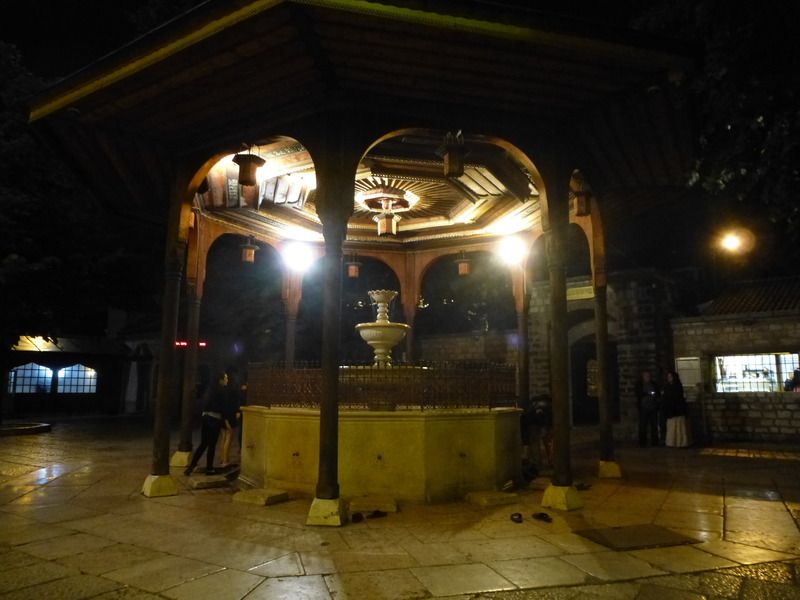

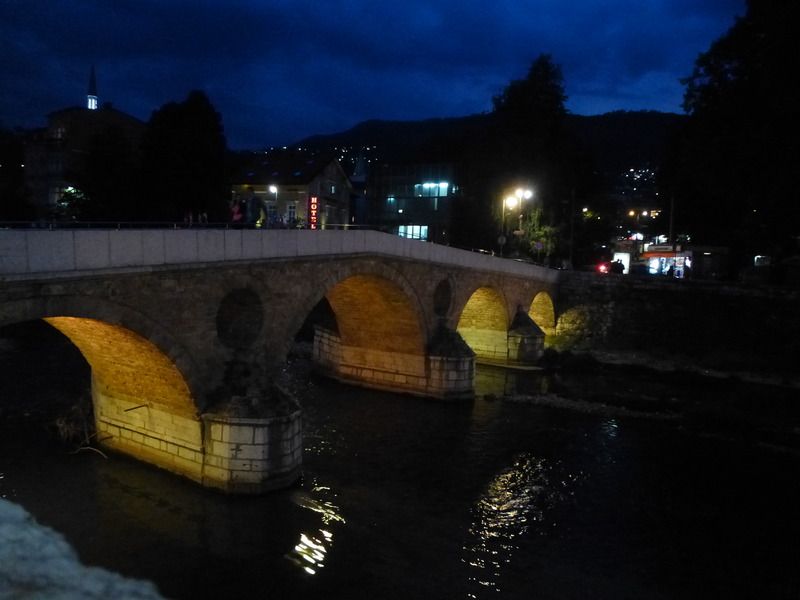
My last full day in Sarajevo began with a trip to the railway station to buy a train ticket to Zagreb. My ticket was handwritten onto the official ticket stock, I’m not holding my breath for online ticketing to become available any time soon. The ticket cost about 60 BAM. I took a few pictures of the station where photography is officially forbidden. Sarajevo’s rail service came to a sudden and violent halt on the first day of the siege and did not resume until 2006.
The tram was in an interesting condition.
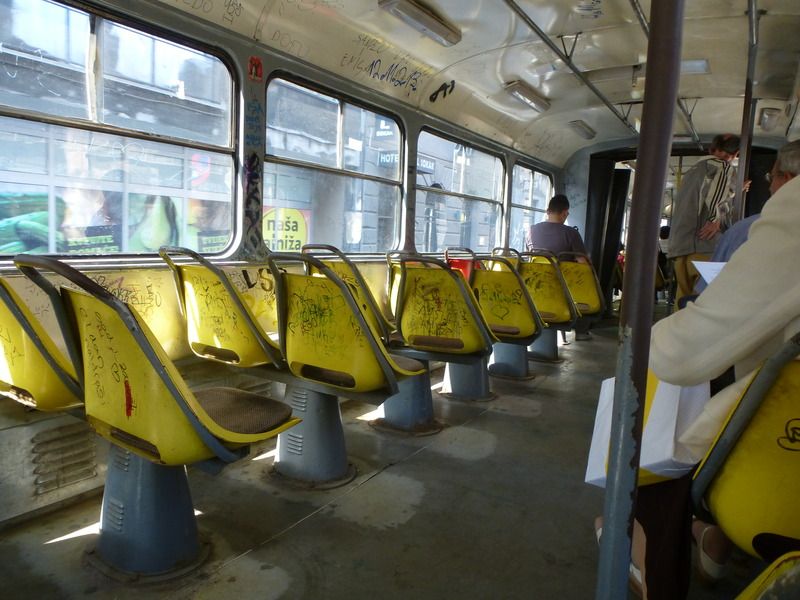
Railway station
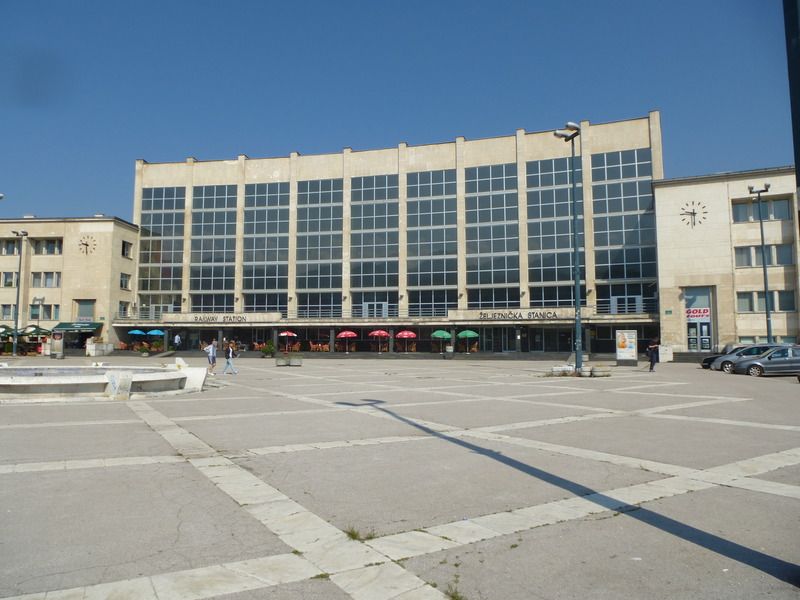
I spent the rest of the day visiting various museums and also the Orthodox Church which is beautiful inside and has a wine bar in the courtyard. I also walked up the river away from the city centre.
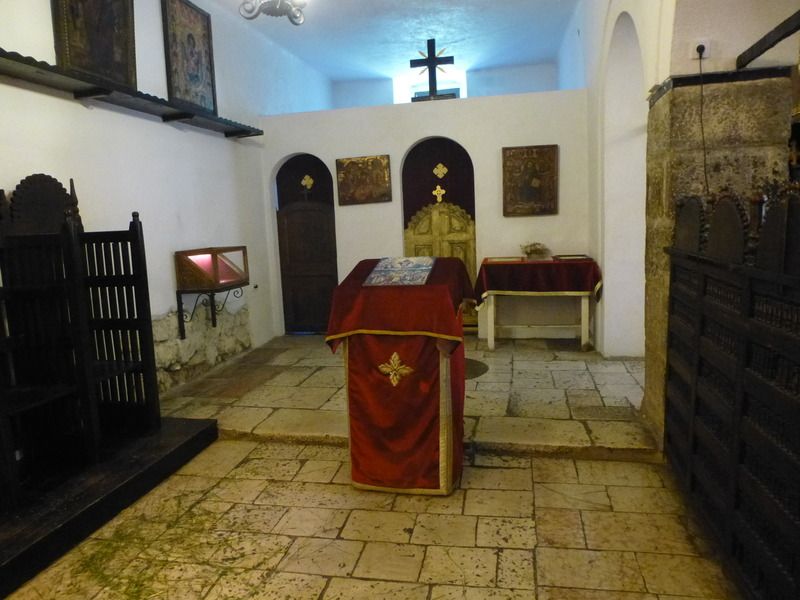

Overall I thoroughly enjoyed Sarajevo and I would love to return to Bosnia. Whilst surprisingly tourist infested, it is a beautiful country with friendly people.
Sarajevo
I spent my first evening in Sarajevo wandering around the old town, most of which dates from the sixteenth century in which Ottoman Sarajevo flourished under the leadership of Gasi-Husrevbey who oversaw the construction of: the main mosque, a madrassa which taught both secular and religious subjects, bazaars, hotels for travellers, and a water and sewerage system which included some of the world’s first public toilets.

Pigeon Square


Souvenirs

Husrevbey Mosque:
Prayer mats

Prayer times

Pray-ers

Newer bit of town

Old and new

For dinner I had my first taste of Cevapi, Bosnian sausages served with flat bread, sour cream and raw onions. Yummy. I ate a lot of Cevapi whilst in Sarajevo, as well as the tasty (and cheap) ice cream on sale in the city. I also tried Burek which is a pastry roll with seasoned meat inside – sort of like a pie.


A quick word on pricing – Sarajevo is pretty cheap. The Cevapi pictured above plus 2 cokes cost 13.5 BAM, ice cream is 1 BAM per scoop, coffee about 2 BAM. When I went £1 was worth 2.75 BAM and I could buy dinner for under £5 provided I didn’t want anything too fancy. I think big steaks were around 20-25 BAM. Museum entry was generally around 3 BAM and a tram ticket is 1.80 BAM.
The following morning I went for a proper look around the Madrassa, which is a very beautiful building indeed, Gasi-Husrevbey used the finest architects available in constructing the town. He also specified how many staff each of the facilities he built should have and those statutes are still followed today. I saw one young staff member at work but he was rather shy when I wanted to photograph him.



I followed this with Insider Tour’s ‘Times of Trouble’ tour which was supposed to last 3 hours but ended up lasting rather longer. Sarajevo’s public transport is a bit iffy so guided tours are the best way to explore outside the city centre. Our guide was Jiri, veteran of the siege of Sarajevo in which he served as a policeman and as a porter at the famous siege tunnel. Our first stop was the White Bastion which has commanding views over the city and was used by the Bosnian army for storage and surveillance during the siege. It is located in Vratnik, Sarajevo’s original city centre before it outgrew its hilltop location and spread down into the valley below.



From here we moved onto Kovaci cemetery which holds the graves of many of the Bosnian soldiers killed in the siege. It also holds the grave of Bosnia’s wartime president Alija Izetbegovic who asked to be buried amongst the soldiers that had won him his country. Next to the cemetery is a half built mosque, Libya was paying for it until Gaddafi got overthrown.

From here we moved onto the Olympic Park. Jiri was 10 when the Olympics came to town, the ideal age to enjoy them. He turned 18 a couple of weeks before the siege started – the ideal age for that too. There is a wartime graveyard in one of the stadiums, the citizens of Sarajevo were unable to reach the official cemetery during the siege and so were forced to bury the victims in parks and sports grounds.

We drove past the huge American Embassy (I think it’s the third largest in the world) and Sarajevo’s railway station which is rather forlorn but stands opposite a gleaming new skyscraper which belongs to some government high-up. Jiri suggested that neither its construction nor ownership was entirely legal. He gave us a brief explanation of Bosnia’s highly complicated politics. There are general elections every two years and each of the three provinces that make up Bosnia and Hercegovina elects its own president – there is no national president. There are hundreds of political parties and may be thousands of candidates for the presidential seats. The country is sub-divided into 14 administrative regions which also have their own elected officials and government apparatus. All this means that Bosnia employs huge numbers of civil servants, their wages are much higher than those in the private sector but you have to pay a bribe to secure a civil service job and may well be sacked when whoever employed you loses their political position. Jiri was offered a job as a postman a few years ago but was unable to pay the 1000 Euro bribe required.
Our route to the Tunnel Museum also took us past the city’s large new mosque, paid for by the government of Malaysia. Apparently this too involved a certain amount of bribery and other illegality… Outside the Tunnel Museum three flags were flying. They are the modern flag of Bosnia, the medieval flag on which the modern flag is based and the arms of the Bosnian army. These three flags are frequently seen together. The museum also had a ‘Sarajevo Rose’ which is a paint marker commemorating a place where people were killed in the siege.


Once inside the museum we were shown a map explaining the siege of Sarajevo. It made it very clear that the only way into the city was via the airport - all other approaches were blockaded by Serbian forces.

Thus the Bosnian forces inside and outside the city made a decision to dig a tunnel under the airport runway through which supplies could be passed. I took this picture which gives some idea of how long the tunnel is.

I asked how they got into the tunnel without being observed – the house the entrance stands in is on quite an exposed road. Jiri explained that officially the Serbs never knew the tunnel existed but that unofficially they were probably being bribed not to know where it was – prices were high in the city making it a lucrative market for black marketeers who paid 25000 Deutschmarks to rent the tunnel for two hours and were presumably also paying the Serbs in order to be able to bring their goods to it.
The museum is situated at the tunnel end away from the town. Jiri explained that he would often do 7 consecutive trips through the tunnel, which is about 800m long, on each occasion carrying a load of around 40kg on his back and a crate of eggs, or something similar, in his hands. He said that the siege was not won by the soldiers and police alone. He also praised the medics who stayed in the city saving lives despite the constant shelling and lack of supplies. On one occasion Jiri was hit in the leg, he discharged himself from hospital after a couple of days because he couldn’t bear to listen to the screams of those being treated without anaesthetic. The siege of Sarajevo lasted 1425 days and killed 13952 people.
From here we drove back into town along ‘Sniper alley’ and past some of the bridges over the Miljacka River. The most famous of these bridges is the one where the Archduke Franz Ferdinand and his wife Sophia were assassinated in 1914, precipitating the outbreak of the First World War, but nowadays many of them carry the names of people who were killed crossing them during the siege.


We also went to the Bobsleigh track which isn’t included in the tour – we had to pay extra. It was the most expensive facility built for the games and is now unusable. There are holes in the concrete and the insulation is falling off or has things growing in it. For me it was one of the most evocative places we visited, a true reminder of what might have been had Yugoslavia’s breakup not been so violent. It also seemed strangely alive, it was easy to imagine the sleds and the crowds.



Our final stop was a panoramic restaurant which was heavily damaged during the war.

After the tour I went for a wander round the town.
Graffiti

Eternal flame (people were queueing up to have their picture taken with it)

Memorial flowers, though I saw many plaques marking places where people had been killed this was the only one I saw with floral tributes on it.

I attracted the attentions of a man in his 60s, or so, wearing an old army uniform. He tried to thrust a piece of paper into my hand and I had a great deal of trouble explaining to him that I don’t speak Bosnian. I wish I did because the piece of paper had a photo of somebody, a list of dates either side of the Second World War and a long description. I would love to know who this forgotten hero was – or maybe he is a national hero and the man in the camouflage thinks he shouldn’t be.
Unfortunately man in camouflage was rather persistent and I could only get rid of him by shouting at him in Russian. Which is quite good going for a language I only speak 4 words of.
That night I decided to take some pictures of the city in the dark (one of the things FT has inspired me to do is work harder at photography). All these images were taken without flash – ambient light only.




My last full day in Sarajevo began with a trip to the railway station to buy a train ticket to Zagreb. My ticket was handwritten onto the official ticket stock, I’m not holding my breath for online ticketing to become available any time soon. The ticket cost about 60 BAM. I took a few pictures of the station where photography is officially forbidden. Sarajevo’s rail service came to a sudden and violent halt on the first day of the siege and did not resume until 2006.
The tram was in an interesting condition.

Railway station

I spent the rest of the day visiting various museums and also the Orthodox Church which is beautiful inside and has a wine bar in the courtyard. I also walked up the river away from the city centre.


Overall I thoroughly enjoyed Sarajevo and I would love to return to Bosnia. Whilst surprisingly tourist infested, it is a beautiful country with friendly people.
#4
Original Poster
Join Date: Jul 2011
Location: LHR- ish
Programs: MUCCI, BA Blue
Posts: 4,295
By rail from Sarajevo to Zagreb
Travelling by rail from Sarajevo to Zagreb should not be attempted by anyone of a nervous disposition, anyone with a compromised immune system, anyone with a germ/dirt phobia, asthmatics or anyone in a hurry. If you still decide you want to do it you will need to bring the following:
Food and drink (there is no on-board catering)
Wet wipes
Tissues
Hand sanitizer and extra water supplies are recommended. You may also consider flying instead. Actually you should seriously consider flying instead.
In other words, rail is neither the fastest nor cleanest way of travelling between Sarajevo and Zagreb but it is great fun. Bosnia’s railway is largely reliant on second hand equipment sourced from all over Europe. States of repair and reliability vary considerably. I did see a shiny new multiple unit lurking in a yard on the edge of Sarajevo but this is no solution to the poor state of many of the facilities and limited capacity of the system. There are still signs of war all along the railway, derelict buildings, minefields and damaged stations such as Sarajevo’s.
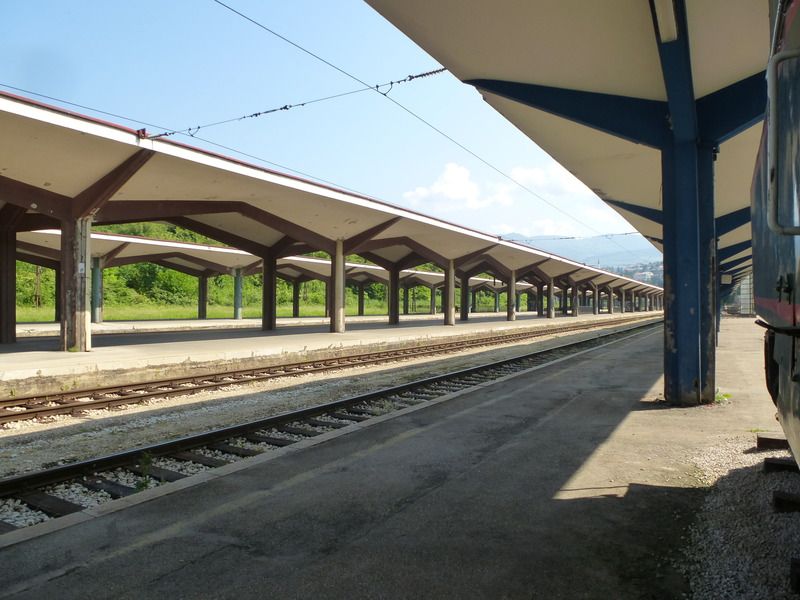
Most of the locos in use seem to be Austrian, some of them have nice new paint jobs
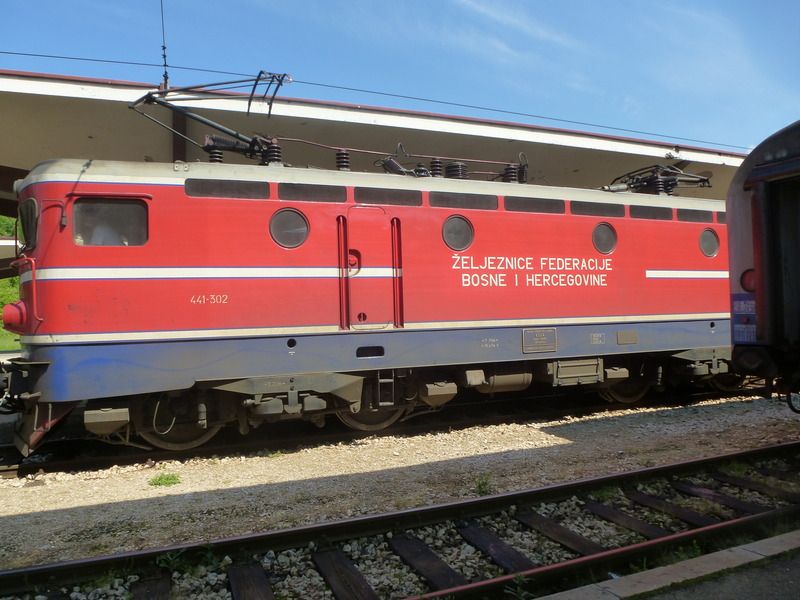
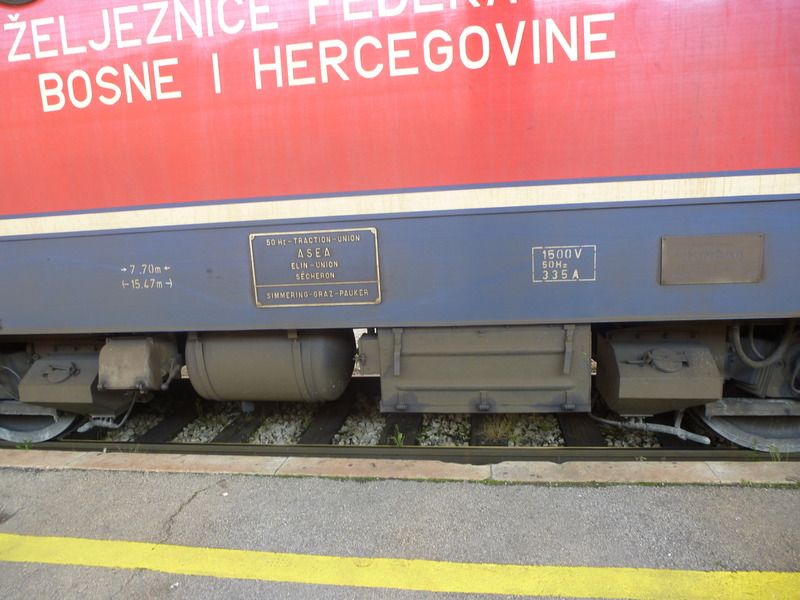
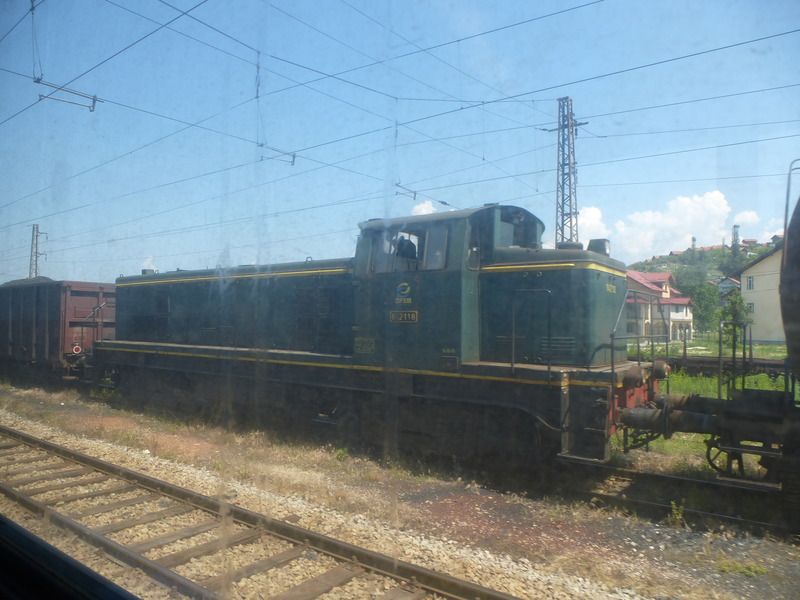
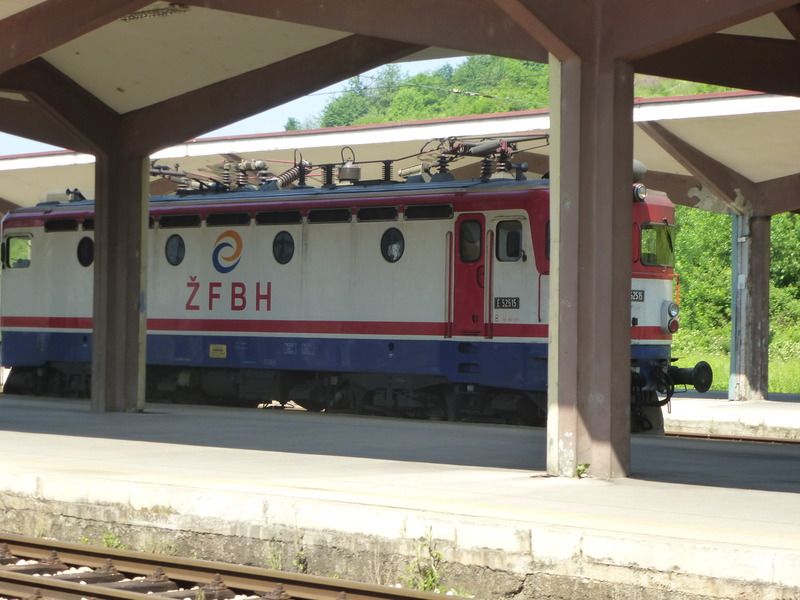
Carriages are a mixture.

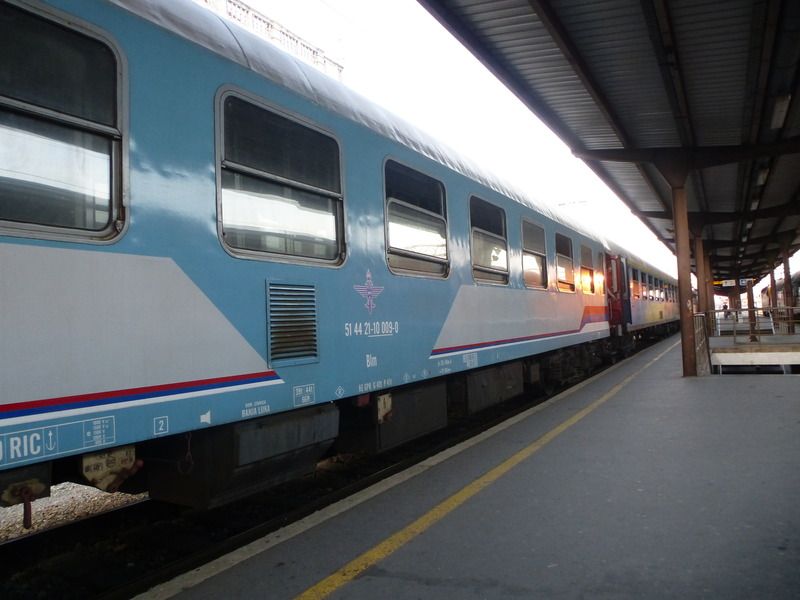
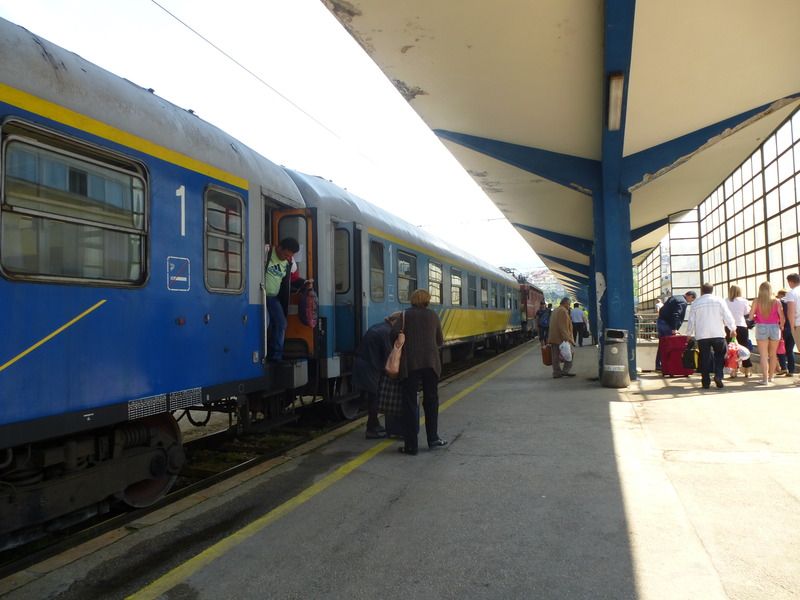
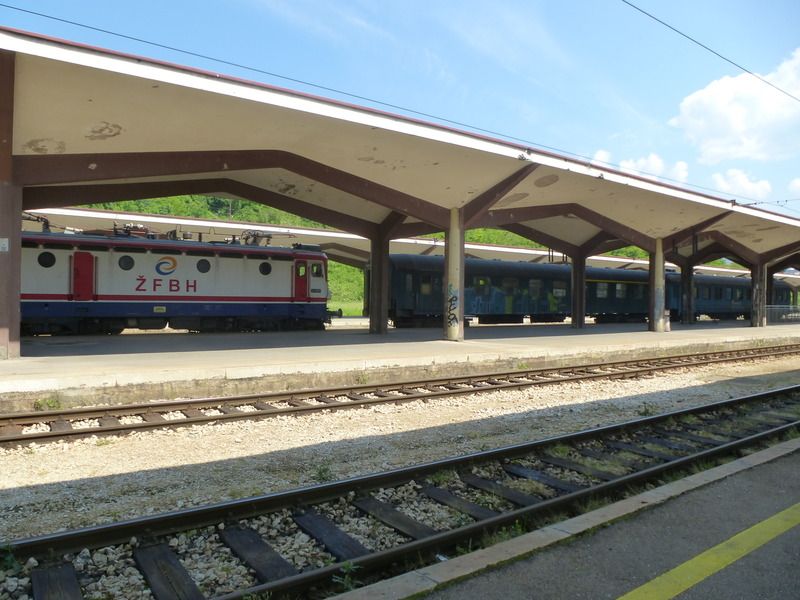
The journey from Sarajevo to Zagreb is scheduled to last around 9 hours but it can take much longer. The timetable can be found on DB’s website (it also appears on the Bosnian railways website but in a confusing form). The good news is that the scenery is lovely.
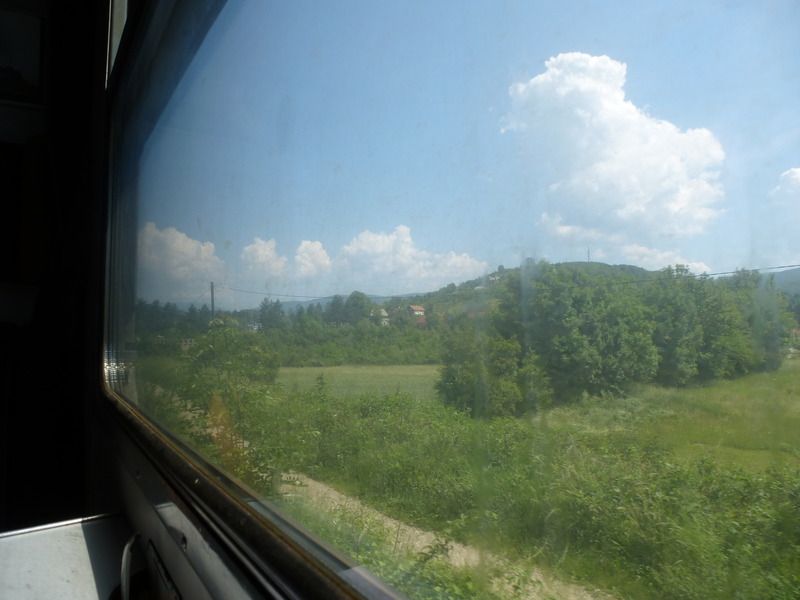
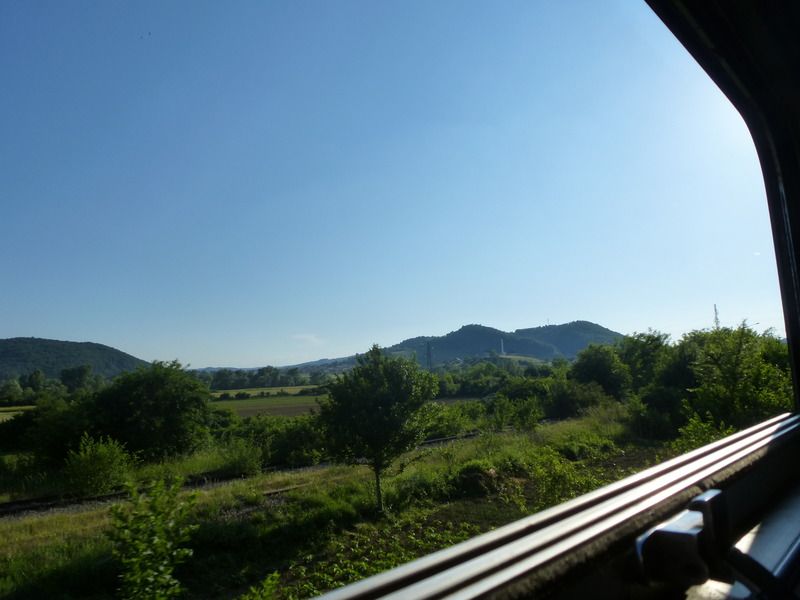
Travelling by rail is also a useful introduction to just how complicated Bosnia is. Much of the journey to Zagreb is through the Republica Srpska which is populated by ethnic Serbs who, although they speak the same language as the rest of the country, write in Cyrillic and tend to display the Serbian flag. Many stations have their names written in both languages.
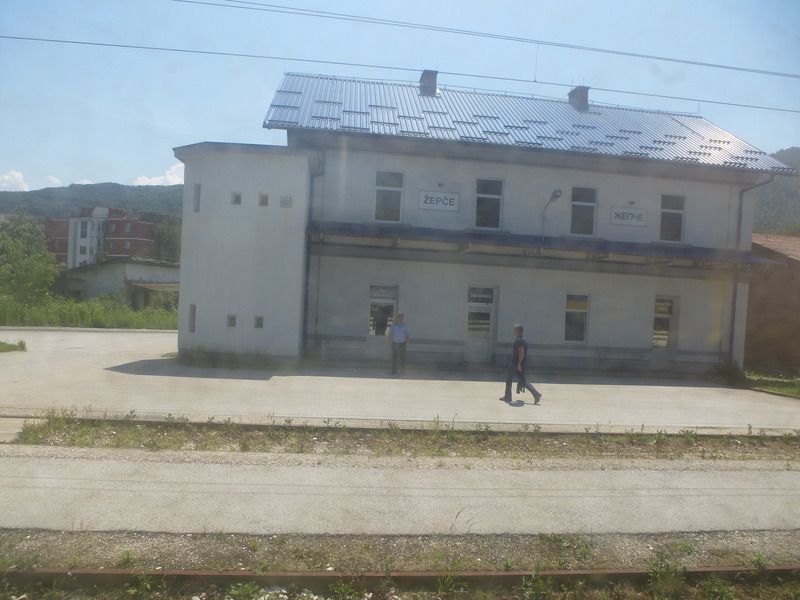
Stationmasters always seem to be standing outside when the train comes past. I’m not sure if they are supposed to be looking at the trains to make sure nothing is falling off, displaying their love of the railways, or if it’s just a measure to stop them wandering off. Some stations have war memorials, perhaps to railways staff who were killed in the war.
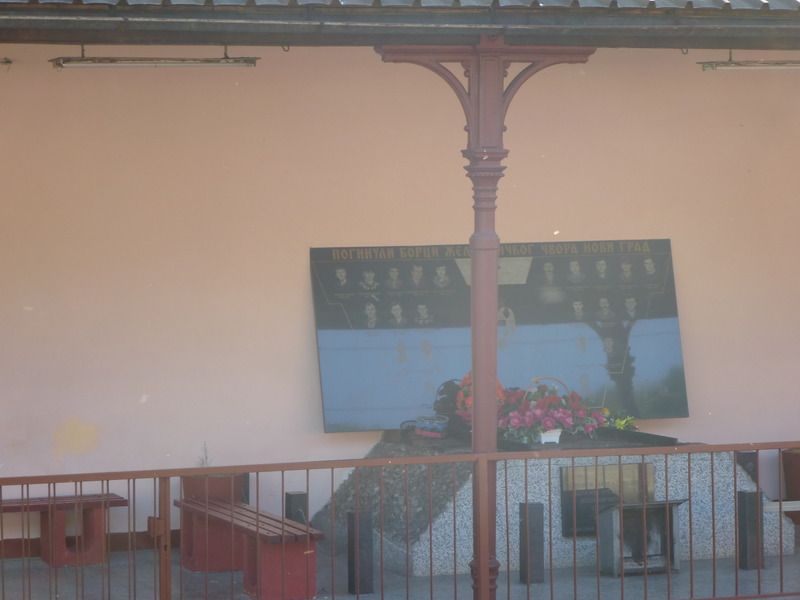
The Sarajevo-Zagreb trains are formed of Bosnian owned coaches which are linked together by corridors so you can move around them. All seating is in compartments designed for six people. Often non-smoking compartments are next to smoking compartments and the smell leaches through. I take an anti-histamine and smear Vaseline around my nose, mouth and eyes to try and limit the effects.
The coaches are generally clean but so ancient that they are inevitably stained and tatty. In some compartments the lights don’t work. There is no air-conditioning but there are big windows which can be pulled down. I found my compartment’s window refused to stay down so I tried tying it with string. The string snapped. My Bosnian compartment mates solved the problem by jamming a bottle of water in to hold it open. They were two elderly ladies apparently on their way to visit their families. This was kind of surprising as normally it is the young people who leave their parents behind to go and work in the capital. They were very friendly and we were soon on good terms despite the lack of a common tongue. I missed them after they got off at Doboj.
The outskirts of Sarajevo have quite a lot of marshalling yards and depots but thereafter there seemed to be little railway activity away from major stations. Most stations had large amounts of freight stock in sidings but a lot of it looked like it hadn’t been used for a long time.
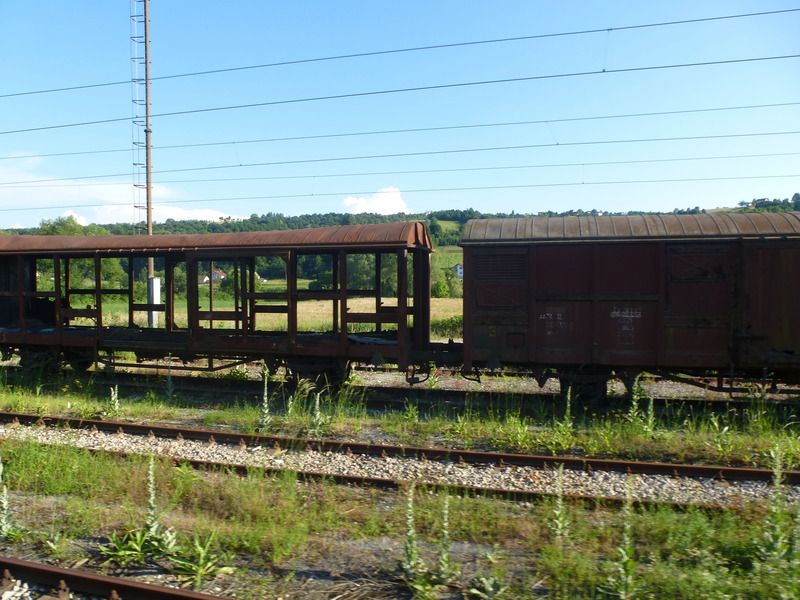
This is not a journey divorced from the world outside. Blossom and, later, the scent of hay making drift in through open windows as the train makes its lazy way between rural stations – it is a thing of the countryside. When we go through a long tunnel and all the lights fail it is pitch black and I have a strange desire to start reciting Invictus:
Out of the night that covers me,
Black as the pit from pole to pole,
I thank whatever gods may be
For my unconquerable soul.
I refrain because I suspect that the elderly ladies would be rather alarmed and also because I can’t remember the poem properly.
Some time after leaving Doboj I get a visit from the guard who tries to explain something to me – and fails. I apologise, in English and in German, for not understanding him and he resorts to the time honoured method of repeating himself slowly and loudly for the benefit of the foreign idiot. For once this tactic actually works, I catch four words I recognise and realise that I must move because the coach I am sitting in will be removed at Banja Luka. The guard is so relieved to be understood that he carries my bag to the next coach for me.
At Banja Luka I gain two people to share my new compartment, women in their forties or so this time and obviously good friends. I am sitting facing the engine and am getting very hot so they motion for me to join them on the shady side of the compartment. We spread paper bags over the seats on the sunny side and put our feet up. Our bliss is shattered by the train grinding to a halt at some out of the way station.
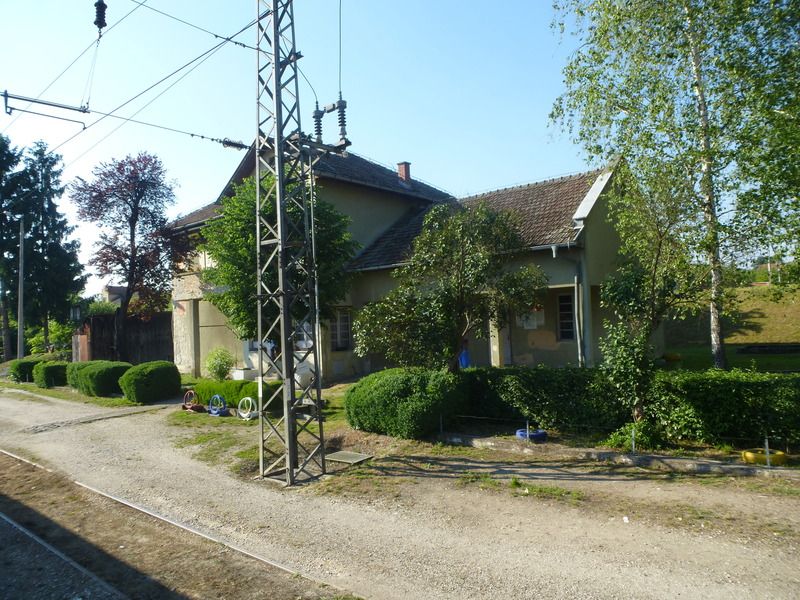
We stay at this station for a long time. After five minutes or so the guard comes along to apologise for the delay, Bosnian and English have enough body language in common for it to be clear that he has no idea what the cause of the delay is. If this was Britain the guard and the driver would now lock themselves in their compartment and make placating announcements whilst the passengers would sit around moaning before getting on twitter to complain.
But since this is Bosnia everyone gets off the train. The guard and the driver disappear into the station master’s office to smoke and drink coffee. The passengers smoke, sunbathe, and fill their water bottles from the station tap. A number of people wander off to the road where there is a bus stop. Several of them are wearing railway uniform.
Another train from Banja Luka pulls in beside us and it is all very sociable and jolly. The guard emerges from the station house and holds a shouted conversation with several passengers. I conclude he still doesn’t know what is going on but I decide to try asking. Luckily one of my compartment mates speaks a bit of English. “We go Zagreb today?” I ask, “maybe tomorrow”?
She shrugs “tomorrow”.
This does not sound particularly promising and I begin to see the attractions of the bus stop. But I am in no hurry and so decide I might as well wait around. Nearly an hour after we arrived, we finally leave the little country station. I have found out neither the name of the village nor the reason for the delay.
We make quick progress to the Bosnia/Croatia border, the train for once outpacing the river that runs alongside the railway. At Dobrilijn the Bosnian border police board the train and take passports away to their office to be exit stamped. I am delighted to find this stamp is in Cyrillic, it makes me feel well-travelled.
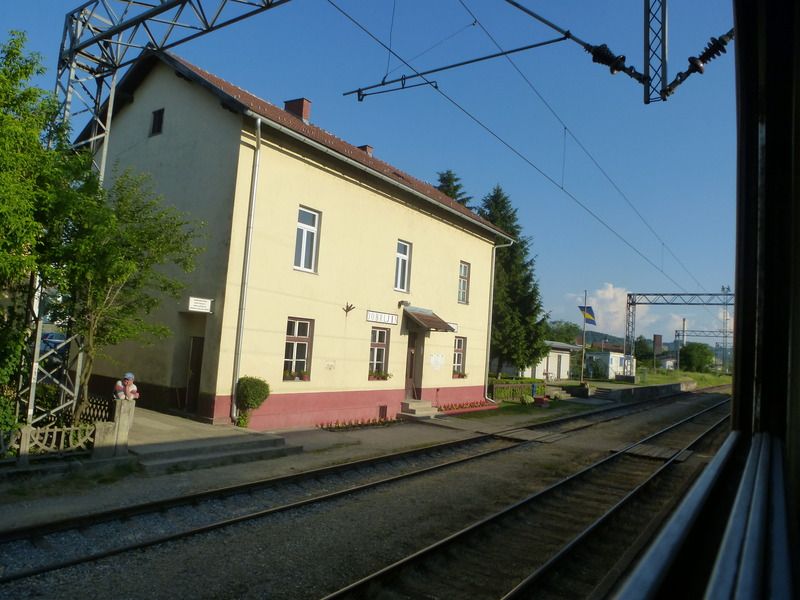
At Volinja the Croatian border police board the train. They have a handheld computer for scanning everyone’s passports and treat those of the Bosnians with considerable suspicion. Here we lose our Bosnian locomotive which is replaced by a Croatian engine which will take us to Zagreb.
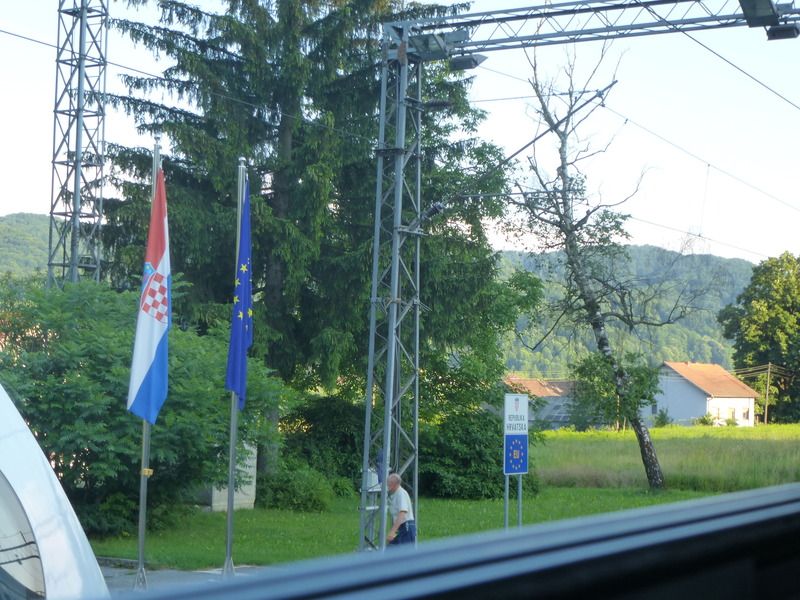

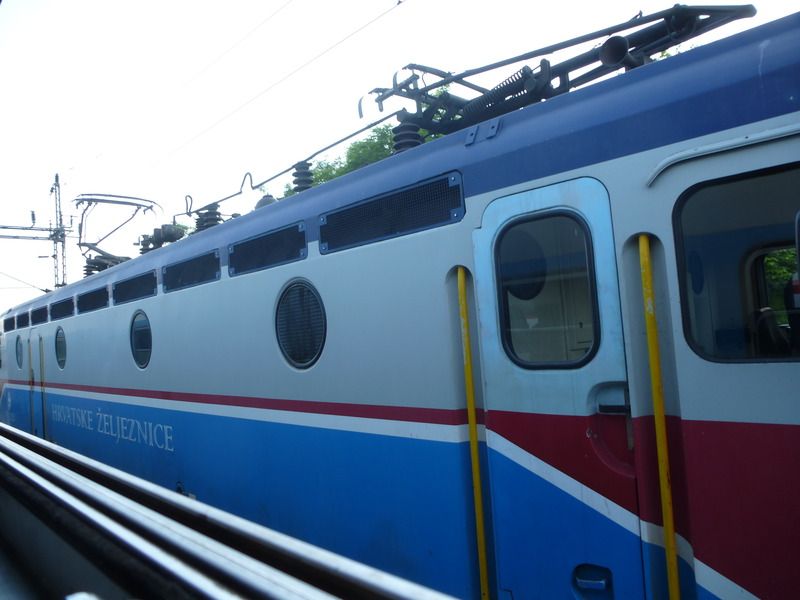

Croatia too smells of freshly cut hay and blossom and it has some stations in poor condition. But it seems a more confident and cosmopolitan country than Bosnia. Sisak appears to be a thriving town and somebody in the next compartment whistles the French national anthem non-stop for half an hour. The train arrives in Zagreb an hour and three minutes late.

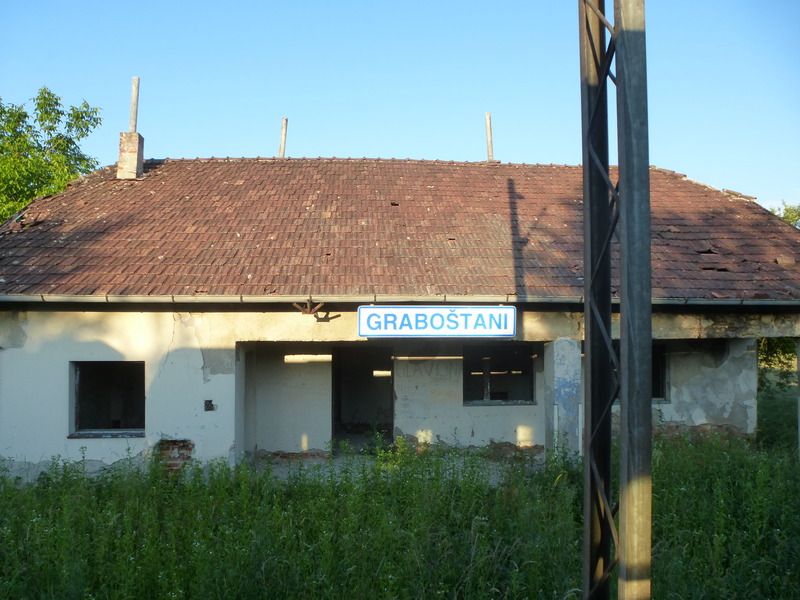
Dinamo are the Champions!
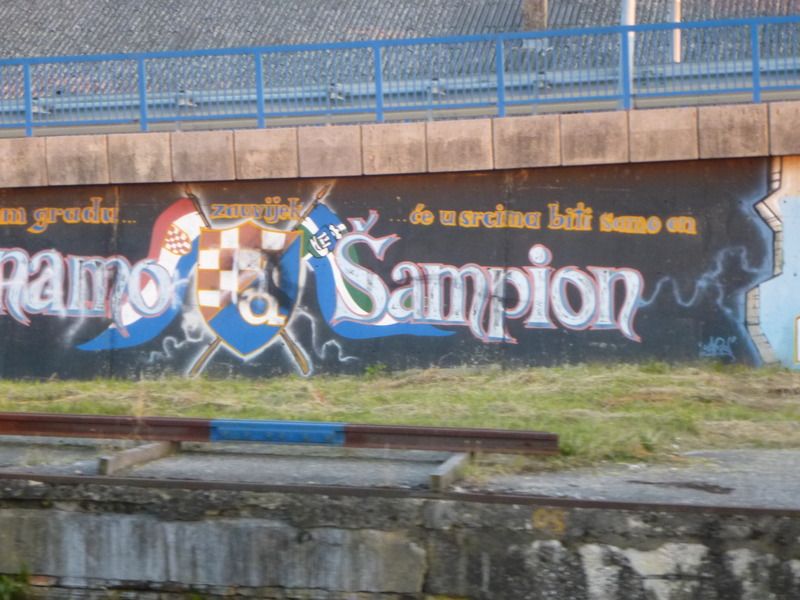
Zagreb station
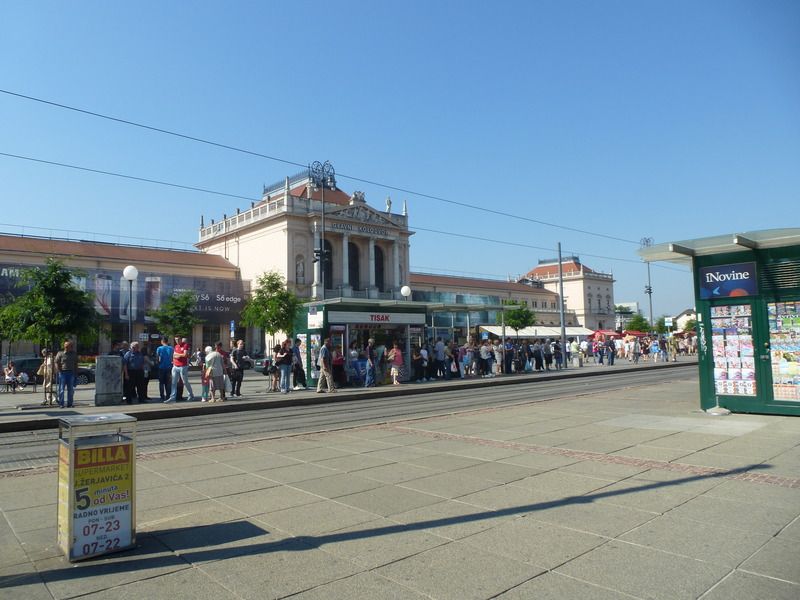
Travelling by rail from Sarajevo to Zagreb should not be attempted by anyone of a nervous disposition, anyone with a compromised immune system, anyone with a germ/dirt phobia, asthmatics or anyone in a hurry. If you still decide you want to do it you will need to bring the following:
Food and drink (there is no on-board catering)
Wet wipes
Tissues
Hand sanitizer and extra water supplies are recommended. You may also consider flying instead. Actually you should seriously consider flying instead.
In other words, rail is neither the fastest nor cleanest way of travelling between Sarajevo and Zagreb but it is great fun. Bosnia’s railway is largely reliant on second hand equipment sourced from all over Europe. States of repair and reliability vary considerably. I did see a shiny new multiple unit lurking in a yard on the edge of Sarajevo but this is no solution to the poor state of many of the facilities and limited capacity of the system. There are still signs of war all along the railway, derelict buildings, minefields and damaged stations such as Sarajevo’s.

Most of the locos in use seem to be Austrian, some of them have nice new paint jobs




Carriages are a mixture.




The journey from Sarajevo to Zagreb is scheduled to last around 9 hours but it can take much longer. The timetable can be found on DB’s website (it also appears on the Bosnian railways website but in a confusing form). The good news is that the scenery is lovely.


Travelling by rail is also a useful introduction to just how complicated Bosnia is. Much of the journey to Zagreb is through the Republica Srpska which is populated by ethnic Serbs who, although they speak the same language as the rest of the country, write in Cyrillic and tend to display the Serbian flag. Many stations have their names written in both languages.

Stationmasters always seem to be standing outside when the train comes past. I’m not sure if they are supposed to be looking at the trains to make sure nothing is falling off, displaying their love of the railways, or if it’s just a measure to stop them wandering off. Some stations have war memorials, perhaps to railways staff who were killed in the war.

The Sarajevo-Zagreb trains are formed of Bosnian owned coaches which are linked together by corridors so you can move around them. All seating is in compartments designed for six people. Often non-smoking compartments are next to smoking compartments and the smell leaches through. I take an anti-histamine and smear Vaseline around my nose, mouth and eyes to try and limit the effects.
The coaches are generally clean but so ancient that they are inevitably stained and tatty. In some compartments the lights don’t work. There is no air-conditioning but there are big windows which can be pulled down. I found my compartment’s window refused to stay down so I tried tying it with string. The string snapped. My Bosnian compartment mates solved the problem by jamming a bottle of water in to hold it open. They were two elderly ladies apparently on their way to visit their families. This was kind of surprising as normally it is the young people who leave their parents behind to go and work in the capital. They were very friendly and we were soon on good terms despite the lack of a common tongue. I missed them after they got off at Doboj.
The outskirts of Sarajevo have quite a lot of marshalling yards and depots but thereafter there seemed to be little railway activity away from major stations. Most stations had large amounts of freight stock in sidings but a lot of it looked like it hadn’t been used for a long time.

This is not a journey divorced from the world outside. Blossom and, later, the scent of hay making drift in through open windows as the train makes its lazy way between rural stations – it is a thing of the countryside. When we go through a long tunnel and all the lights fail it is pitch black and I have a strange desire to start reciting Invictus:
Out of the night that covers me,
Black as the pit from pole to pole,
I thank whatever gods may be
For my unconquerable soul.
I refrain because I suspect that the elderly ladies would be rather alarmed and also because I can’t remember the poem properly.
Some time after leaving Doboj I get a visit from the guard who tries to explain something to me – and fails. I apologise, in English and in German, for not understanding him and he resorts to the time honoured method of repeating himself slowly and loudly for the benefit of the foreign idiot. For once this tactic actually works, I catch four words I recognise and realise that I must move because the coach I am sitting in will be removed at Banja Luka. The guard is so relieved to be understood that he carries my bag to the next coach for me.
At Banja Luka I gain two people to share my new compartment, women in their forties or so this time and obviously good friends. I am sitting facing the engine and am getting very hot so they motion for me to join them on the shady side of the compartment. We spread paper bags over the seats on the sunny side and put our feet up. Our bliss is shattered by the train grinding to a halt at some out of the way station.

We stay at this station for a long time. After five minutes or so the guard comes along to apologise for the delay, Bosnian and English have enough body language in common for it to be clear that he has no idea what the cause of the delay is. If this was Britain the guard and the driver would now lock themselves in their compartment and make placating announcements whilst the passengers would sit around moaning before getting on twitter to complain.
But since this is Bosnia everyone gets off the train. The guard and the driver disappear into the station master’s office to smoke and drink coffee. The passengers smoke, sunbathe, and fill their water bottles from the station tap. A number of people wander off to the road where there is a bus stop. Several of them are wearing railway uniform.
Another train from Banja Luka pulls in beside us and it is all very sociable and jolly. The guard emerges from the station house and holds a shouted conversation with several passengers. I conclude he still doesn’t know what is going on but I decide to try asking. Luckily one of my compartment mates speaks a bit of English. “We go Zagreb today?” I ask, “maybe tomorrow”?
She shrugs “tomorrow”.
This does not sound particularly promising and I begin to see the attractions of the bus stop. But I am in no hurry and so decide I might as well wait around. Nearly an hour after we arrived, we finally leave the little country station. I have found out neither the name of the village nor the reason for the delay.
We make quick progress to the Bosnia/Croatia border, the train for once outpacing the river that runs alongside the railway. At Dobrilijn the Bosnian border police board the train and take passports away to their office to be exit stamped. I am delighted to find this stamp is in Cyrillic, it makes me feel well-travelled.

At Volinja the Croatian border police board the train. They have a handheld computer for scanning everyone’s passports and treat those of the Bosnians with considerable suspicion. Here we lose our Bosnian locomotive which is replaced by a Croatian engine which will take us to Zagreb.




Croatia too smells of freshly cut hay and blossom and it has some stations in poor condition. But it seems a more confident and cosmopolitan country than Bosnia. Sisak appears to be a thriving town and somebody in the next compartment whistles the French national anthem non-stop for half an hour. The train arrives in Zagreb an hour and three minutes late.


Dinamo are the Champions!

Zagreb station

#6
Join Date: Jul 2013
Location: Dubai
Posts: 3,301
Great TR, exilencfc . Definitely whets my appetite to see that interesting part of europe.
. Definitely whets my appetite to see that interesting part of europe.
Train is a great way to overland too, even if there are a few unexpected stops on the way .
.
Looking forward to more of your Balkan adventure.
 . Definitely whets my appetite to see that interesting part of europe.
. Definitely whets my appetite to see that interesting part of europe.Train is a great way to overland too, even if there are a few unexpected stops on the way
 .
.Looking forward to more of your Balkan adventure.
#7
Join Date: Aug 2014
Location: Austria, EU
Posts: 86
Absolutely loving this.
Train travel in south-eastern Europe is always a magnificent experience.
A bit of a shame that you took the overnight from Zagreb to Munich, the Austrian part of this journey takes you right through the alps on one of the most scenic routes that I know and in Slovenia you go along the river Sava which also makes for good views.
Train travel in south-eastern Europe is always a magnificent experience.
A bit of a shame that you took the overnight from Zagreb to Munich, the Austrian part of this journey takes you right through the alps on one of the most scenic routes that I know and in Slovenia you go along the river Sava which also makes for good views.
#8
Original Poster
Join Date: Jul 2011
Location: LHR- ish
Programs: MUCCI, BA Blue
Posts: 4,295
Absolutely loving this.
Train travel in south-eastern Europe is always a magnificent experience.
A bit of a shame that you took the overnight from Zagreb to Munich, the Austrian part of this journey takes you right through the alps on one of the most scenic routes that I know and in Slovenia you go along the river Sava which also makes for good views.
Train travel in south-eastern Europe is always a magnificent experience.
A bit of a shame that you took the overnight from Zagreb to Munich, the Austrian part of this journey takes you right through the alps on one of the most scenic routes that I know and in Slovenia you go along the river Sava which also makes for good views.
Twenty five hours in Zagreb
We need to talk about country collecting. Which is a shame really because it seems to be one of those subjects that turns normally reasonable people into snarling psychopaths. Sort of like my colleague whose presence in the building is generally announced by the murderous expression on every second person’s face. He’s a nice lad really, he tries hard, it’s just that everything he touches turns to crap. On the subject of my colleagues, the one who was worried about the company I’d be keeping on Bosnian trains attracted the attentions of a lunatic (thankfully harmless) on a train from London to Slough. Oh how I laughed when she told me. Mind you she did only have to put up with him for half an hour.
But back to country collecting. Some of you will no doubt be muttering that 25 hours in Zagreb does not count as visiting Croatia – heck I spent 8 hours of it asleep. And I suppose you’re right in some ways, after all Zagreb isn’t Croatia’s famously beautiful coastline or its small towns. In fact it feels decidedly like Vienna in many ways. But I reckon it’s enough time to get a feel for the place and its people. Which is probably why I don’t like Monaco, after two hours there I could only assume the inhabitants were all rich, vulgar, and happy to sit in traffic jams. Besides, I can (and hopefully will) return – to Croatia not Monaco that is.
My hotel in Zagreb was the Hotel Central. The name is misleading, it’s a good ten minutes walk from the town centre. But just across the road from the railway station which is why I chose it. Unfortunately my arrival coincided with that of a complete Don’t You Know Who I Am. And she was ahead of me in the queue. First she was moaning about the room she’d been allocated. The clerk says if she doesn’t like it she can move in the morning. She says she will. She asks him to suggest a restaurant near the hotel serving good Croatian food. But a five minute walk is too much for her. Finally she demands somebody to carry her bag up to her room. The bag is a small roll-aboard, the lift is two meters away. Now in fairness she may have had some hidden disability but she gave no hint of it. She did give every impression of being an arrogant cow. But there’s no rule saying disabled people have to be nice. The queue built up behind her. We shuffled impatiently. We sighed loudly. Then we started moaning about her in German.
When I finally managed to check into the hotel I found that my room was so newly refurbished that it smelt of fresh paint. And very nice it was too, apart from the view out onto a ventilation shaft. I slept well, gorged on the breakfast buffet, and set out to explore Zagreb. Having gotten dressed first obviously. The station has luggage lockers but they require coins which I didn’t have so I left my luggage at the hotel.
The walk into the city centre took me through parks and past some museums and public buildings. Having reached the main city square I decided to pretty much abandon the map and just wander. This works very well for me most of the time because I am blessed with a good sense of direction. Though it did desert me totally in Prague where I had to wander around with my head in a map. The first thing I found in Zagreb was the cathedral which was originally devoted to St Stephen but is now the Cathedral of the Assumption of the Blessed Virgin Mary. I can only assume that the name change was proposed by somebody involved in the printing business.
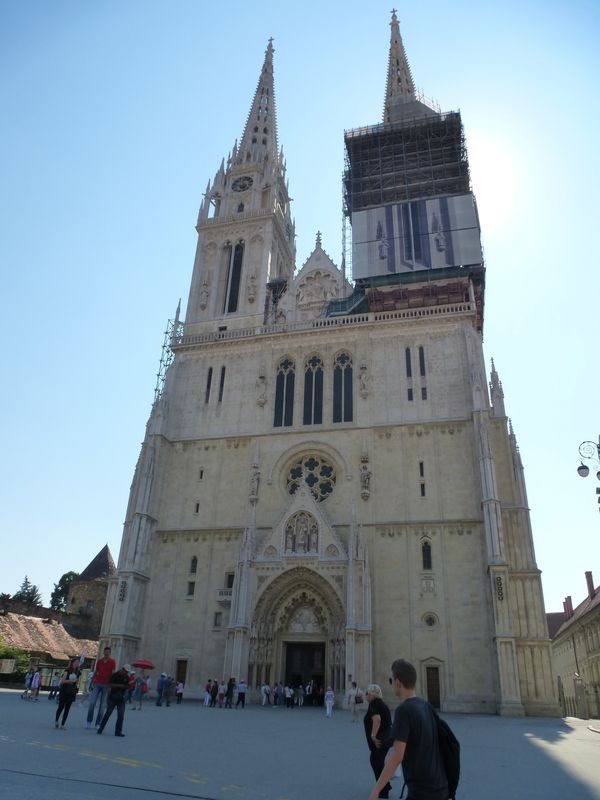
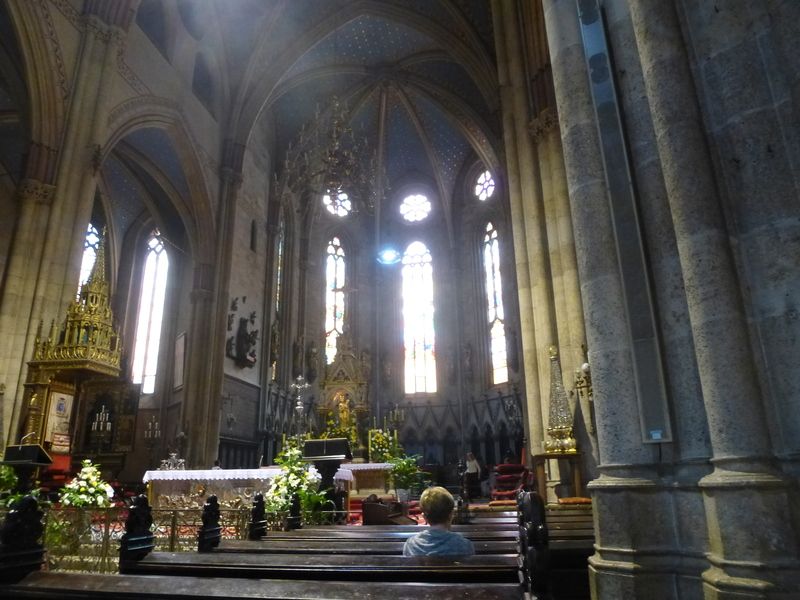
The cathedral has medieval origins but was re-built after an earthquake in 1880 and is beautiful inside and out. The one of the most notable features inside is the sarcophagus of Aloysius Stepinac a Croatian archbishop and cardinal who was declared a martyr and beatified for his role in protecting Jews in the Second World War and for speaking out against the actions of the Ustase, Nazis and, later, Yugoslavia’s communist government. Stepinac is a controversial figure; among other things it is claimed that he led a group of Croatian officials who gave Orthodox Serbs a choice between converting to Catholicism and death (it is claimed that many who ‘agreed’ to convert were murdered anyway). Thus Stepinac is a very controversial national hero.
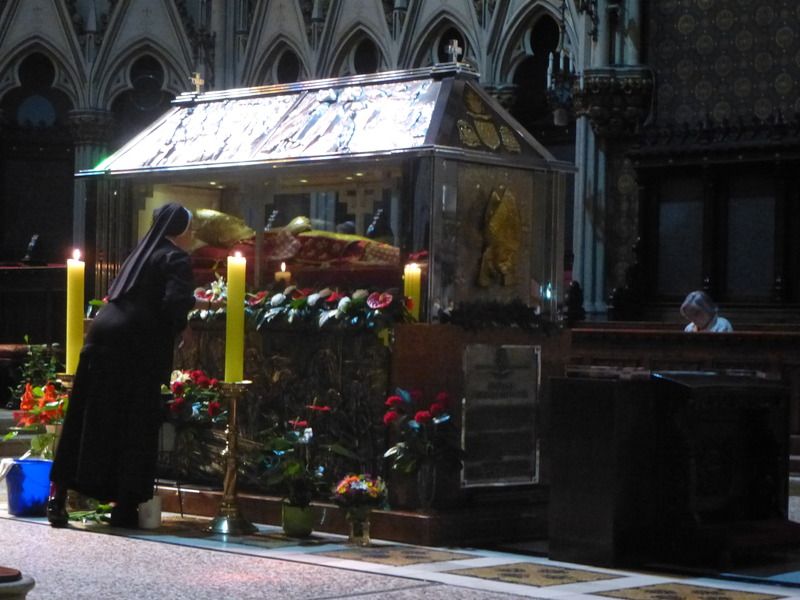
The nun changing the flowers on the sarcophagus was one of many I saw around the city, along with great numbers of monks and priests. Perhaps it isn’t surprising that I also found a shop selling all manner of religious accoutrements.
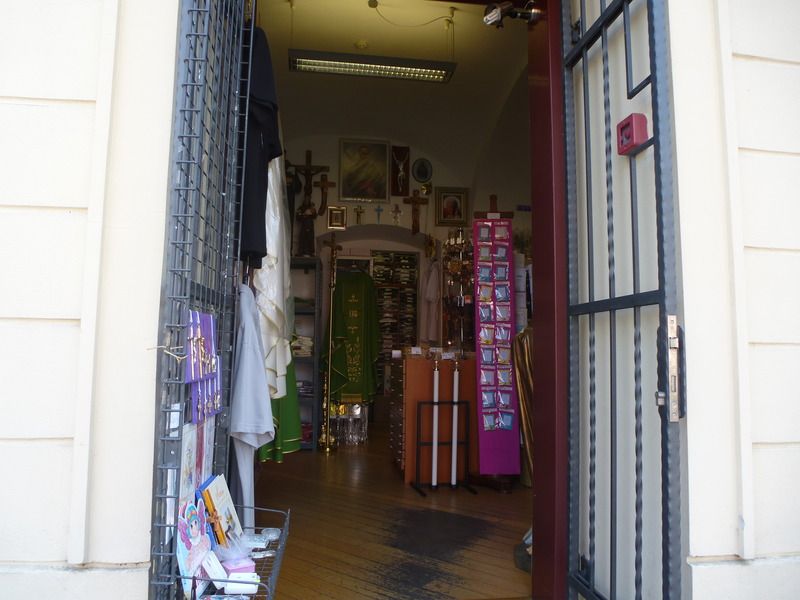
From the cathedral I found my way to Dolac market. The market is on two levels, a piazza where fruit and vegetables are sold is situated over a large hall containing butchers, cheese shops, bakeries and the like. The fish market is located in a hall next to the fruit and vegetable section. Today the market was filled with fresh fruit. Stalls groaned under the weight of strawberries, raspberries, apricots, cherries and plums. The smells hung so heavily that the air seemed to be thickened, like some kind of earthly paradise.
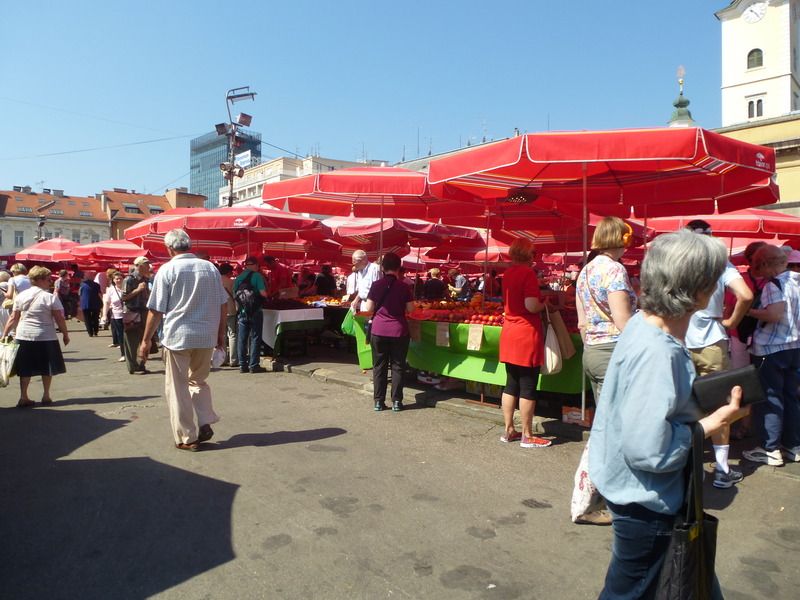
I rejected fruit as impractical and bought some honey instead. The stall holder had about ten different kinds of Croatian honey lined up, all from bees who took pollen from different types of trees. I bought hazelnut honey. She gave me a long explanation which was, needless to say, entirely wasted.
I stopped off for freshly made lemonade (so fresh that it still had the pips in it) and decided to consult my map and Lonely Planet whilst I was drinking it. I decided that my next stop would be the Stone Gate which is one of the most famous religious sites in Croatia. It is said that when the gate burnt down in 1731 the only thing that survived was a painting of Mary and Jesus. Nowadays the painting is still there and attracts worshippers in large numbers. There are pews and a candle seller for the convenience of worshippers. For some reason there’s a statue of St George slaying the dragon almost next to it.
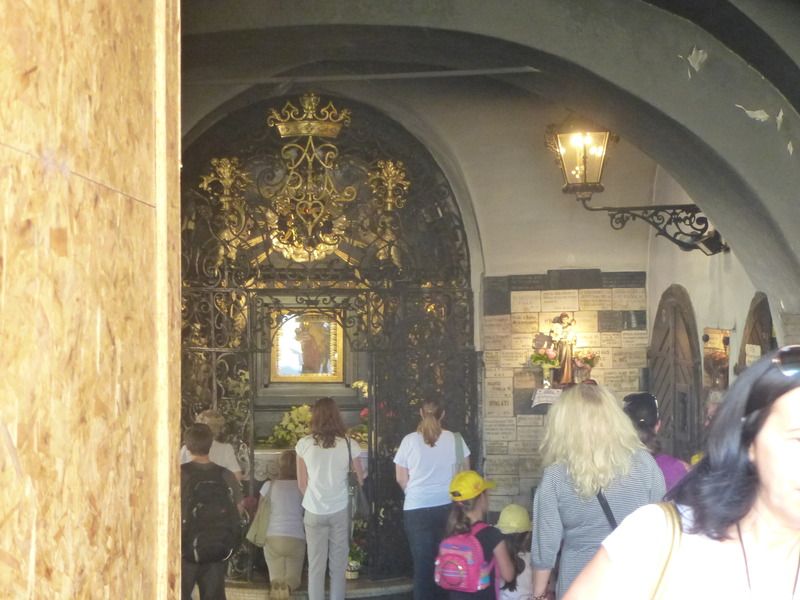
I walked up the hill to St Mark’s church. Zagreb was originally two towns – one, Kaptol, was focussed around the cathedral and administered by the church whilst, on the next hilltop, secular power clustered around St Mark’s in the town of Gradec. In the long term Gradec won out, many Croatian government buildings and several national embassies can be found here.

Nowadays Gradec is known as the upper town - and there is a fine view from the tree-lined promenade by the Lotrščak Tower which can be climbed for an even better view. One thing my Lonely Planet did not tell me is that a cannon is fired from the tower every day at noon. What’s the Croatian phrase for ‘where can I buy some new underpants’?
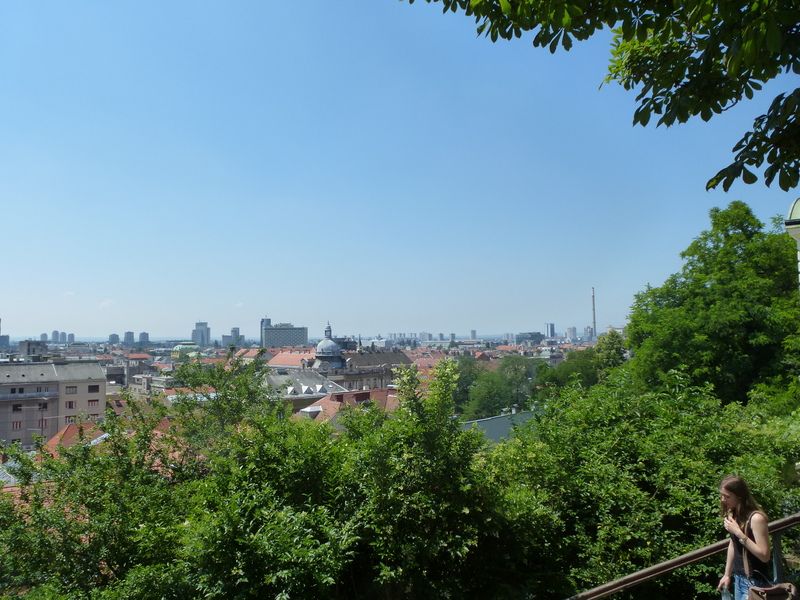
I gave the Museum of Broken Relationships a miss and headed back down the hill for lunch which was chicken skewers and chips in a pub. A meal best described as unmemorable, though the glass of Croatian wine was excellent. After lunch I walked back up the hill, which seemed to have gotten hillier in the intervening period, and visited the city museum. The museum was very informative and it was also an interesting contrast to Sarajevo in that only one room was devoted to Croatia’s independence struggle. Zagreb got off fairly lightly, with only occasional attacks by mortars or rockets although seven people were killed.
I walked back down the hill, having first checked my Lonely Planet to make very sure there were no more things up there that I really should see – no way was I walking back up there again. There is a funicular which terminates by Lotrščak Tower but I don’t know where it starts.
I walked down along a street filled with restaurants and cafes. Zagreb is enjoying a tourism boom but I guess not everyone appreciates it.
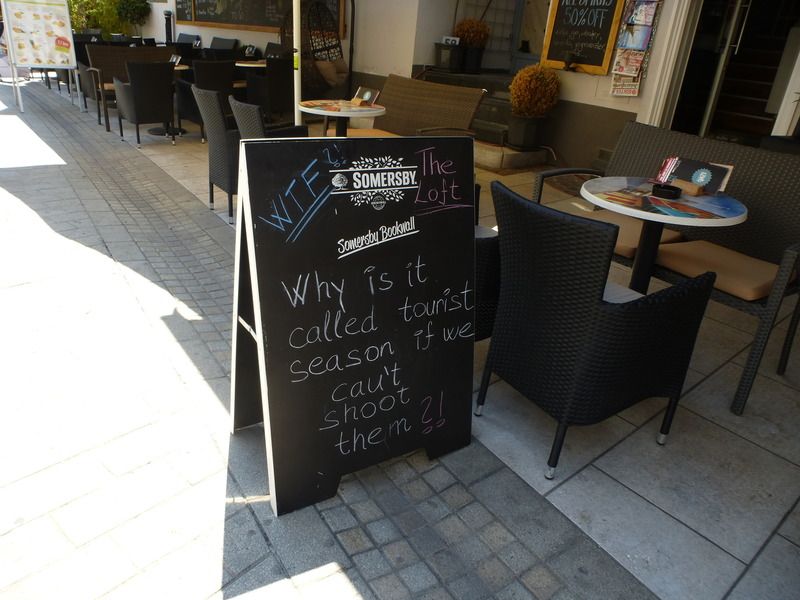
I stopped for a drink in a café which had water misters playing over its customers. This was delightful until I realised that: 1- my phone was getting wet (I was using the café’s wifi to catch up with my online life), 2 – the sprayers would be a perfect place to harbour Legionella bacteria (I’m not the world’s most optimistic person), and 3- I was drinking Zagreb’s most expensive Coke Zero, in fact at £1.70ish for a small bottle it wasn’t cheap by British standards.
So I finished my coke and left, luckily the wifi had an extremely wide range. I wandered back into the city centre and up to the market square. The market had finished, the shoppers and vendors had gone home. All that remained was birds, insects and a mountain of rubbish. Pity the poor person who has to clear all this lot up.
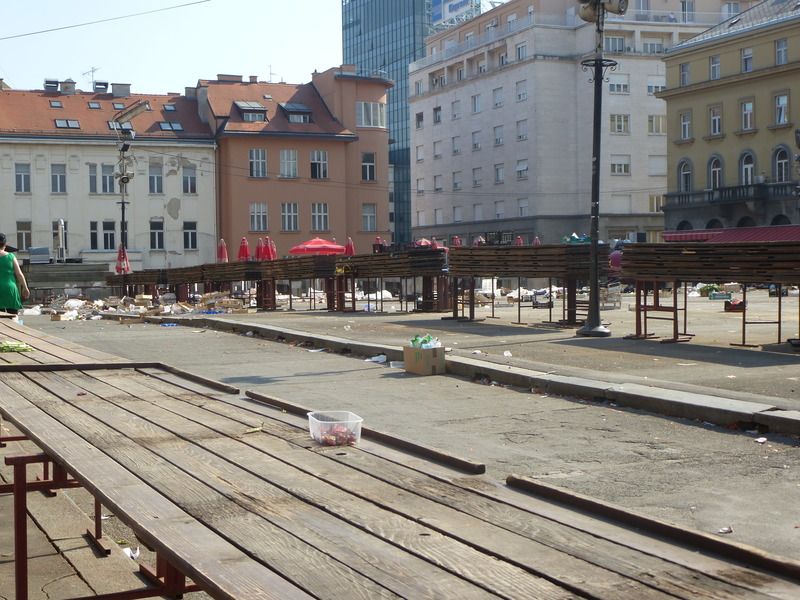
I wandered some more, did some shopping, ate an ice cream and then decided to go for dinner. Now normally I avoid any place that has pictures of its menu items like the plague but in this case I made an exception. The place was also a brewery which suggested they cared about at least part of what they were serving. I decided to order Pljeskavica which I’ve seen described as the Yugoslav answer to a burger. It is in fact the offspring of cheeseburger and calzone – a folded meat patty with cheese inside. And it was very nice indeed. I had two small bottles of Croatian wine with it and the meal cost just under £10 –a bit more expensive than Sarajevo but still pretty good value.

I walked back to the hotel and recovered my luggage from the clerk, I had allowed plenty of time but there was no sign of last night’s annoyance. Possibly she was busy looking up some interesting new German words she’d heard the night before? It was time to catch my overnight train to Munich, Nuremberg and my Flyertalk buddies awaited!
#9
Join Date: Mar 2014
Location: Czech Republic
Programs: Eurobonus
Posts: 20
Great and entertaining report. Sarajevo is one of my favorite European cities, I'm always happy to see trip reports from it and other Bosnian cities. I believe I had the same tour guide as you when I visited Sarajevo for the first time. Good people.
#11
Original Poster
Join Date: Jul 2011
Location: LHR- ish
Programs: MUCCI, BA Blue
Posts: 4,295
Zagreb to Nuremberg by train
I arrived at the station over an hour before my train was due to leave but that’s ok because I never feel like hanging around stations is a waste of time. The trains themselves are interesting, then there’s the people that work with them and the people that catch them. Croatia’s railways are in an interesting state at the moment, the shiniest and newest of trains mingling with survivors from the former Yugoslavia. It’s also the only station I’ve ever been to with its own religious shrine (though I have come across an underground station with a medieval chapel).
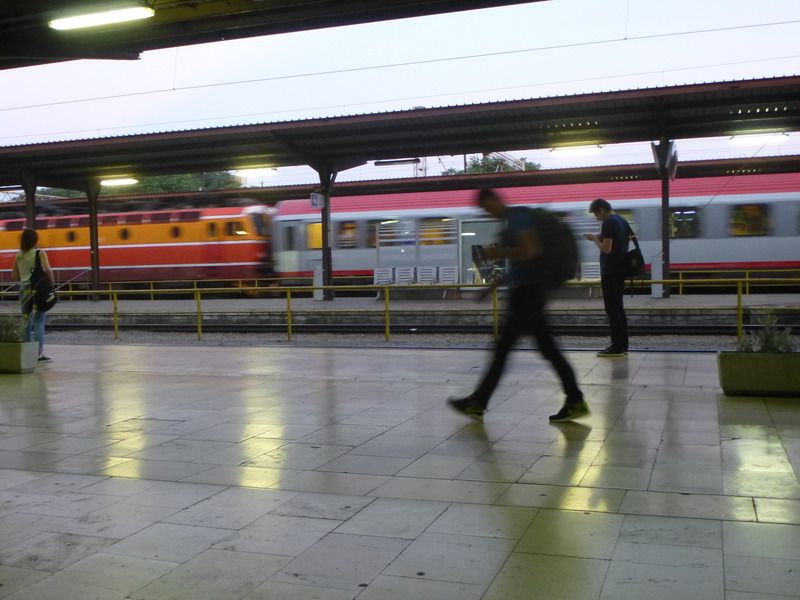
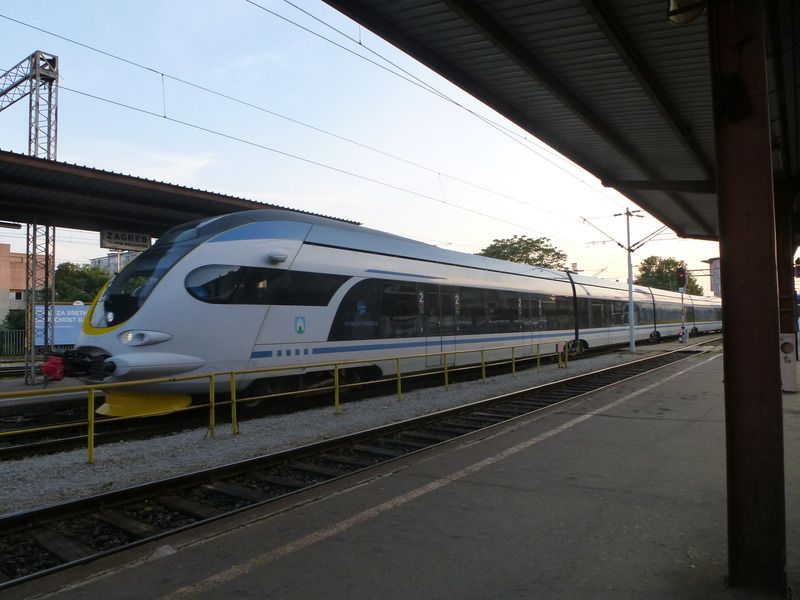
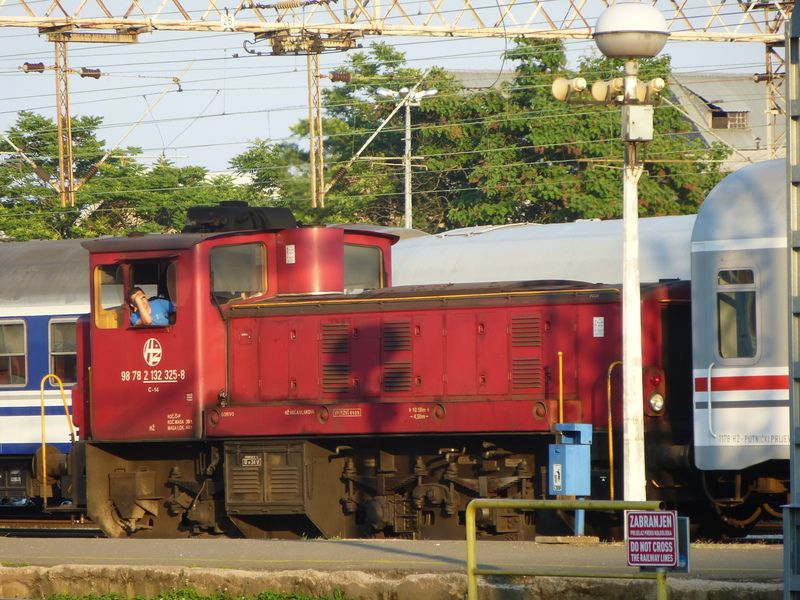
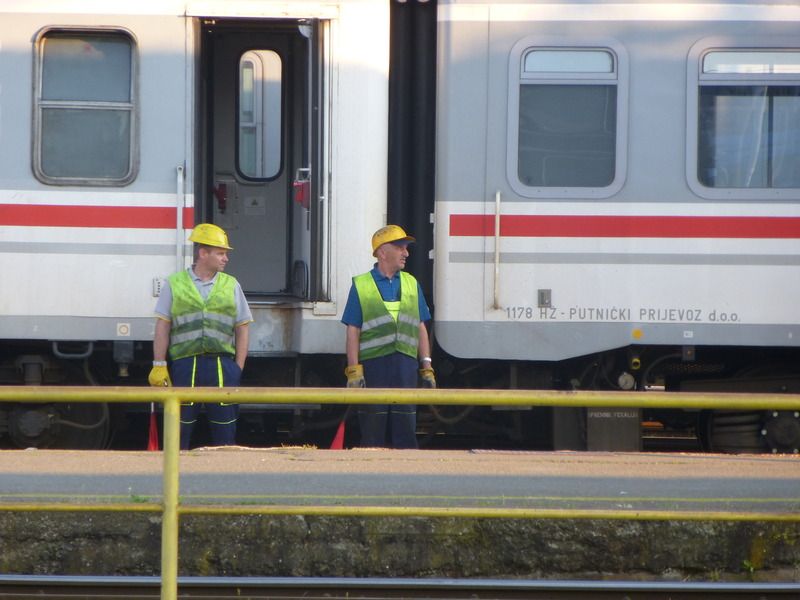
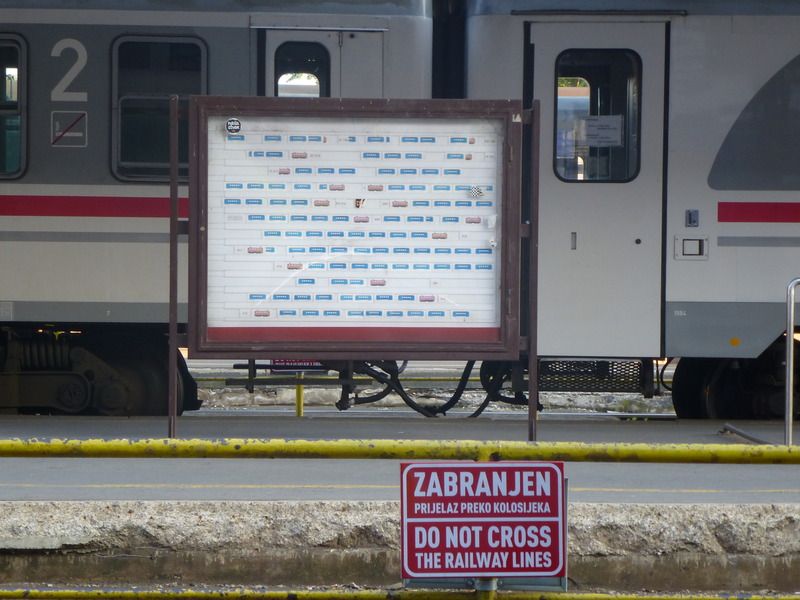
The locals treat ‘do not cross the railway lines’ as a suggestion rather than a rule. Most people do use the subway but a fair number just walk across the railway. I suspect it would be more if it wasn’t for that yellow fence. But they’re more compliant than the people of Budapest where almost everyone walks across the tracks at Keleti station and some people use the railway as a footpath to take them home. Strangely the people of Budapest are very compliant when it comes to not standing near the edge of Metro platforms. I discovered this when two indecipherable announcements were followed by a third indecipherable announcement which apparently translated as ‘can somebody please tell those idiot foreigners to stand back from the edge of the platform’. By London standards we already were standing well back. Goodness knows what people from Budapest think when they visit London.
Around half an hour before departure the train arrived at the platform. It was made up of three coaches: one of normal seating compartments (cheap), one of couchettes (four or six berth compartments, you get a cheap bed for the night but privacy is lacking), and a sleeper carriage. This has compartments containing three berths. You can buy a single berth and share with strangers or book a compartment for one or two of you. All the carriages were Croatian owned and staffed.
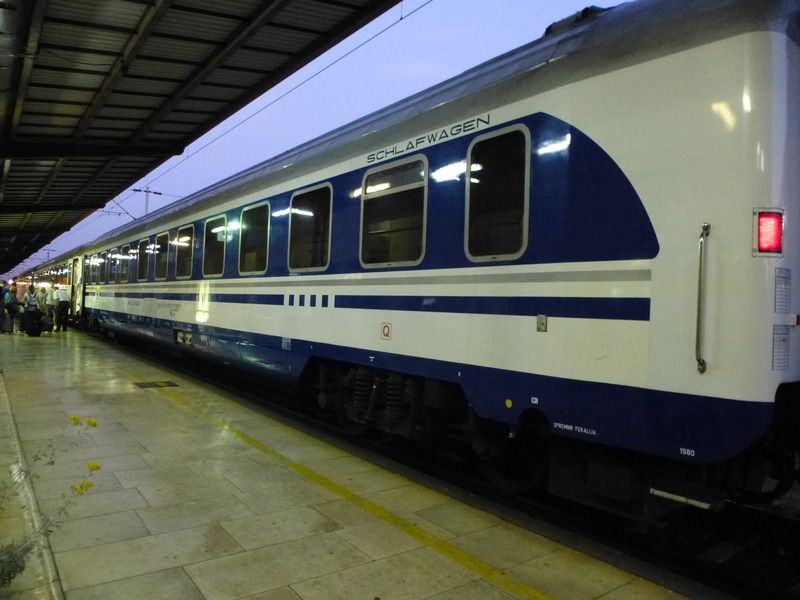
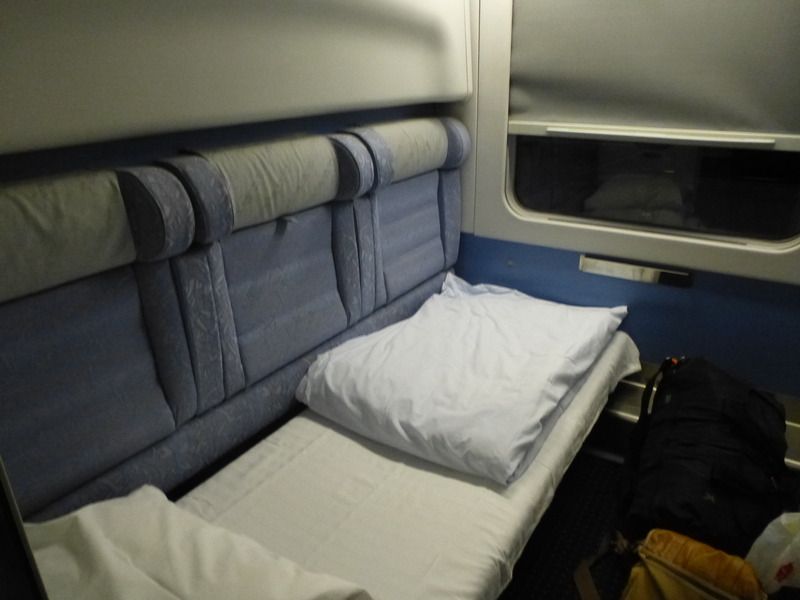
I’d booked my compartment to myself. My neighbours on one side were a pair of German men, I never got talking to them. On the other side were an Australian couple. They were travelling overland from Istanbul to Stuttgart where they were picking up their new motorhome. They planned to spend a couple of months travelling around Europe before taking their new possession home. I was impressed. On their other side was a pair of retired English ladies who had been holidaying in Croatia. One of them hates flying so they had agreed to return home by rail, I never discovered how they got to Croatia.
You may wonder why I’m telling you this, and it does sound a bit like the introduction to a modernised version of Murder on the Orient Express. I suppose it’s because it seemed to be pretty typical of night train journeys in Europe. I always meet a lot of other native English speakers and the whole thing tends to be very sociable. Night trains tend to be memorable for the people as well as the journeys themselves. And I love the journeys. Flying always feels a bit artificial to me, you go to an airport, get on an aeroplane, fly around for a bit and get off at another airport which is probably quite similar to the one you started at. With a train, things change on the journey – the landscape, the people, the language of the announcements. With a night train there is the added excitement of going to sleep in one country and waking up in another.
Well theoretically going to sleep in one country and waking up in another. I really struggle with the going to sleep bit. So much so that I sometimes wonder why I bother with overnight trains. But having had quite a decent night’s kip on the last one I took, I was hoping that I’d got that problem licked. With tomorrow’s arrival in Munich scheduled for 0610 I was looking to go to sleep as soon as possible. But I’d heard there was no point in going to bed before reaching the Slovenian border. In fact the Slovenian border police have a reputation for very rude awakenings. Dobova and the border were a fair way off so I busied myself with getting ready for bed and charging my phone. I’d have liked a shower but there wasn’t one. A good wash would have done but no towels were provided which made things a bit tricky. Still I was reasonably hygienic by the time the train reached Dobova. The locomotive change was smooth and quiet and so were the Croatian exit checks. The Slovenians lived down to their reputation.
I went to bed and tried to sleep. And failed. Then I decided that as it was quite early and the night was quite light I would look out of the window. There was enough light to see that the train was travelling through a beautiful river valley, I’d like to come back and take a day train along it. An hour or so later I decided to make another attempt at sleeping. That didn’t go very well either. In fact the whole sleeping thing was an epic fail. Misery loves company and at 5am I followed the example of the Australians who had given up and gott up. They were fortifying themselves with coffee and looking out at the sleeping German countryside. I suppose that’s the upside of not sleeping, how many people have seen railway stations in the dead of night, towns before the first commuters stir, or the countryside when only the birds are awake?
Breakfast was coffee, orange juice and a pre-packed chocolate croissant. Bread and butter was on offer too but I couldn’t face it. We arrived in Munich on time and I managed to stop the Aussies getting off at Munich Ost rather than waiting until we got to the Hauptbahnhof.
“We’re on a tight connection” he said,
“And it’ll get a lot tighter if you get off at the wrong station” I replied.
Actually 18 minutes isn’t tight though I’d have been anxious on their behalf if we’d been delayed by 10 minutes or so. On arrival at Munich we found that our carriages had end up at the back of a very long train of sleepers than had come from all over the place – Rome, Budapest and I can’t remember where. Munich Hauptbahnhof is a terminus and so we had a long walk to the front of the train and access to the rest of the platforms. I saw the Aussies onto their train and took a picture if the front of ours. We had been hauled in by a Hungarian loco which was now standing next to an Austrian one.
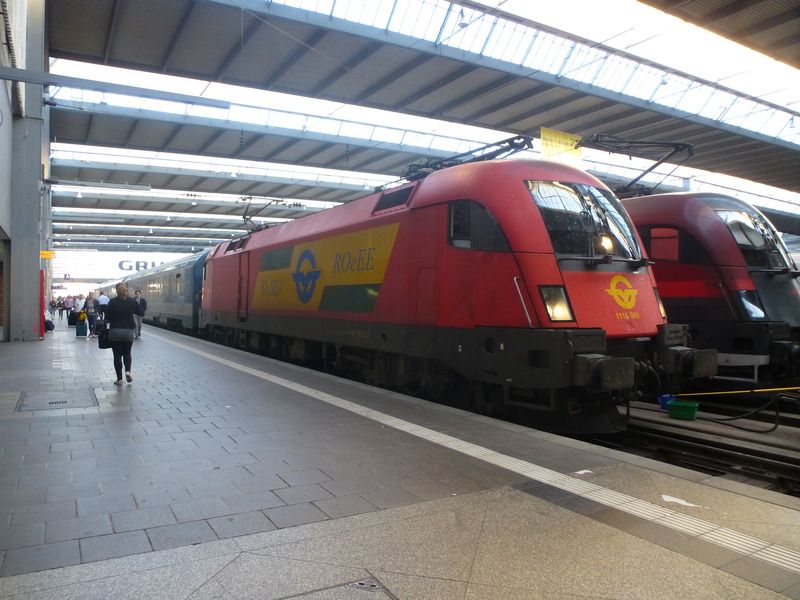
I bought some freshly squeezed orange juice (and tried not to focus on the fact that I paid less than that for whole meals in Bosnia) and wandered off to my platform. I saw an interesting demonstration of what happens to anyone who leaves their bag lying around on a German station – the unfortunate woman ended up surrounded by eight armed police officers. The station was very busy considering how early it was. But it was a public holiday in Bavaria and a lot of the passengers looked like they were making the best of their chance of a long weekend away. Awkwardly, although this Thursday was a holiday the Friday wasn’t so I suspect a lot of people were having to break into their annual holiday allowance.
Finally my train arrived and I took my seat for the journey of just over one hour to Nuremberg. When I had originally looked at booking trains the cost had been around 50 Euros. I had resigned myself to taking the much cheaper and slower bus. However when I went to book the bus I found that the ticket price had increased from 5 Euros to 13 so I went to look at the railway website again – and purchased a 19 Euro ticket.
The train journey began uneventfully. Then our ICE glided into a halt somewhere in the middle of nowhere. The conductor made an announcement, apparently there was a trespasser on the line. We got going again after five minutes or so and proceeded slowly to a station where we waited for 25 minutes. Nobody got off to smoke, sunbathe or drink coffee with the stationmaster. But there was an announcement to the effect of we don’t know what’s going on. Finally we got going again and the train quickly accelerated with a view to making up some time. Then the driver made an emergency stop – from high speed to stopped dead in less than 200 yards. Hear the brakes and feel the G’s. Wonder if we’ve collected the trespasser as a bonnet mascot. Apparently not though because we got going a couple of minutes later and arrived in Nuremberg without further incident.
I made my way through the deserted streets (had everyone in Nuremberg gone on holiday too?), checked into my hotel, showered, and took a desperately needed nap.
#12
Original Poster
Join Date: Jul 2011
Location: LHR- ish
Programs: MUCCI, BA Blue
Posts: 4,295
Nuremberg
My solo travelling days were over for now. It was time to join the Flyertalk crew for beer, wine, food and a bit of sightseeing. But that wasn’t until the evening and I needed some lunch. Having been out of Britain for nearly a week what I really wanted was a curry. I’d have settled for Chinese. But I certainly wasn’t about to eat any of that funny foreign food. Luckily I soon found a café with chicken tikka masala on the menu. It wasn’t quite the real stuff but it hit the spot.
Fortified I set off to renew acquaintances with Nuremberg. I was last here 18 months ago for Nuremberg Do 3 which focussed on the city’s famous Christmas market. I’d formed the impression that Nuremberg was a winter kind of place and was surprised to realise that it is very much a summer place. Snug restaurants spill out onto the pavements to bask in the sun. Gluhwein is forgotten as everywhere serves up ice cream. There’s even a beach.

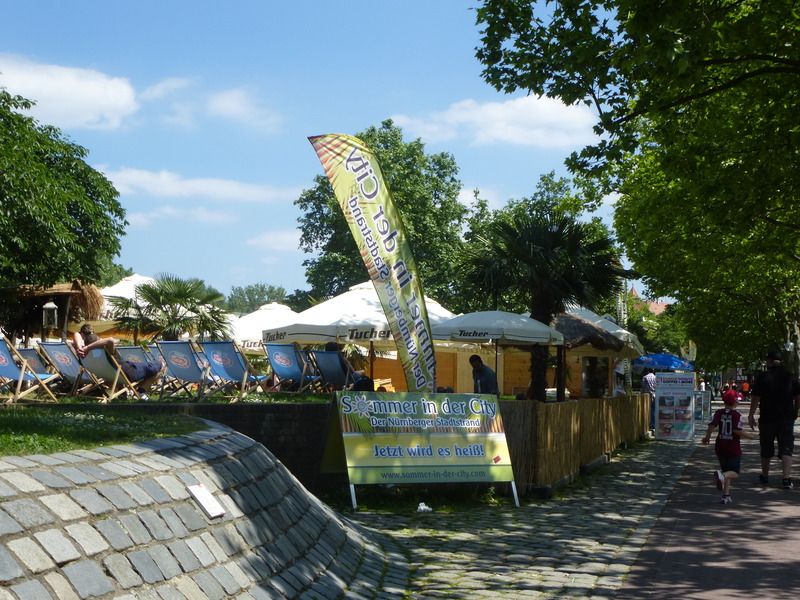
Fruit and veg
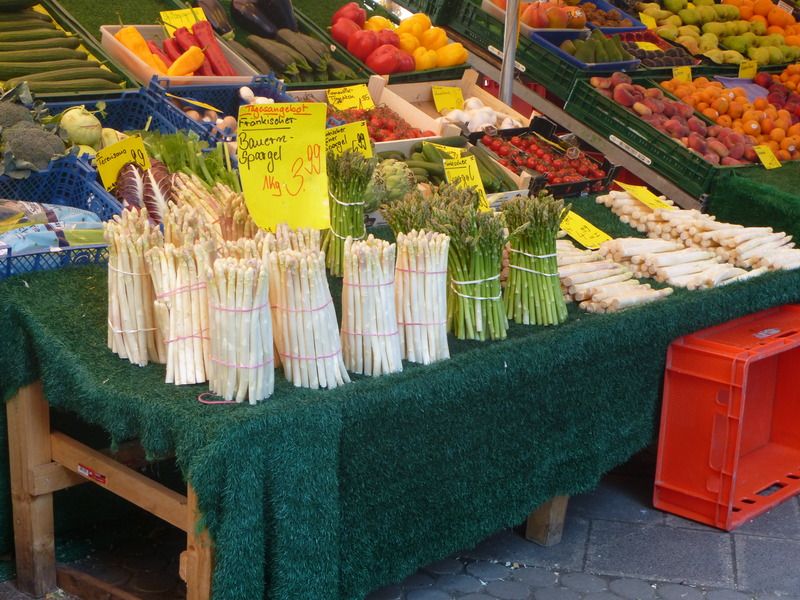
Truffles
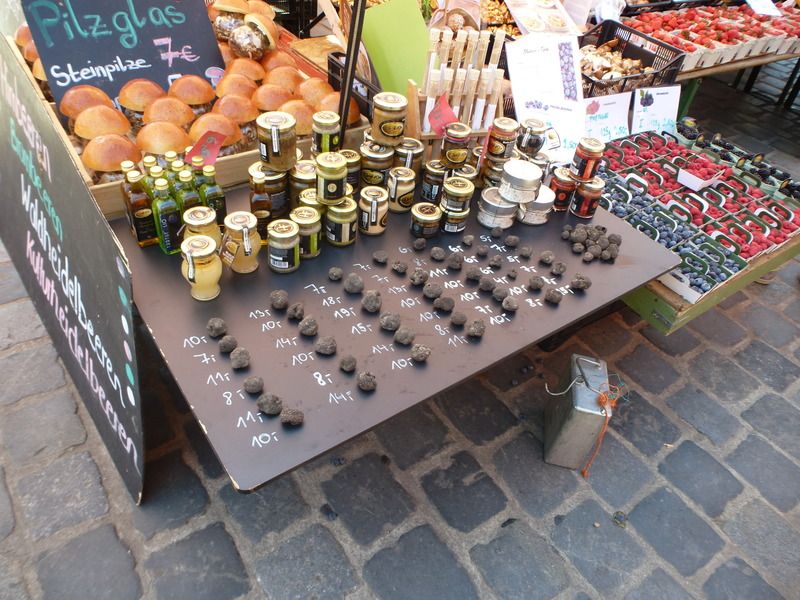
Some of the locals are a bit scary
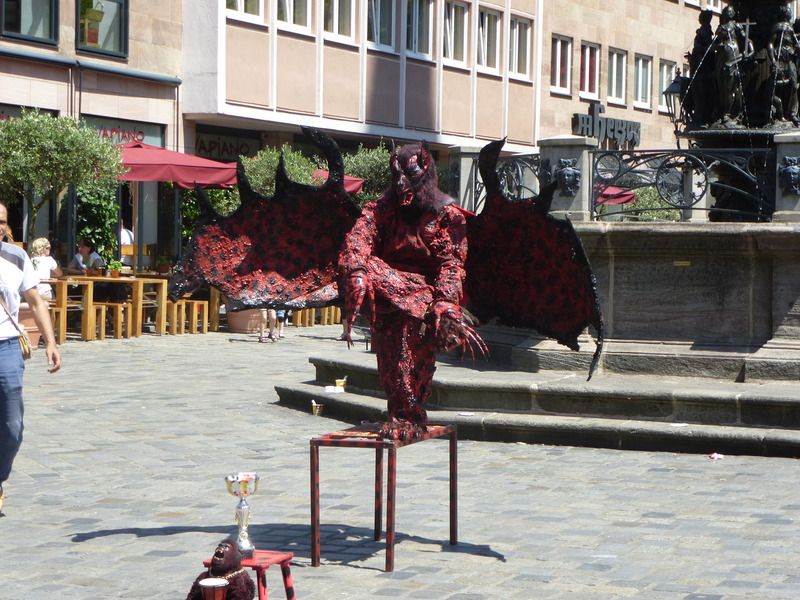
Perhaps because they have to share a post box with everyone else in town?
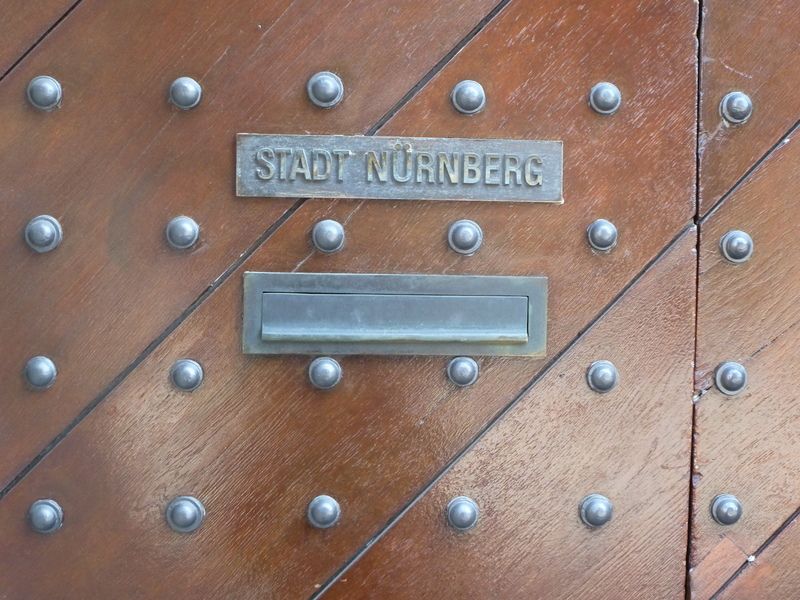
One of my favourite places in Nuremberg is the Lorenz Kirche, currently celebrating the anniversary of Martin Luther by displaying itself in historic state – without pews
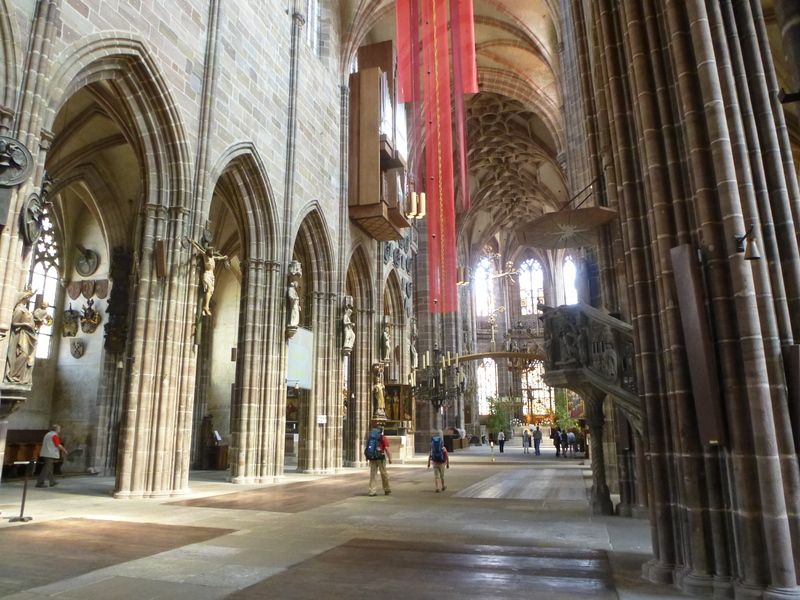
They have an interesting display about the church in the Second World War
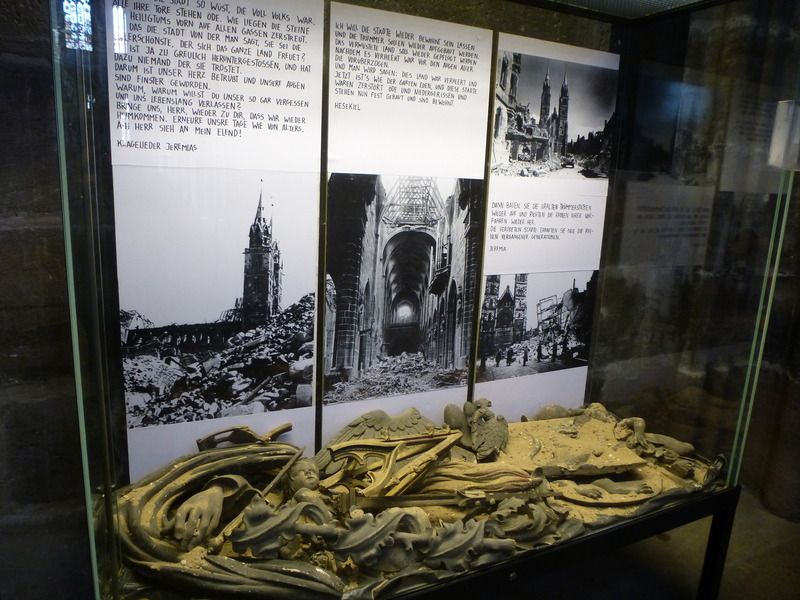
Since I had plenty of time I decided to go out for a look at the Nazi Party rally grounds which are 15 minutes or so by tram from the city centre. Nuremberg is a city that doesn’t so much wear its history as labour beneath its crushing weight. Its history as a medieval centre of arts and culture, vibrant market place, and pioneering railway town is altogether over-shadowed by its place in the Third Reich. The Nazi Party rally grounds were to have been the central theatre of the Third Reich, the place where its citizens came together to celebrate their physical, cultural and martial dominance. In addition to the Congress Hall there was to have been a massive parade ground and a 400,000 seater stadium. The Second World War halted construction but the Congress Hall was finished and today contains a museum documenting the Third Reich.
I arrived to find that the documentation centre was full of tour parties from river cruises and that the rally grounds were hosting a rock festival. Apparently their being used in this was is controversial, and I suppose it does distract from the solemnity of the place and what it stands for. However preserving the rally grounds must cost a great deal of money and that has to be raised somehow. Besides which, a rock festival sounds like something that the Nazis would definitely not have approved of. I contented myself with a walk around the outside of the Congress Hall; it is built on a massive scale which nicely encapsulates the Nazi regime’s complete disregard for individual humans.
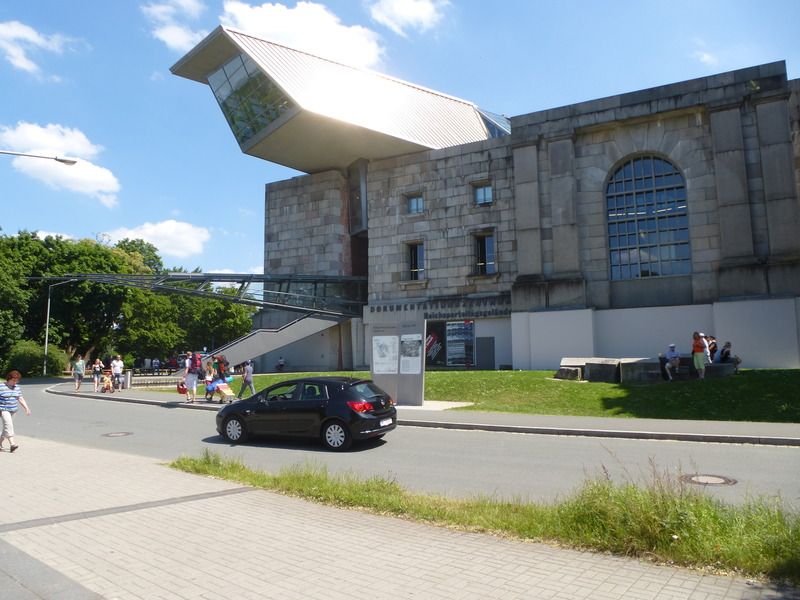

The Do began with a meeting at the bar in the Meridein Hotel. This started early, hardly surprising as a lot of people were looking forwards to renewing acquaintance with old friends. From here we moved on to Barfusser a combined brewery and restaurant which specialises in Franconian food – in other words large chunks of pig. The do-goers were split across two adjoining tables. One table decided to order several main courses to share. We decided to take on the challenge of Barfusser platters, several kilos of pig, chicken, duck and various forms of potato. Somebody had slipped a couple of lettuce leaves in there too. Despite our best efforts we could not finish The Food.
The following day was reserved for exploring Nuremberg, guided tours were on offer but I decided to strike out on my own. A couple of serial do-attenders headed off to Regensburg. I don’t really do guided tours, too much time looking at stuff other people are interested in and not enough time for things I’m interested in. I see huge groups wandering around like sheep and wonder how much they are really taking in. I also wonder what happens to anyone who loses touch with their group, it sounds like an excellent way to get Very Lost Indeed. So after a vegetarian breakfast I gathered up my map, Lonely Planet (yeah I know I’m just a sheep that can read) and camera, and headed for the Deutsche Bahn Museum. My route took me past the German National Museum and the way of human rights. Each of the columns on this route has one of the universal human rights inscribed on it in German and the language of a people who have had that right violated.
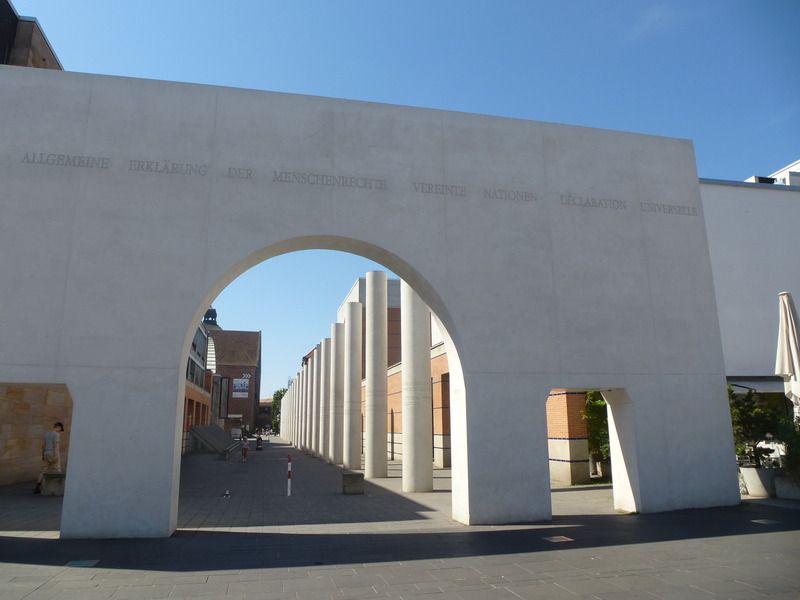
My route also took me past the Opera House U-Bahn station which is partly open to view. Nuremberg’s U-Bahn stations are highly individualistic; for instance Lorenzkirche reflects the ecclesiastical architecture above.
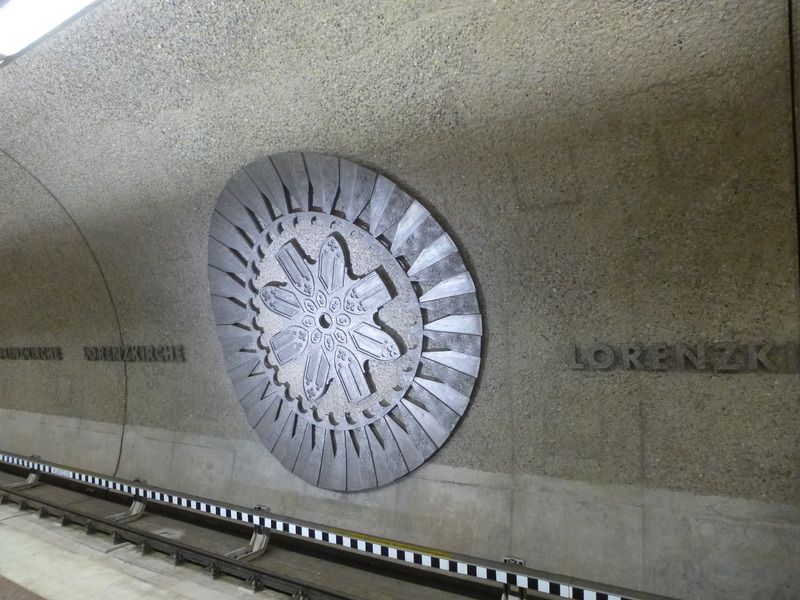
I also walked through a gate in the city wall which is largely intact although I suspect that, like much of Nuremberg, it required heavy restoration after the Second World War.
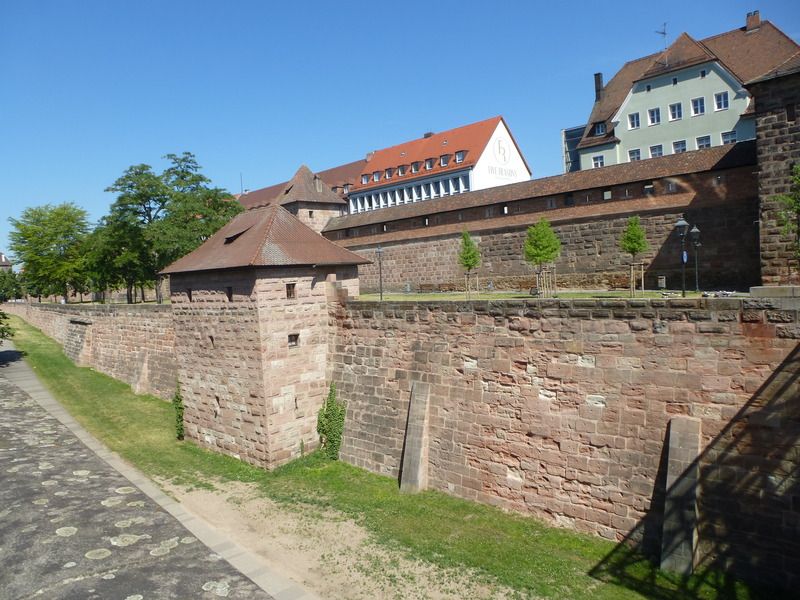
The Deutsche Bahn Museum was excellent. Highly recommended for anyone interested in railways, and for children of all ages. It begins with a audio-visual presentation about DB’s history which is very nicely done. Thereafter you progress through galleries discussing German railway history in chronological history. The railways came to Germany in 1835 when a line was built from Nuremberg to Furth. Displays discuss the development of the railways and their role in developing Germany. A large section is devoted to the railways at the time of the Third Reich. The story of the railways between 1945 and 1989 is told in galleries that are split – East Germany down one side and West Germany down the other. The final gallery discusses DB’s post-unification development. There is also a gallery devoted to model railways which contains everything from tiny Z gauge models to large engineering models.
Gate that formerly separated East and West Berlin at the Zoo U-bahn station
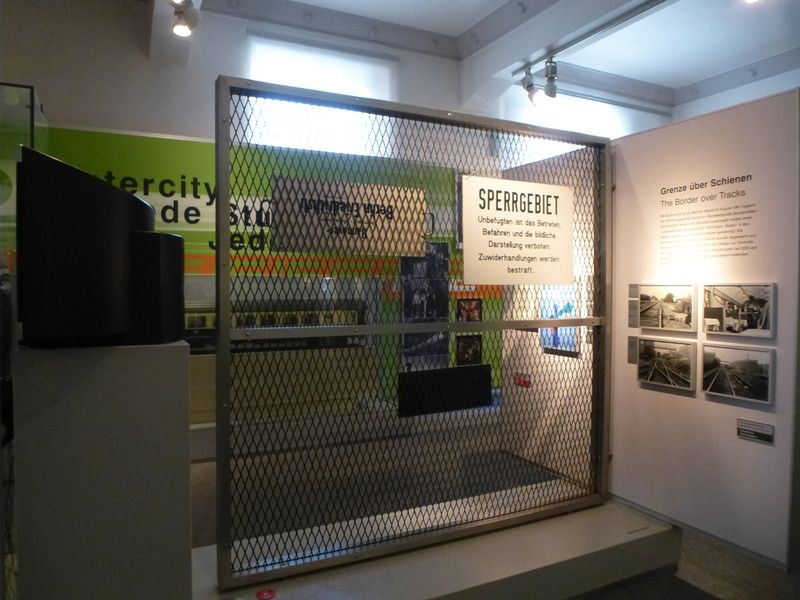
Modern gallery
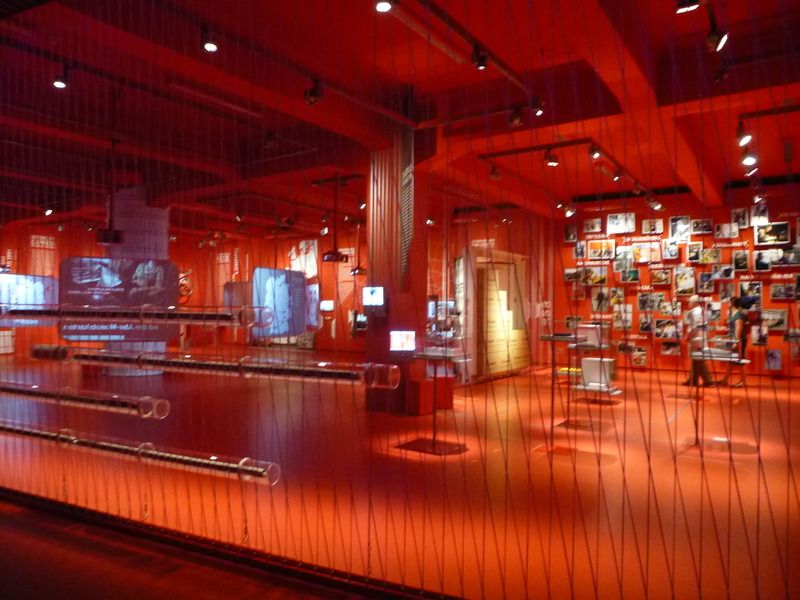
The stars of the exhibition are the trains themselves. A number of vintage carriages are on display including one Ludwig II had built to journey between his castles such as Neuschwanstein. Locomotives on display include Nordgau, Germany’s oldest preserved locomotive, Bavarian S 2/6, Germany’s fastest locomotive before World War One, 05001, classmate of 05002 the world’s second fastest ever steam locomotive and the Flying Hamburger – a diesel train which provided the world’s fastest scheduled rail service between Hamburg and Berlin in the 1930s. There is also an engineering prototype of the ICx, which will be the next generation of DB’s ICE high speed passenger trains. The museum is also home to a replica of Adler the locomotive bought from Britain to haul Germany’s first trains.
Wagon from the Stockton-Darlington Railway, one of the oldest preserved railway vehicles in the world
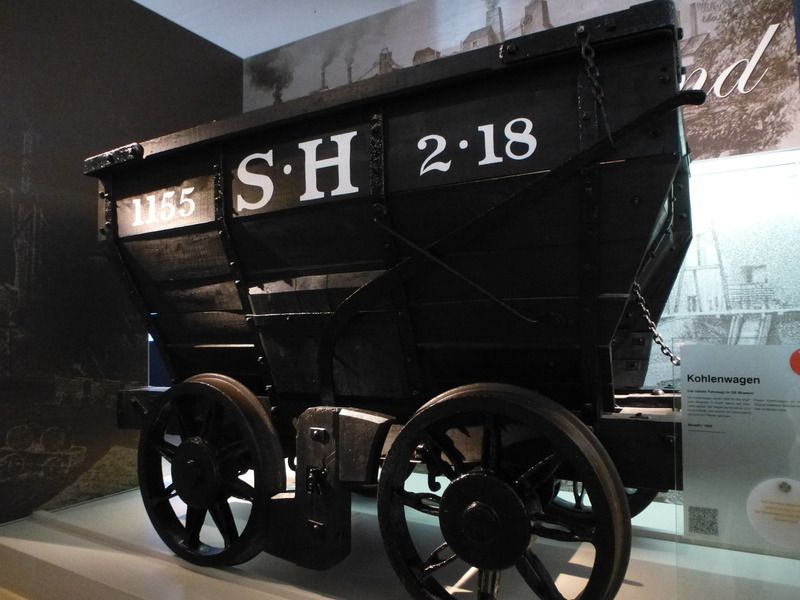
S 2/6

Nordgau
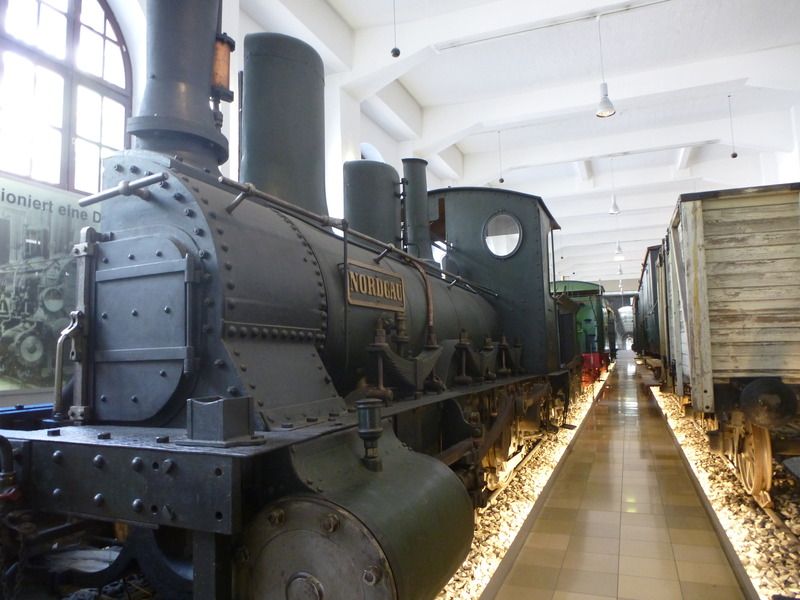
The first and the fastest – Adler and ICE 3 replicas stand next to each other
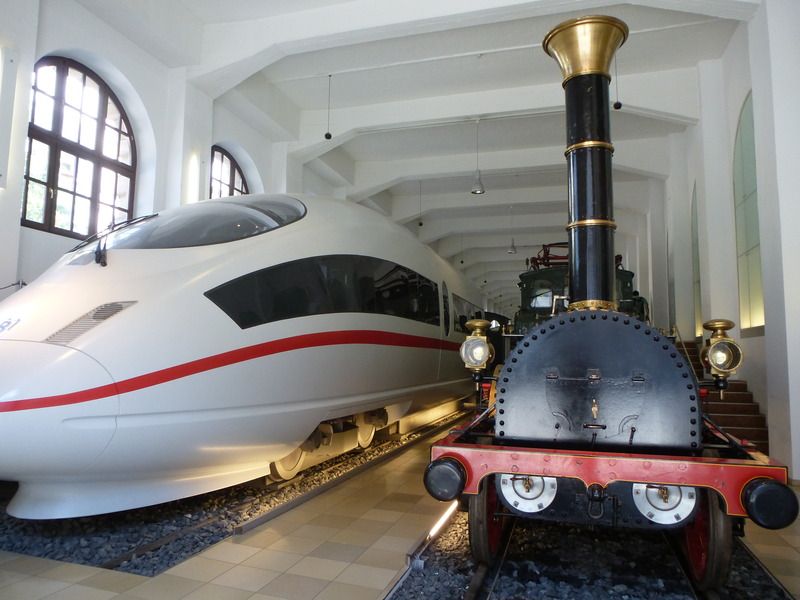
Part of the train exhibition area is outdoors
A current S-bahn train passes a preserved example
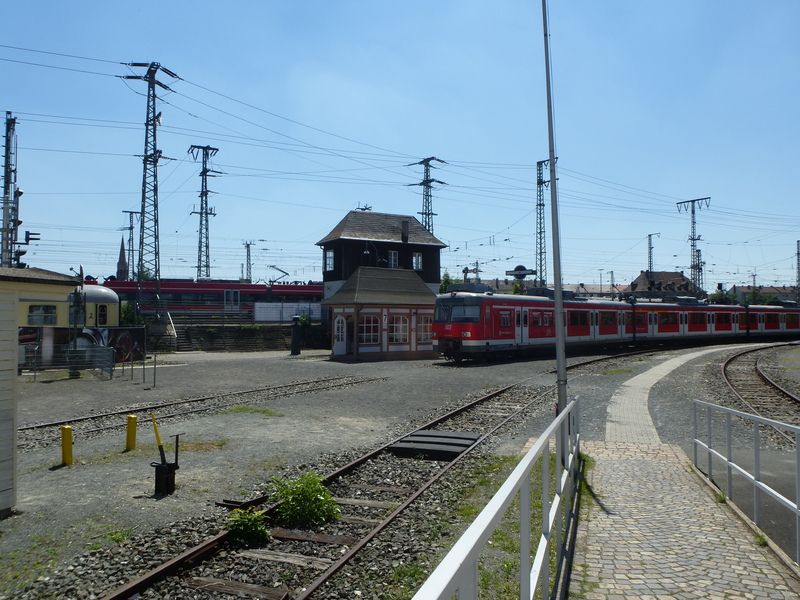
You can go in the old signal box
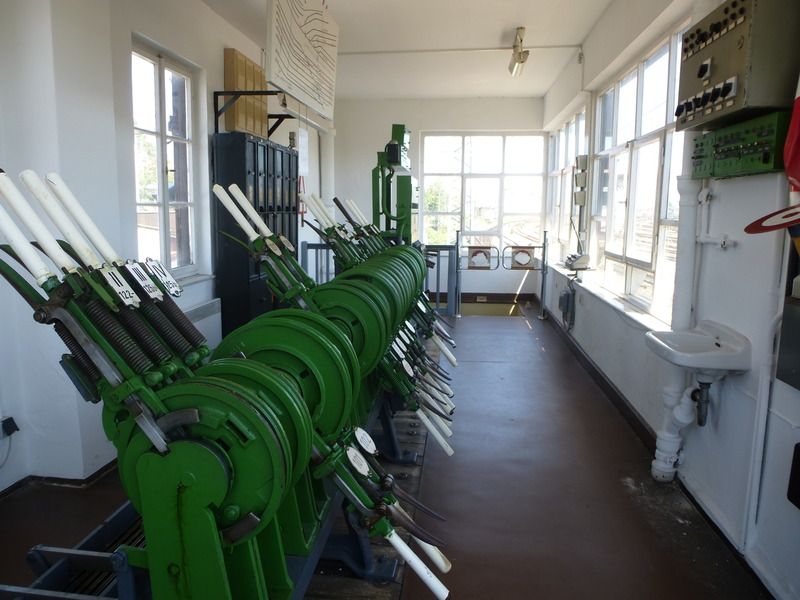
And watch trains
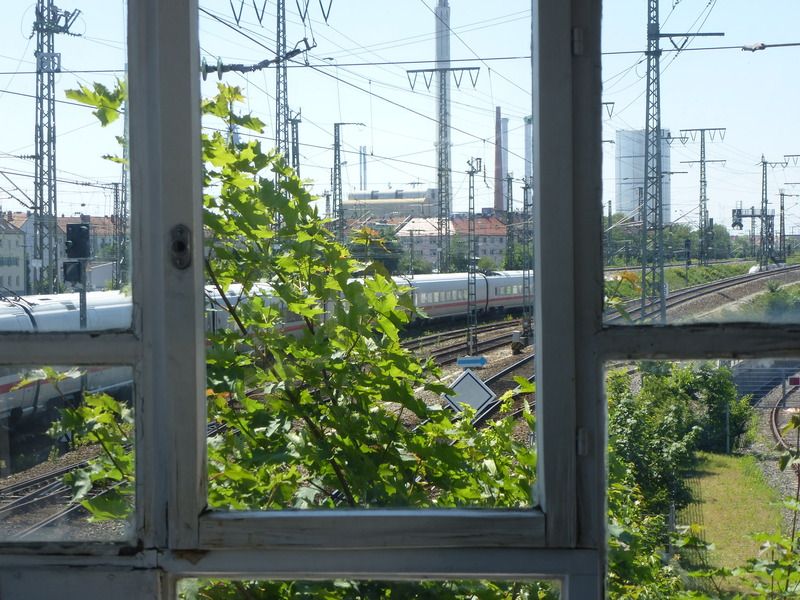
Having satisfied my inner geek I made my way back to the hotel, via the railway station where I picked up some noodles for lunch. I am worryingly fond of those station noodle stands. Once back at the hotel I washed my hair and got it fairly dry before going out again to see some more of Nuremberg and finish drying it. My first stop was the Rathaus (town hall) and the former prison underneath it. Most of the prisoners lived in total darkness, many were tortured to extract confessions, and a large number were ultimately executed.
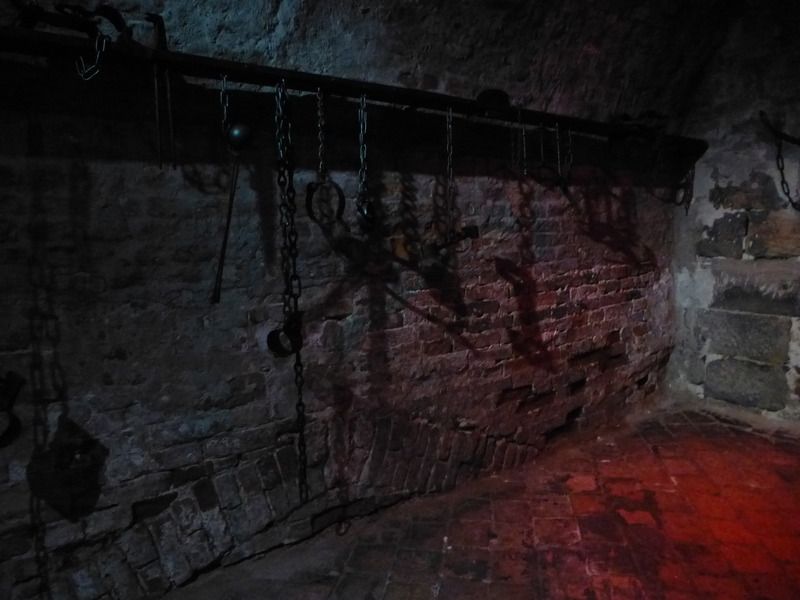
From there I wandered up to the castle. Last time I came this way there was snow on the ground and it was very cold indeed. Today the sun was shining and it was really too warm for comfort. I wandered around some streets near the castle which I’d missed before and also explored the garden and found a way onto the city wall. A beer festival was taking place in the moat but I gave it a miss- I don’t like beer.
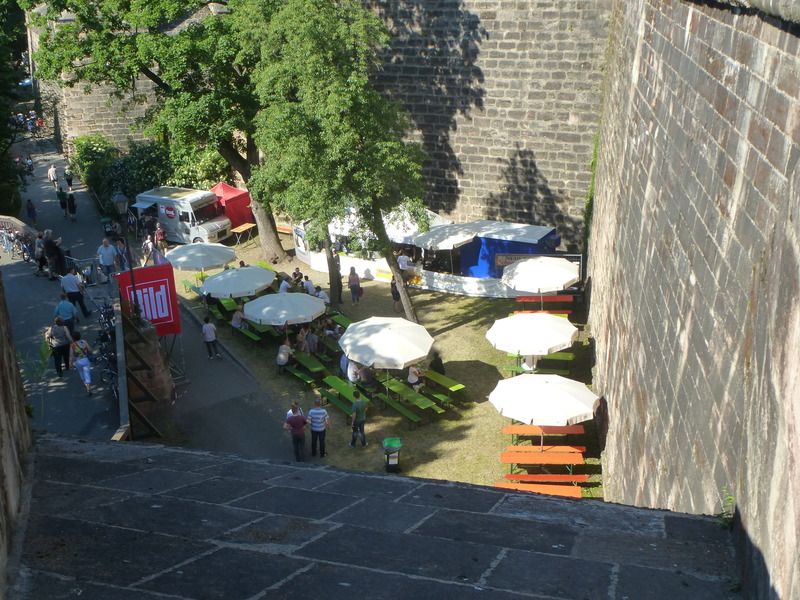
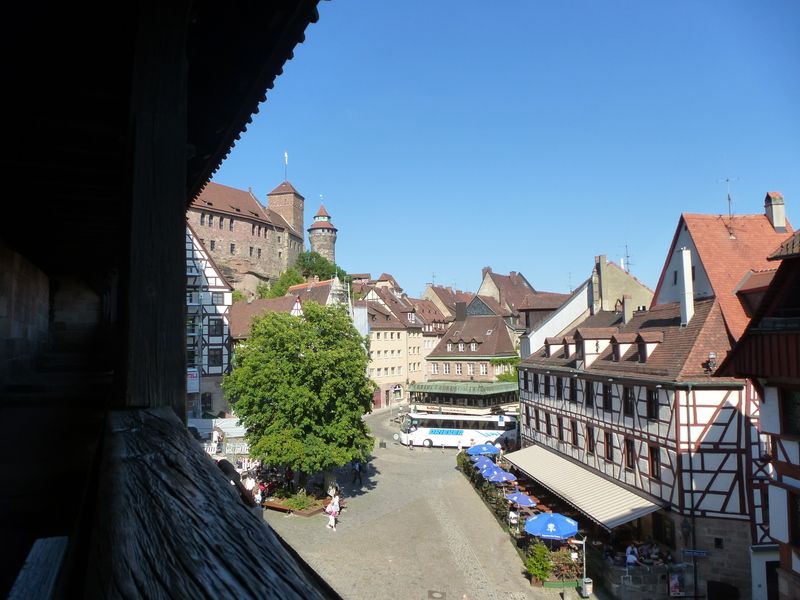
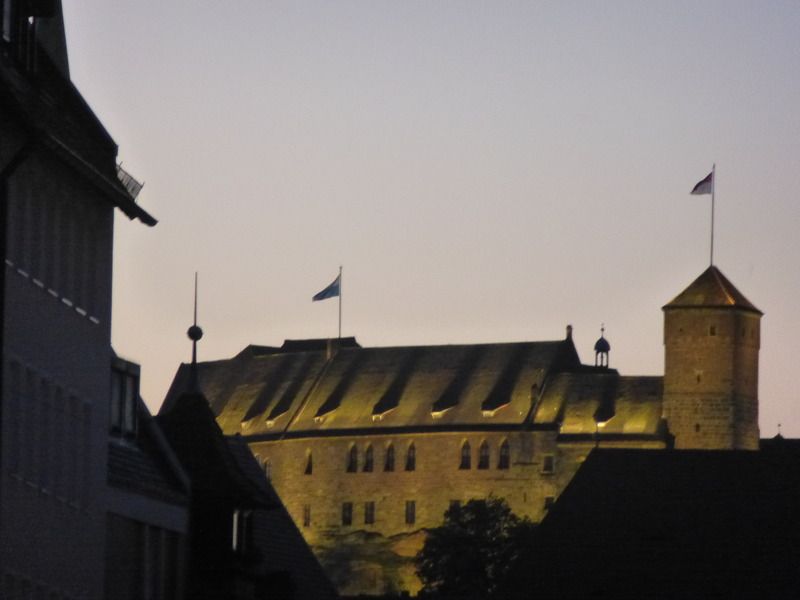
Our evening’s entertainment was a trip to the medieval banquet in the Alte Kuechn. It turned out to be about as Medieval as the Superbowl but it was great fun, at least for the German speakers amongst the party. I couldn’t keep up with a lot of it but I certainly learnt some interesting new German phrases, jokes, and songs. In keeping with the medieval theme we ate from wooden plates which were not changed between courses. Doughnut and sauerkraut anyone? Some of the FT crew had been to the beer festival and the restaurant was happy to keep the dark stuff flowing.
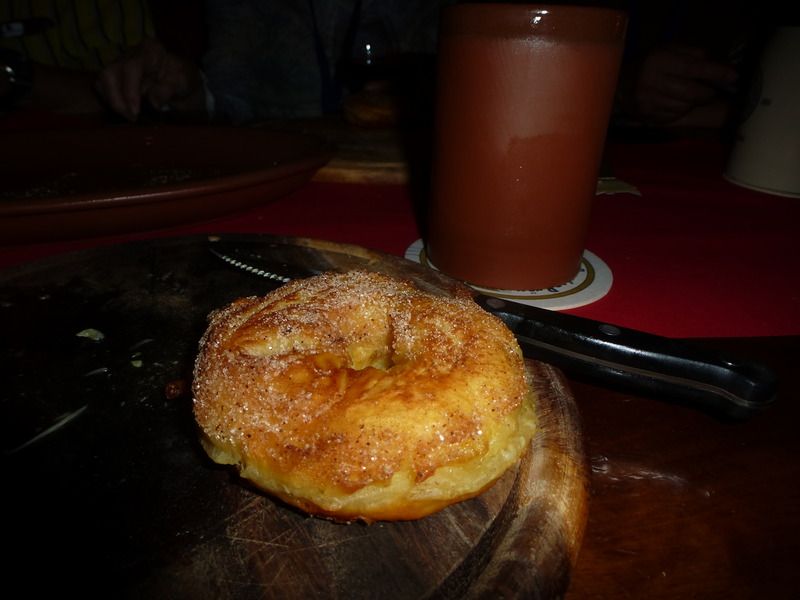
Just after I got back to my hotel I got a panicky phone call from my Mum who was wondering where I was and why I hadn’t been on the train I said I’d be on? Umm. .. Because I’m still Germany and will be for several days more. Don’t you ever check your email? Oh well, it was nice to hear from her.
Saturday was devoted to a trip to Wurzburg which will be the subject of my next post. But I think it is right to discuss the journey back to Nuremberg here. Somebody had the bright idea of buying a crate of beer (luckily for me they also got some schnapps filled chocolates). In a less tolerant country the subsequent party train would have become ‘that Do where we all got thrown off a train for drinking beer and singing’. As it was we were joined by a group of ladies selling small bottles of schnapps to fund their evening out. Did we ever establish whether or not they were a hen party? Happy to share the joy we gave our last chocolate to a woman sitting near us. She didn’t appreciate the alcoholic content, in fact she got off the train very quickly. Sorry!
The Do ended with dinner, beer and wine at the Marientorzwinger a restaurant/beer garden housed in the city wall. I said bye to all my FT buddies and wondered when I’d see them next. I made extra sure to thank F0zzyNUE for all his hard work in hosting this wonderful Do. I can’t wait for the next one!
My solo travelling days were over for now. It was time to join the Flyertalk crew for beer, wine, food and a bit of sightseeing. But that wasn’t until the evening and I needed some lunch. Having been out of Britain for nearly a week what I really wanted was a curry. I’d have settled for Chinese. But I certainly wasn’t about to eat any of that funny foreign food. Luckily I soon found a café with chicken tikka masala on the menu. It wasn’t quite the real stuff but it hit the spot.
Fortified I set off to renew acquaintances with Nuremberg. I was last here 18 months ago for Nuremberg Do 3 which focussed on the city’s famous Christmas market. I’d formed the impression that Nuremberg was a winter kind of place and was surprised to realise that it is very much a summer place. Snug restaurants spill out onto the pavements to bask in the sun. Gluhwein is forgotten as everywhere serves up ice cream. There’s even a beach.


Fruit and veg

Truffles

Some of the locals are a bit scary

Perhaps because they have to share a post box with everyone else in town?

One of my favourite places in Nuremberg is the Lorenz Kirche, currently celebrating the anniversary of Martin Luther by displaying itself in historic state – without pews

They have an interesting display about the church in the Second World War

Since I had plenty of time I decided to go out for a look at the Nazi Party rally grounds which are 15 minutes or so by tram from the city centre. Nuremberg is a city that doesn’t so much wear its history as labour beneath its crushing weight. Its history as a medieval centre of arts and culture, vibrant market place, and pioneering railway town is altogether over-shadowed by its place in the Third Reich. The Nazi Party rally grounds were to have been the central theatre of the Third Reich, the place where its citizens came together to celebrate their physical, cultural and martial dominance. In addition to the Congress Hall there was to have been a massive parade ground and a 400,000 seater stadium. The Second World War halted construction but the Congress Hall was finished and today contains a museum documenting the Third Reich.
I arrived to find that the documentation centre was full of tour parties from river cruises and that the rally grounds were hosting a rock festival. Apparently their being used in this was is controversial, and I suppose it does distract from the solemnity of the place and what it stands for. However preserving the rally grounds must cost a great deal of money and that has to be raised somehow. Besides which, a rock festival sounds like something that the Nazis would definitely not have approved of. I contented myself with a walk around the outside of the Congress Hall; it is built on a massive scale which nicely encapsulates the Nazi regime’s complete disregard for individual humans.


The Do began with a meeting at the bar in the Meridein Hotel. This started early, hardly surprising as a lot of people were looking forwards to renewing acquaintance with old friends. From here we moved on to Barfusser a combined brewery and restaurant which specialises in Franconian food – in other words large chunks of pig. The do-goers were split across two adjoining tables. One table decided to order several main courses to share. We decided to take on the challenge of Barfusser platters, several kilos of pig, chicken, duck and various forms of potato. Somebody had slipped a couple of lettuce leaves in there too. Despite our best efforts we could not finish The Food.
The following day was reserved for exploring Nuremberg, guided tours were on offer but I decided to strike out on my own. A couple of serial do-attenders headed off to Regensburg. I don’t really do guided tours, too much time looking at stuff other people are interested in and not enough time for things I’m interested in. I see huge groups wandering around like sheep and wonder how much they are really taking in. I also wonder what happens to anyone who loses touch with their group, it sounds like an excellent way to get Very Lost Indeed. So after a vegetarian breakfast I gathered up my map, Lonely Planet (yeah I know I’m just a sheep that can read) and camera, and headed for the Deutsche Bahn Museum. My route took me past the German National Museum and the way of human rights. Each of the columns on this route has one of the universal human rights inscribed on it in German and the language of a people who have had that right violated.

My route also took me past the Opera House U-Bahn station which is partly open to view. Nuremberg’s U-Bahn stations are highly individualistic; for instance Lorenzkirche reflects the ecclesiastical architecture above.

I also walked through a gate in the city wall which is largely intact although I suspect that, like much of Nuremberg, it required heavy restoration after the Second World War.

The Deutsche Bahn Museum was excellent. Highly recommended for anyone interested in railways, and for children of all ages. It begins with a audio-visual presentation about DB’s history which is very nicely done. Thereafter you progress through galleries discussing German railway history in chronological history. The railways came to Germany in 1835 when a line was built from Nuremberg to Furth. Displays discuss the development of the railways and their role in developing Germany. A large section is devoted to the railways at the time of the Third Reich. The story of the railways between 1945 and 1989 is told in galleries that are split – East Germany down one side and West Germany down the other. The final gallery discusses DB’s post-unification development. There is also a gallery devoted to model railways which contains everything from tiny Z gauge models to large engineering models.
Gate that formerly separated East and West Berlin at the Zoo U-bahn station

Modern gallery

The stars of the exhibition are the trains themselves. A number of vintage carriages are on display including one Ludwig II had built to journey between his castles such as Neuschwanstein. Locomotives on display include Nordgau, Germany’s oldest preserved locomotive, Bavarian S 2/6, Germany’s fastest locomotive before World War One, 05001, classmate of 05002 the world’s second fastest ever steam locomotive and the Flying Hamburger – a diesel train which provided the world’s fastest scheduled rail service between Hamburg and Berlin in the 1930s. There is also an engineering prototype of the ICx, which will be the next generation of DB’s ICE high speed passenger trains. The museum is also home to a replica of Adler the locomotive bought from Britain to haul Germany’s first trains.
Wagon from the Stockton-Darlington Railway, one of the oldest preserved railway vehicles in the world

S 2/6

Nordgau

The first and the fastest – Adler and ICE 3 replicas stand next to each other

Part of the train exhibition area is outdoors
A current S-bahn train passes a preserved example

You can go in the old signal box

And watch trains

Having satisfied my inner geek I made my way back to the hotel, via the railway station where I picked up some noodles for lunch. I am worryingly fond of those station noodle stands. Once back at the hotel I washed my hair and got it fairly dry before going out again to see some more of Nuremberg and finish drying it. My first stop was the Rathaus (town hall) and the former prison underneath it. Most of the prisoners lived in total darkness, many were tortured to extract confessions, and a large number were ultimately executed.

From there I wandered up to the castle. Last time I came this way there was snow on the ground and it was very cold indeed. Today the sun was shining and it was really too warm for comfort. I wandered around some streets near the castle which I’d missed before and also explored the garden and found a way onto the city wall. A beer festival was taking place in the moat but I gave it a miss- I don’t like beer.



Our evening’s entertainment was a trip to the medieval banquet in the Alte Kuechn. It turned out to be about as Medieval as the Superbowl but it was great fun, at least for the German speakers amongst the party. I couldn’t keep up with a lot of it but I certainly learnt some interesting new German phrases, jokes, and songs. In keeping with the medieval theme we ate from wooden plates which were not changed between courses. Doughnut and sauerkraut anyone? Some of the FT crew had been to the beer festival and the restaurant was happy to keep the dark stuff flowing.

Just after I got back to my hotel I got a panicky phone call from my Mum who was wondering where I was and why I hadn’t been on the train I said I’d be on? Umm. .. Because I’m still Germany and will be for several days more. Don’t you ever check your email? Oh well, it was nice to hear from her.
Saturday was devoted to a trip to Wurzburg which will be the subject of my next post. But I think it is right to discuss the journey back to Nuremberg here. Somebody had the bright idea of buying a crate of beer (luckily for me they also got some schnapps filled chocolates). In a less tolerant country the subsequent party train would have become ‘that Do where we all got thrown off a train for drinking beer and singing’. As it was we were joined by a group of ladies selling small bottles of schnapps to fund their evening out. Did we ever establish whether or not they were a hen party? Happy to share the joy we gave our last chocolate to a woman sitting near us. She didn’t appreciate the alcoholic content, in fact she got off the train very quickly. Sorry!
The Do ended with dinner, beer and wine at the Marientorzwinger a restaurant/beer garden housed in the city wall. I said bye to all my FT buddies and wondered when I’d see them next. I made extra sure to thank F0zzyNUE for all his hard work in hosting this wonderful Do. I can’t wait for the next one!
#14
Join Date: Jun 2011
Location: CGN
Programs: A* Gold, OW Sapphire, Thalys Platinum, Accor Gold, member of BahnBonus
Posts: 210
Nice report with a lot of my other favourite form of transportation: Trains!
And I am glad, your CGN experience was not bad, although ...
You clearly were in a wrong restaurant. 
And I am glad, your CGN experience was not bad, although ...

#15
Original Poster
Join Date: Jul 2011
Location: LHR- ish
Programs: MUCCI, BA Blue
Posts: 4,295
Thanks Askartus and you might be right - I got the impression the asparagus had been over-cooked.
A daytrip to Wurzburg
It was the morning after the night before but the Flyertalk crew was all present for our train to Wurzburg. To say we were all present and correct would have been pushing it, as one or two of our number were certainly feeling the effects. Being nice people we kept our laughter down to a low volume to minimise its impact on aching heads. On arrival in Wurzburg we met the first of our three guides who was going to lead a city tour. A couple of us opted out of this tour, in my case because I’d rather explore on my own. Apparently it was quite a good tour, casual racism aside (said casual racism being aimed at people who weren’t actually the nationality they were assumed to be).
My first stop was the area around the Marien Kirche which is a market place and houses many restaurants which were busily promoting local wine and produce (Wurzburg offers an erdbeerzeit (strawberry time) to go with the aforementioned spargelzeit. Unusually, some of the shops in this area are built onto the walls of the church. From the market I walked to the Rathaus, a relatively plain example but housing the near ubiquitous restaurant – is there some kind of law requiring German towns to convert their town hall basement into a restaurant?
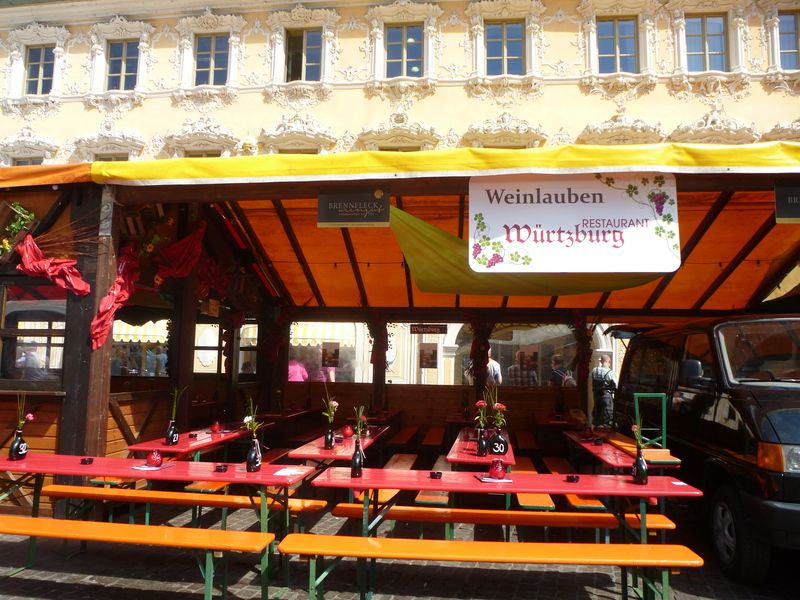
From here I walked on to the old Rhine Bridge which is decorated with statues and very beautiful indeed. It offers splendid views, including of the Marienburg Festung (fortress) on the far side of the river. The fortress housed the city’s ruling prince bishops from 1201 to 1719 when they decided it was safe to move into town and build a blingy new palace (of which more later). Many of the city’s vineyards can be seen from the bridge, including the one situated on the slopes below the fortress.

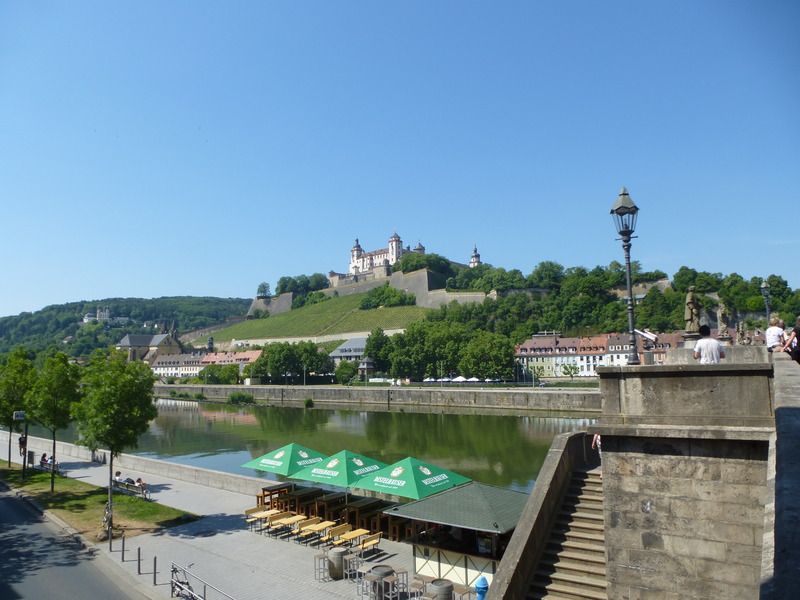
Back in the Rathaus square, a fruit and veg market was taking place. I bought some raspberries and scoffed them down. Very nice indeed. I also took this picture of St Killian’s Cathedral
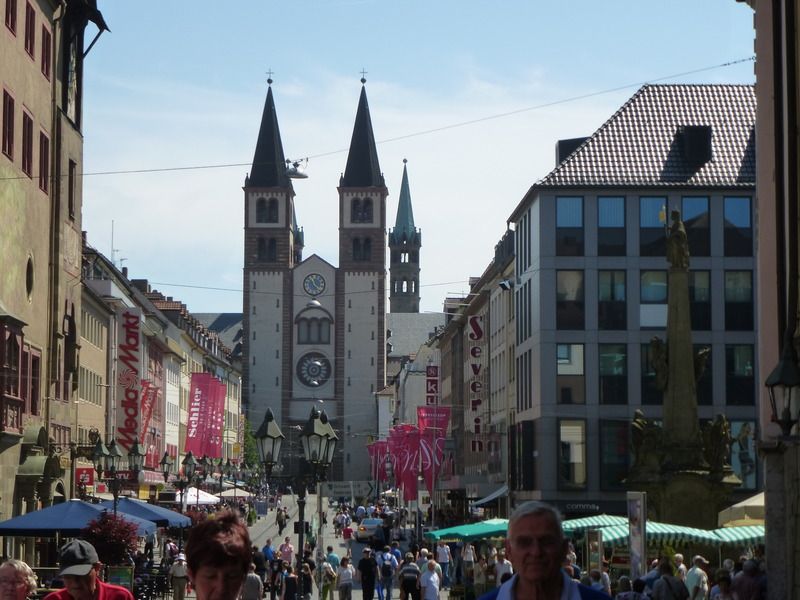
The Rathaus Platz also houses a small museum devoted to Wurzburg’s experiences before, during, and after the Second World War. Un-touched for most of the war, Wurzburg was the unfortunate victim of a near ‘perfect’ raid by the RAF on 16 March 1945 which destroyed 80% of the buildings and killed 5000 people. The damage was so bad that it was suggested the city should be abandoned as a testament and memorial to the horrors of war. The museum has a model of the ruined city which demonstrates the depth of the destruction and prompts admiration of the skill and effort which subsequently went into reconstruction.

With another German meal coming up for dinner I opted for a Chinese buffet lunch which was of acceptable quality and fair price. After lunch I made my lazy way to the Residenz where I would be meeting the rest of the group. My route took me past the old university, still in use as a place of learning, and through the gardens of the Residenz. It was a blazing hot day by now and so it was nice to stroll through the gardens and rest under the trees. The formal gardens are beautifully laid out and maintained but the less formal wooded area was far more suited to my needs on this day.
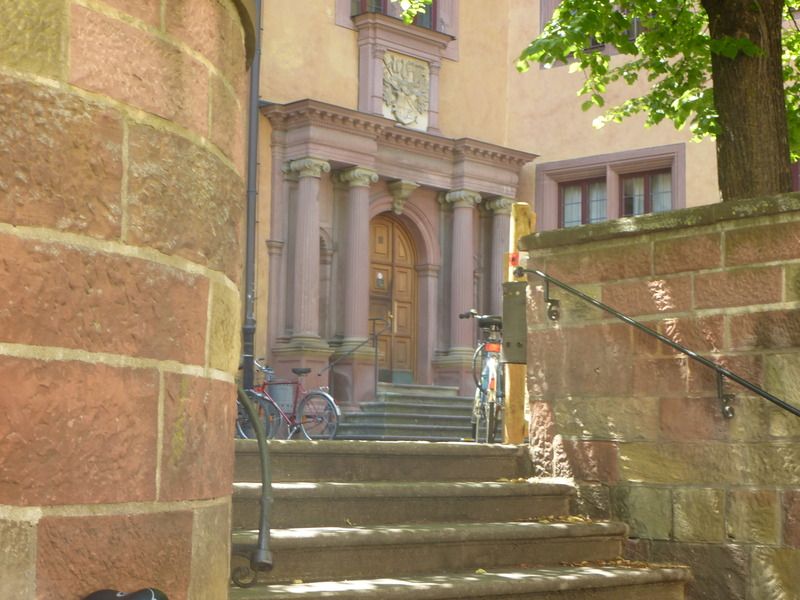
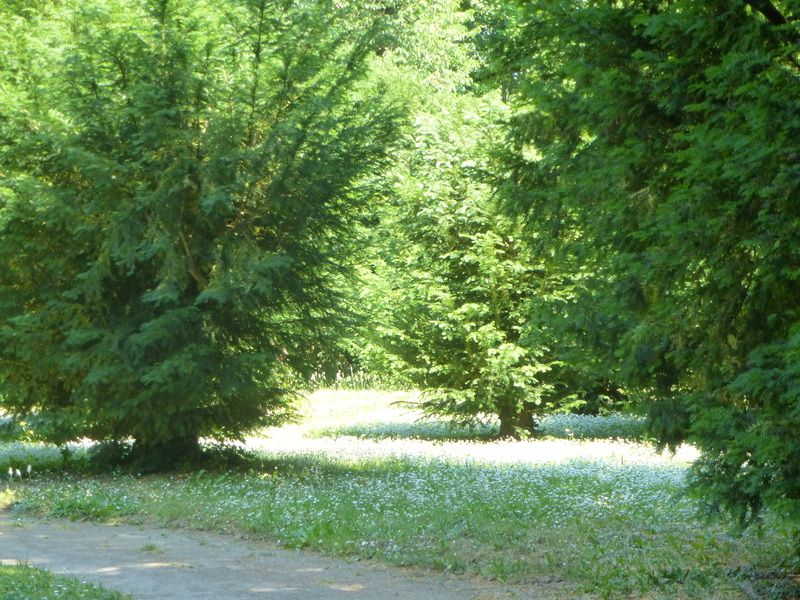
I met the rest of the FT crew by the Franconian fountain in the Residenz courtyard. The Residenz was built in the 18th century as a statement to the power, wealth and security of the city’s ruling prince-bishops. Nowadays it is open to the public but only by way of guided tours. You have to leave your bags in a cloakroom area and are not supposed to take photos or touch anything except the modern furniture. The highlight is the world’s largest fresco, painted by Tiepolo and sons and covering a 667 square meter ceiling over the grand staircase. It is genuinely extremely impressive but our guide spent 40 minutes explaining it which was really far too long. I think she was under the mistaken impression that she was dealing with a bunch of art and architecture buffs.
Having lost interest, some of us amused ourselves by sneaking up on naughty flyertalkers who were leaning on walls or balustrades and poking them. A certain person set a very bad example by sneakily taking a series of selfies. Eventually our guided moved onto the other rooms in the Residenz where the pressure of following groups thankfully restricted her to three minutes talking about each room. Actually many of these rooms were extremely beautiful and interesting and a couple of extra minutes in them wouldn’t have been a bad thing.
Franconian Fountain
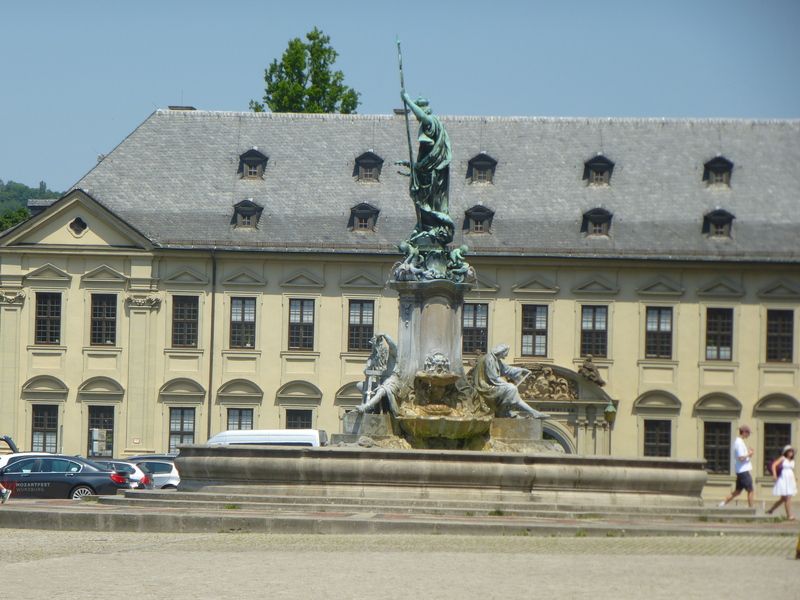
Released back out into the sunshine we all found ourselves in need of restorative water/beer/ice cream or some combination there off. We wandered off in various directions and met with varying success. Some of the group went to the Residenz’s customer café where the service was appalling. I found myself in a small group at an eis café (ice cream café) where the service was excellent. Well I would say that being as our server neglected to charge me anything, despite the fact that I was sitting with money in my hand looking at her expectantly.
Our final stop was a tour of the wine cellar located under the Residenz. Nowadays these historic cellars are not used for wine production but they are still at the centre of wine-making operations, being used for tastings, parties and anything that requires a sense of tradition. They are also blissfully cool and very interesting. In this case our guide had judged her audience correctly and stirred feelings of envy by telling us how the city officials used to be partly paid in wine.
She also told us the story behind the city’s flat round wine bottles (which would be more or less unique if Mateus Rose hadn’t copied them). The boring version of this story is that the shape was copied from the skin bottles used to hold wine before the development of glass.
The more exciting version is that the vineyards were started by the Abbott of a local monastery who made a deal with the devil – if the vineyards became established and worked perfectly for twenty years the devil could then have the Abbott’s soul. The devil provided twenty years of perfect weather, suitable insects and ideal soil. When he came for the Abbott’s soul the Abbott persuaded him to try some of the perfect wine they had made together. The Abbott then got the devil so drunk that he fell down in a stupor. The Abbott then cut the devil’s testicles off, filled them with wine for sustenance, and ran away never to be seen again. Prost!
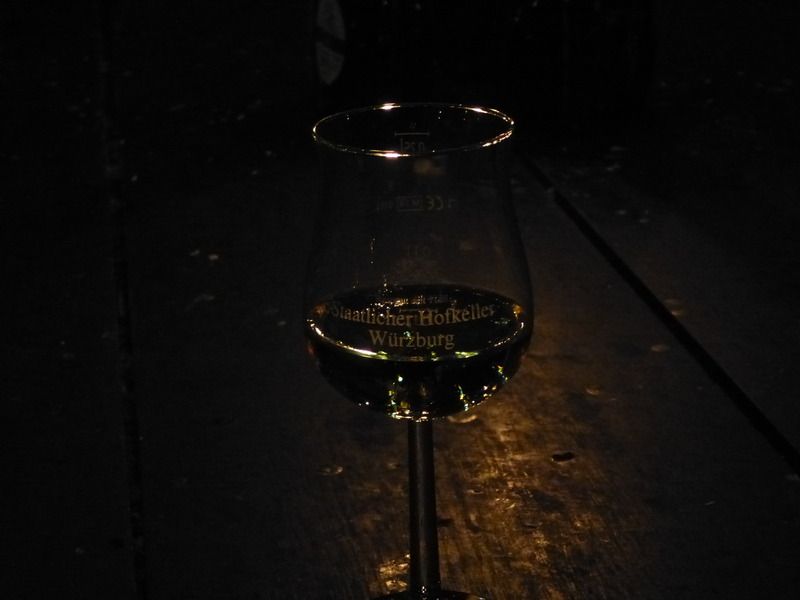
We made our way back to the station and the party train home, but not before stopping at a local hostelry to air our newly acquired wine knowledge and sample some more local wines. Thoroughly recommended.




















